J & J LUBRANO MUSIC ANTIQUARIANS
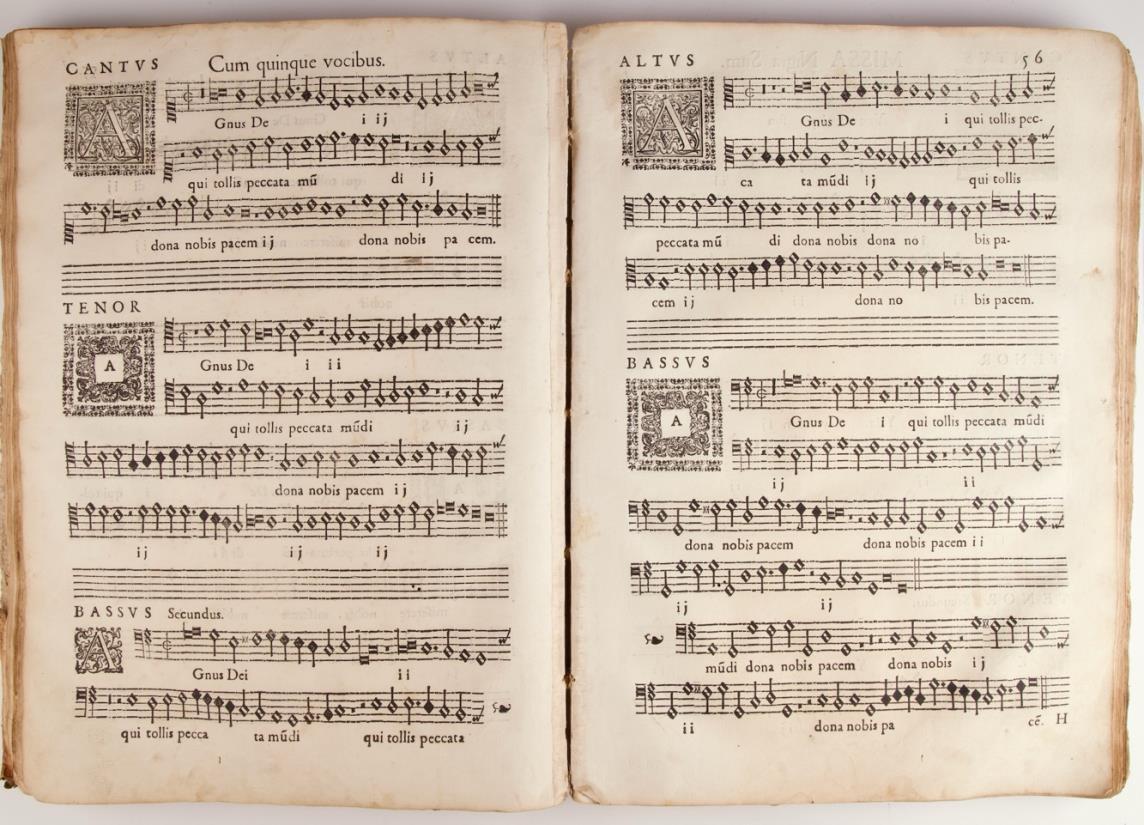
CONDITIONS OF SALE
All items are in good antiquarian condition unless otherwise noted and are offered subject to prior sale, with prices net and subject to change without notice. The costs of shipping and insurance are additional Orders are customarily shipped via USPS Priority Mail or Federal Express. Sales tax will be added to the invoices of NewYork State residents.
Orders may be placed by e-mail (info@lubranomusic.com), telephone (516-922-2192), or on our secure website (www.lubranomusic.com) by entering the ID number of the desired item in the SEARCH box at the upper right of our homepage.We ask that you kindly wait to receive ourinvoice to ensure availability before remitting payment. Libraries may receive deferred billing upon request.
We accept payment by:
-ACH (Automated Clearing House), inclusive of all bank charges
- EFT (Electronic Funds Transfer), inclusive of all bank charges
- PayPal to info@lubranomusic.com
- Checks in U.S. dollars drawn on a U.S. bank
- International money order
- Credit card
We fully guarantee that all items offered for sale by J & J LubranoMusicAntiquarians LLC are absolutely authentic without time limitation to the original purchaser provided that said items conform exactly to our description as supplied at time of purchase.All items remain the property of J & J Lubrano MusicAntiquarians LLC until paid for in full.
Please visit our website at
www.lubranomusic.com
where you will find full descriptions and illustrations of our catalogued inventory
Members
Antiquarian Booksellers’Association ofAmerica
International League ofAntiquarian Booksellers
ProfessionalAutograph Dealers’Association
Music LibraryAssociation
American Musicological Society
Dance StudiesAssociation &c.
Cataloguers
John Lubrano, Jude Lubrano, Benjamin Katz
© J & J Lubrano MusicAntiquarians LLC October 2025
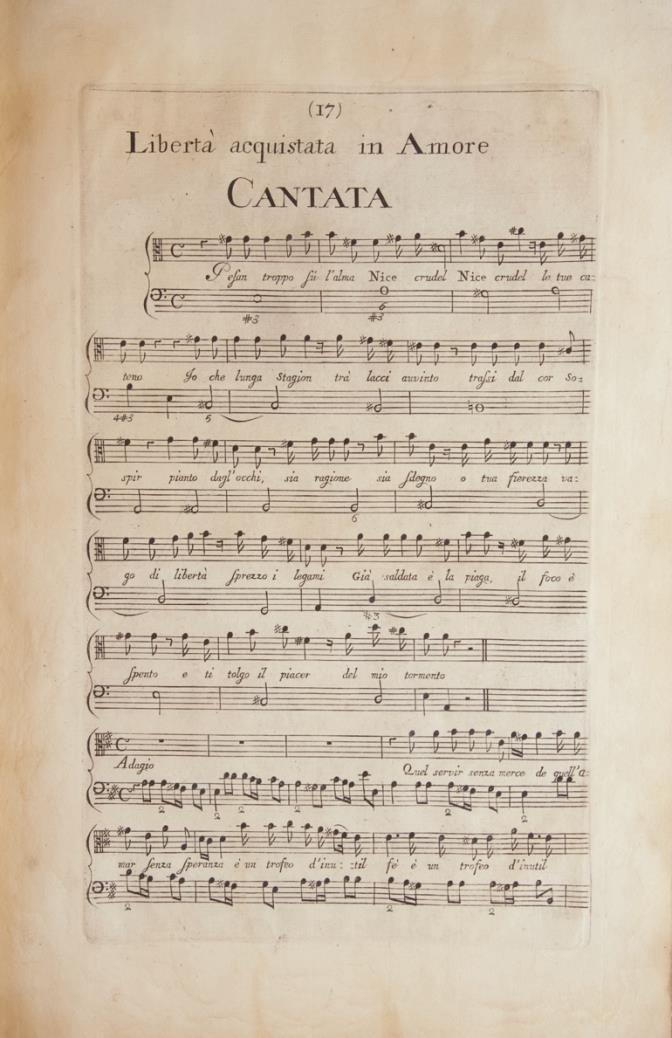
With Possibly the Most Extensive Pre-1800 List of Subscribers
1. ARIOSTI, Attilio 1666-1729
[Six Cantatas and six lessons for viola d’amore. Alla Maesta di Giorgio Re della Gran Britagna &c: &c:].
[London]: n.p., [1724].
Folio. Disbound. 1f. (recto dedication to Principe di Galles, Principessa di Galles, Principe Federigo, Principessa Anna, Principessa Amelia, Principessa Charlotta, verso blank), 1f. (composer's dedication signed A. A.), 12 pp. ("A List of the Subscribers"), 6ff. (text of cantatas), 47 pp. (pp. 1-33 cantatas in score, pp. 34-47 lessons for the viola d'amore and unfigured basso continuo), [i] (blank), 1f. (letter), 1f. (recto "Al Lettore," verso blank), 1f. ("Avvertimenti"), [i] (guide to scordatura tunings), [i] (blank) pp. With textinletterpressandmusicengravedthroughout. Highly decorative woodcut head- and tailpieces.
Contains 6 cantatas: La rosa, L'amore onesta, L'olmo, Liberta acquistata in amore, Naufragio vicino, and La gelosia, for voice, viola d'amore and figured bass. With an appendix introducing violinists to the viola d'amore and a table of tunings. Small slips of printed paper laid down to pp. 3 and 11 of list of subscribers, adding "Lady Frances Clifton" and "Lord Fitz Williams, Subscriber to the Royal Academy." Uniform moderate browning; soiling and stains to most leaves; lower outer corners creased, with minor loss to first leaf; minor edge tears. Lacking title.
First Edition. BUC p. 1. RISM A1420.
"Pressed by the necessity which followed from his want of encouragement, [Ariosti] not so properly solicited as begged, a subscription from the nobility and gentry to a book of Cantatas, in which he purposed to display the utmost of his abilities. ... He enrolled the name of the person applied to in his list of subscribers. ... The compositions of both kinds contained in it abound with evidences of a fertile invention, and great skill in the art of modulation and the principles of harmony." Hawkins II, p. 867.
"Ariosti's first appearance in London was on 12 July 1716, when he played his ‘New Symphony … upon a New Instrument call'd Viola D'Amour’ between acts of Handel's Amadigi. ... In 1723–4 Ariosti was at the height of his popularity in London, and he took advantage of it by publishing a collection of six cantatas and six lessons for the viola d'amore, dedicated to George I (brother of his former patron Sophie Charlotte). Even though the cost was ‘a fiendish two guineas’ per volume, there were 764 subscribers, including 42 dukes and duchesses, 105 earls and countesses and 146 other lords and ladies. 133 of them were subscribers to the Royal Academy, presumably for the 1723–4 season. All the pieces in the volume are clearly Baroque rather than pre-Classical in texture, and they ‘abound with evidences of a fertile invention, and great skill in the art of modulation and the principles of harmony’ (Hawkins). The six lessons are printed in a unique scordatura system designed to allow
their performance with violin fingerings on the viola d'amore. 15 similar, but untitled, pieces survive (in ordinary staff notation) in a manuscript copied in England about 1718 by the Swedish composer Johan Helmich Roman." Lowell Lindgren in Grove Music Online
Featuring possibly the most extensive list of subscribers to a musical publication in England up to 1800. (40770) $1,000
2 BACH, Johann Sebastian 1685-1750
Concerto à 6. Concerto in D Minor for Two Violins, Strings and Continuo BWV 1043. Facsimile Edition of the Original Performing Parts with an Introduction by Christoph Wolff. Published in Honor of Isaac Stern on the Occasion of His Seventieth Birthday on July 21, 1990.
New York, London, Frankfurt: C. F. Peters, 1990.
Large folio. Original publisher's printed wrappers. 14 pp. (text in English, German and French), 1f., (colophon), 16 pp. With two color facsimile loosely laid-in to rear pocket. (40928) $40
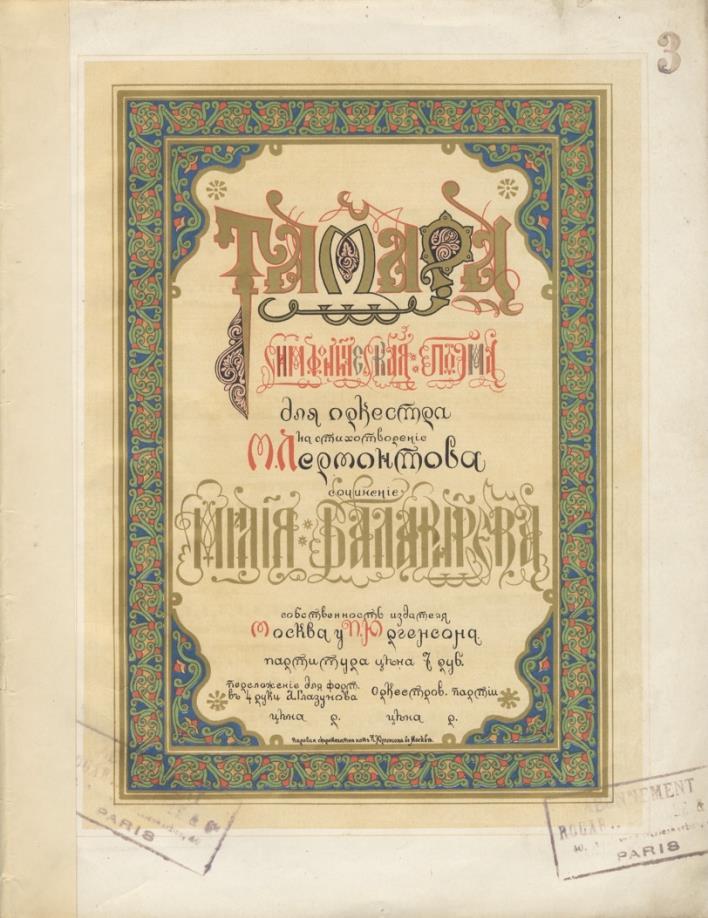
The Composer’s “Masterpiece”
3. BALAKIREV, Mily 1837-1910
на стихотворение М. Лермонтова [Tamara. Symphonic poem for orchestra based on a poem by M. Lermontov. Arrangement for piano 4-hands by Alexandre Glazounow].
Moskva: Jurgenson [PN 5895], 1884.
Folio. Sewn. [i] (elaborate chromolithographic title), 2-61, [i] (blank) pp. French music distributor's and the number "3" handstamps to title. Spine reinforced with Ivory paper. Minor wear.
First Edition of this arrangement, published in the same year as the full score. Rare.
"Tamara may reasonably be thought to be Balakirev’s masterpiece. Inspired by Lermontov’s poem and its beloved setting in the mountains and gorges of the Caucasus, Balakirev produced a wonderful evocation of the landscape and atmosphere in which the angelic and devilish seductive power of Tamara work their effect before the latest
passing lover is discarded. The plot implies a wide musical range, and the composer supplies it with great subtlety within a satisfying structure." Stuart Campbell in Grove Music Online. (40857) $350


4. BARTÓK, Béla 1881-1945 et al. Modern Magyar Zene. 12 Zongoradarab.
Budapest: Rozsnyai Károly [PN R. K. 419], 1912.
Folio. 1f. (recto decorative title printed in red and green, verso blank), 3-39 (music), [i] (publisher's catalogue) pp.
Contains:
Aggházy K.: Elégia; Bartok, Bela: 3 Csikmegyei népdal; Buttykay Á.: Bölcső dal; Chován K.: Nocturne; Dientzl O.: Petite valse; Jacobi V.: Marche miniature; Kern A.: Valse triste; Lavotta R.: Emléklap; Siklós A.: Humoreszk; Szendy Á.: Farsangi szerenád; Weiner L.: Caprice; and Zichy G. gróf.: Idylle.
Slightly worn and soiled; spine reinforced with paper tape. (40943) $60
“A Triumph Almost Without Rival of its Kind”
5 BIZET, Georges 1835-1875
L'Arlésienne Drame en 3 Actes de Alphonse Daudet ... Partition Chant & Piano. Pr: 5f. net ... A mon Ami Hippolyte Rodrigues. [Piano-vocal score].
Paris: Choudens Père & Fils [PN A.C. 2484], [after 1886].
Large octavo. Contemporary half dark red cloth with marbled boards, titling gilt to spine, marbled endpapers. 1f. (recto title, verso blank), [i] (contents), 2-77, [i] (blank) pp. Lithographed. Bordeaux musicseller's handstamp to lower outer corner of title. Binding soiled and slightly worn. Uniform lightbrowning;occasionalminorstains andsoiling; two small tears to blank lower margin of p. 59 repaired with archivaltape;titleslightlytrimmed,atoutermargin,affecting several letters of musicseller's handstamp.
First Edition, later issue.
L'Arlésienne was first performed on 1 October 1872. "The score ... is a triumph almost without rival of its kind, and cannot be fully appreciated apart from the play it was intended to illustrate. Of the 27 numbers, many are mélodrames only a few bars long ... and the longer
movements of the suites, although they never stale as concert music, have a primary dramatic integrity." Winton Dean: TNG Vol. 2, pp. 758-759.
French author and playwright Alphonse Daudet (1840-1897) wrote such noted works as Letters from My Windmill (1869) and Sidonie (1874). The Letters included the short story, L'Arlésienne, which was transformed into the play for which Bizet composed his incidental music. (40974) $75
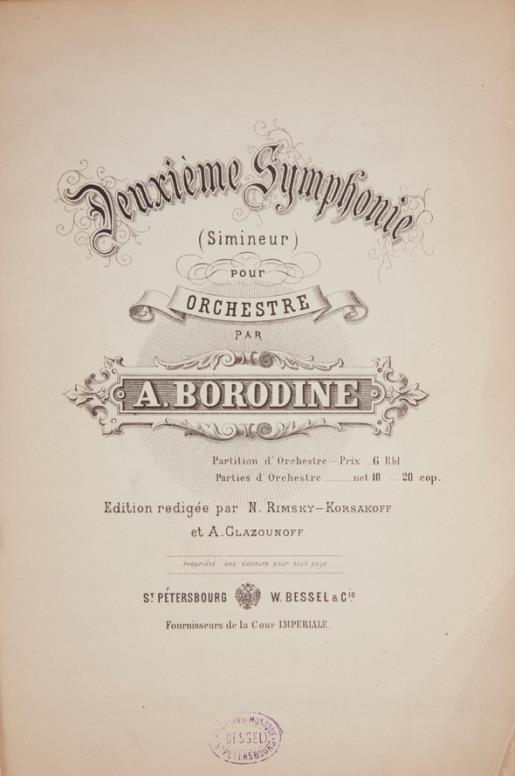
“One of [Borodin’s] Greatest Works” Revised by Rimsky-Korsakov and Glazunov
6 BORODIN, Aleksandr 1833-1887
Deuxième Symphonie (Simineur) pour Orchestre ... Partition d'Orchestre - Prix _6 Rbl. Parties d'Orchestre net 10 _ 20 cop. Edition redigée par N. Rimsky-Korsakoff et A. Glazunoff ... Propriété des editeurs pour tous pays. [Score].
St. Pétersbourg: W. Bessel & Cie [PN 671], [ca. 1880].
Quarto. Original gray publisher's printed wrappers with catalogue of instrumental works to verso of lower. [i] (title), 2156 pp. Small oval publisher's handstamp to foot of title. Wrappers considerably worn and chipped with significant losses to margins, affecting price list and content to lower outer portion; detached, with spine and blank inner margin reinforced with black cloth tape. Minor loss to blank lower outer corners of first ca. 15 leaves; some signatures loose.
Revised by Rimsky-Korsakov and Glazunov, printed from plates of the first, ca. 1877, edition.
"The B minor Symphony is the most important large-scale work to be completed entirely by Borodin himself, and one of his greatest works. It is a close relative of both Prince Igor and the abortive Mlada, two theatre works which diverted the composer’s attention, off and on, during the symphony’s extended gestation period. According to memoirs of Nikolay Kashkin, the symphony’s striking opening theme originated in an abandoned chorus of Polovtsians,
The first movement constitutes one of Borodin’s most imaginative sonata forms. Its opening theme, brusque and epigrammatic, combines both the major and minor 3rd above the tonic, and except for the E♮ (an upper neighbour) constitutes an octatonic subcollection. ... Other instances of interplay between major and minor 3rd, found scattered throughout the symphony, may be traced to this terse opening theme. ... The lyrical second theme (first heard in the conventional key of D major) provides effective contrast and acts as a cyclic element in the symphony, easily recognized in the trio of the scherzo, more distantly echoed in the finale. ... The mercurial scherzo, in F major, draws much of its effect from the rhythmic contrast between the two principal ideas, the first firmly on the beat, the second syncopated. The Andante begins with one of Borodin’s most serene melodies, its second phrase embodying the ornamental grace notes typical of his lyric tunes. This memorable melody is heard in varying orchestrations, in a free sectional design; some of the contrasting material subtly incorporates the interplay between minor and major 3rds found in the first movement. The finale is another sonata movement, freer than the first; perhaps its most striking moment is a whole-tone passage from the development, the theme of which is echoed in both Mlada and the prologue of Prince Igor." Robert W. Oldani in Grove Music Online (40993) $100
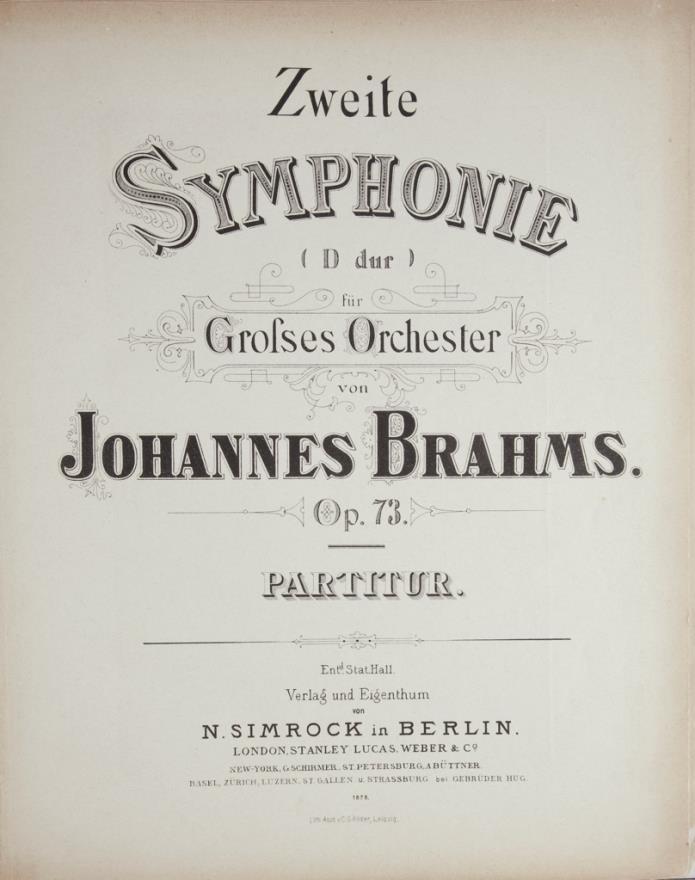
First Edition of the Second Symphony, often Described as a “Sunny Counterpart” to the First
7. BRAHMS, Johannes 1833-1897
Zweite Symphonie (D dur) für Grosses Orchester ... Op. 73. Partitur. [Full score].
Berlin: N. Simrock [PN 8028], 1878.
Folio. Quarter black leather with textured black cloth, titling gilt to spine. 1f. (recto title, verso publisher's note), 3-71, [i](blank) pp. Titlelithographed, musicengraved. Binding slightlyworn, rubbed, andbumped. Minor wear and browning; slightly brittle; very occasional minor staining; signatures split at pp. 12/13; very minor losses to blank lower corners; several corners torn, repaired with archival tape.
First Edition. McCorkle p. 311. Hofmann pp. 156-157. Fuld p. 553. Sonneck Orchestral Music p. 55. Hoboken 4,100.
"The Second Symphony in D op. 73, composed less than a year after the completion of the First, is often described as its sunny counterpart. The work indeed radiates a warmth and tunefulness absent in parts of the earlier work. But as Brahms himself acknowledged, the Second Symphony also has a ‘melancholy’ side. The lyrical opening theme of the first movement unravels almost at once into a dark passage for timpani and trombones. The voice of melodic continuity is reasserted often in this movement, however, first by the violin melody that follows the unravelling and again by the second group and the large coda. The pensive slow movement, in B major and in a modified sonata form, is dominated by a motivically rich, metrically ambiguous main theme remarkable for its combination of tunefulness and developing variation.
The second half of the symphony distinctly brightens in mood, although it too contains sombre moments – often involving the trombones – that evoke the expressive world of the first two movements. The Allegretto recasts the traditional scherzo–trio alternation into a rondo-like structure that is one of Brahms's most original creations. Although the finale ends the symphony in a jubilant blaze of D major, it glances back at the mood of the earlier movements, especially in the haunting passage at the end of the development section (whose chains of descending 4ths Mahler recalled in his First Symphony) and in the syncopated episode for brass in the coda." George S. Bozarth and Walter Frisch in Grove Music Online. (41000) $1,300
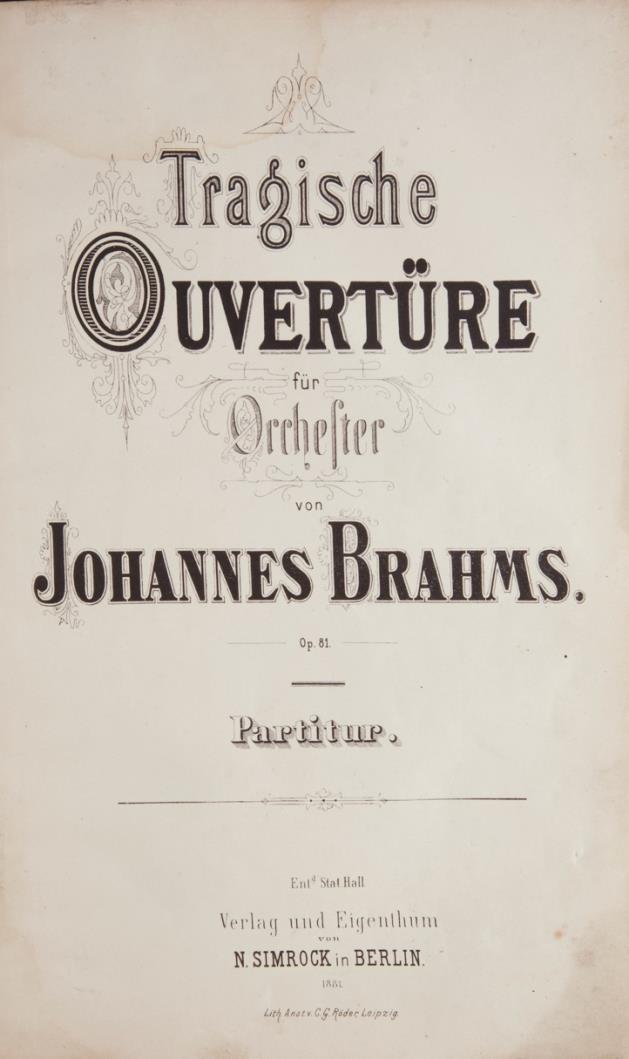
“Remarkable for its Motivic Concentration”
8 BRAHMS, Johannes 1833-1897
Tragische Ouvertüre ... Op. 81. ... Partitur ... Lith. Anst. v. C.G. Röder, Leipzig. [Full score].
Berlin: N. Simrock [PN 8189], 1881.
Large octavo. Half black leather with black cloth boards, titling gilt to spine. 1f. (recto title, verso blank), 1f. (recto blank, verso publisher's note), 5-71, [i] (blank) pp. Title lithographed, music engraved.
Ex-library, with "Cambridge Union Society Allon Bequest" gilt to foot of upper board and handstamped to head of first page of music; label of Cambridge Union Society to front pastedown. Binding worn, rubbed, and bumped; splitting at hinge. Faint dampstaining to upper portion of leaves; split at gutter, with some signatures detached; small tear to blank upper margin of p. 41 repaired with archival tape.
First Edition. Deutsch p. 258. Hofmann p. 173. McCorkle p. 338.
"The Academic Festival Overture op. 80 and the Tragic Overture op. 81 are counterparts to each other, somewhat like a satyr play and a tragedy. In the Academic Festival Overture about half a dozen popular tunes and student songs, including the Rákóczi March and Gaudeamus igitur, are woven into a sophisticated large-scale binary form consisting of a three-key exposition and a recapitulation that incorporates developmental elements. Beyond its title, the Tragic Overture has no specific programme or narrative. This imposing movement is in the spirit of D minor predecessors, including Beethoven's Ninth and Brahms's own First Piano Concerto. It is in a broad sonata form, in which the recapitulation begins with the transition to the second group. The overture is remarkable for its motivic concentration, especially the way in which all the thematic material seems to be generated from the bold opening ‘motto’ of a descending 4th." George S. Bozarth and Walter Frisch in Grove Music Online. (40997) $400

From the Collection of Noted Lutenist
Robert Spencer
9. CROFT, William 1678-1727
For March, 1702. Numb. 4. Ye Tuneful Numbers. A Song Sung by Mr. Bowen at the Consort in YorkBuildings
[London]: [Printedfor HenryPlayford, andSoldby him at his Shop in the Temple-Change, Fleet Street;and Mr. John Hare, at the Golden Viol in St. Paul's ChurchYard, and at his Shop, in Freeman's-Yard in Cornhill; and all other Musick Shops in Town: Where are to be had the Monthly Collections for three Years past], March 1702.
Folio. Tipped into modern wrappers. [4] pp. Historiated initial to opening line; "Numb.4." printed at upper outer corner offirst page. Unpaginated, but withthesignature "E" to foot of page 1. Typeset. Slightly soiled and browned but in very good condition overall.
Scored for voice and figured bass.
Provenance
Noted British lutenist and music collector, Robert Spencer (1932-1997), with his pictorial ex-libris stamped in black to upper wrapper.
A rare number from a series of songs titled Mercurius Musicus issued from 1699-1702. Day and Murrie 199 (1 copy only of this number only, at Harvard). JISC (1 copy only of this number only in the U.K., at the British Library). (40854) $250
With Music and Performance Instructions to 24 Country Dances, &c.
10 [DANCE - 19th Century - English]
Twenty four Country Dances for the Year 1789, with proper Tunes and Directions to each Dance, as they may be performed at Court, Bath, and all Public Assemblys. Price 6d.
London: Printed & Sold by G. Goulding, No. 6, James Street, Covent Garden, [ca. 1789].
Oblong 12mo. Black leather-backed flexible marbled boards. 1f. (recto title, verso blank), 12 pp. Contains music and dance instructions to 24 dances, with orthography as it appears, as follows:
Chapman's Dance, The House of Rew, Lady Townshend's delight, Indian Nabob, Les Notables, The Devil to do, Duke of York's Whim, New Plow Bow, [illegible], The Birth Day, New Paddy Whack, The Bustle, The Sailors Joy, Mrs. Hamilton of Bargenny's Reel, An odd fancy, Fox's whim, Prince of Wales Fancy, Westminster Election, Corri's fancy, The Highway to Coilsfield, The Countess of Percy's Reel, The Pippingo Reel, This will do, and Irish Boys.

Rare. BUC p. 231 (1 copy only, at the Manchester Public Library).
Bound with:
51-60, 67-90 pp. Contains 80 tunes (music only), excerpted from an unidentified publication, with orthography as it appears and attribution in parentheses where noted, as follows:
Les Teux d'Artifice, A Favorite Air (Clagget), Sandie o'er the Lee, The Honble. G. Carneghies Strathspey, Miss Hackets Favorite, Capt. Lockhart, The Bress of Mar, A Favorite Dance (Clagget), Badachan a Garidh, Lord Elgins Favorite Strathspey, The Highway to Linton, Miss Murray of Auchtertyres Strathspey, The Jolly Plowman, Miss Nicol's Strathspey, Lang Life to Neil Gow, Athol Brose, Perth Barracks (J. Anderson), Adiew, Miss Hunters Strathspey, Lord McDonalds Reel, Daintie Davie, The Smith's a Galant fireman, The Grauts of Strathspey, Mrs. Hamilton's Strathspey, Logie O Buch, Johnson's Music Shop, Jackey Laiten, A Sixpence under my Thumb, Bread and Chise to Rorry, The Charlotte, [?]Taft Toddie, Fisher's Favorite Dance, Carleton House, Gray day light, The loft Pint of Ale, [?]Dunrobin Castle, Maggy Shanks, Astley's Astley's Hornpipe, Astley's Ride, The Memory of Joys that are past, Castle Guthrie, New Christmass, Lady Burnside's Strathspey, The Mail Coach, The Village Maid, Miss Gunning, Morgan Ratler, Lord Kellys Reel, I wish you wou'd marry me now, Miss Stewarts Strathspey, O as I was kiss'd the streen, Ding's Music Shop Strathspey, The Barn of Carnie, Colonel Crawfords Strathspey, Miss Hamiltons Fancy, Wine cannot cure, Duke of York Cotillon, O'er Boggie, The Drunken Wife of Fochabers, Marry Ketty, Kilecrankie, New Bumpkin, The Flaggon, Roy's Wife, Lord Kinards Reel, Mirry Lads of Air, The Lasses of the Stewartown, and The Whigs of Fife. With manuscript date "26 Novr. 1810" to p. 51.
Bound with:
Melrose, William. A Collection of Psalm & Hymn Tunes in Three Parts Selected by William Melrose Teacher of Music. Price 1/6. Edinr.: The Editor, [1814]. [1] (title), 2 ("The Scale"), 9-36 pp. Engraved. Crude tape repair to title, obscuring several words. Lacking pp. 37-48.
Contains 55 tunes (music only) in 3-part settings for treble, tenor, and bass, as follows:
Nativity, Founders Hall, Oldham (Leach), Newton (Dr. Croft), New Aberdeen, St. Paul's, Heighington (Dr. Heighington), Mount Pleasant, St. Thomas, 100 Psalm (Martin Luther), Handel's 100, Portuguise Hymn, New Church (Geo. Green), Messiah (G.F. Handel), French, St. David's (Ravenscroft), Bedford (Wm. Wheall), Fraser (D. Wilson), Ipswich, Leeds, St. James's (Courtville), Northampton (A. Williams), Whitechurch , Dundee (Ravenscroft), St. John's, Christmas Hymn, Elgin, Funeral, St. Martyrs, Bangor, Wirksworth, Shields (Leach), St. Marks, St. Bridgets, Saints Air, Silver Street, Peterboro, Portugal, Peckham, Palastine, Manchester, Arnold, Newburgh, Tunbridge, Saxony, Salford (Leach), New Windsor, Bristol, Winchester, Blackbourn, Easter Hymn (Dr. Worgan), Littleton, Psalm 124, Weymouth (R. Harrison), and Trumpet.
Rare. JISC (1 copy only, at the National Library of Scotland).
Modern bookplate of noted Scottish-born South African ethnomusicologist P[ercival] R[obinson] Kirby (18871970), best known for his work on South African indigenous music, to front pastedown.
Binding worn; lower board detached, upper partially detached. Some wear, soiling, and browning; a number of leaves trimmed, including imprint, song titles, and performance instructions in several cases; small portions of blank outer margins of several leaves lacking. (41030) $500
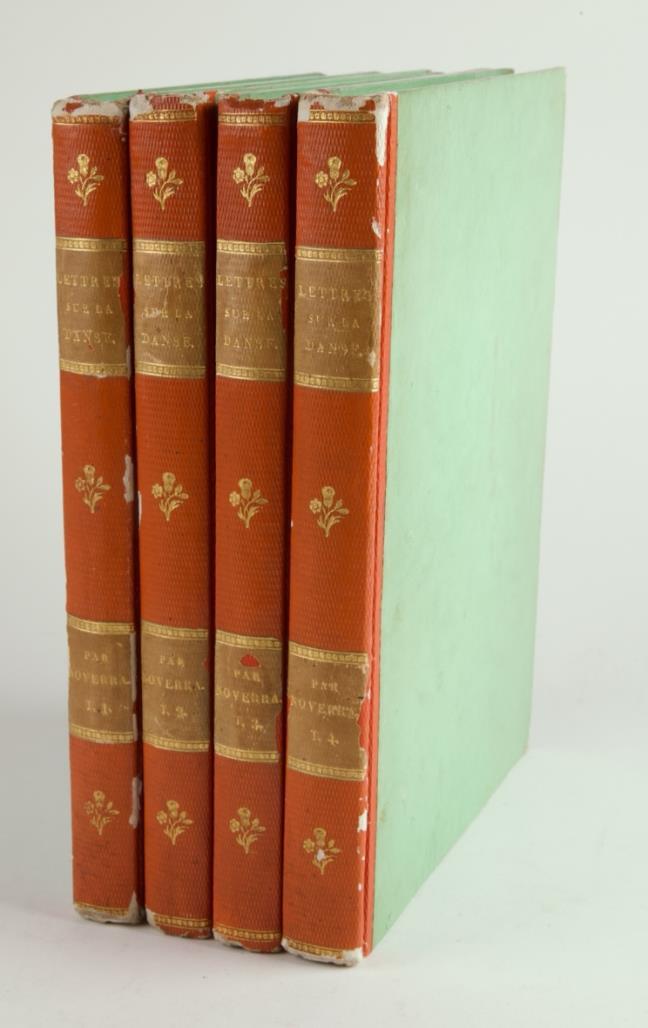
“Certainly the Most Beautiful ... of All of the Editions on Noverre” With Libretti of 22 Ballets
11 [DANCE - 19th Century - French]. Noverre [Jean-Georges] 1727-1810
Lettres sur la Danse, sur Les Ballets et Les Arts par M. Noverre, ancien maitre des ballets en chef de la cour de Vienne ret de l'Opéra de Paris. Tome Premier. [-Second, III, IV].
St. Petersbourg: Jean Charles Schnoor, 1803.
Four volumes. Quarto. Dark orange textured paperbacked mid-green boards with decorative floral elements and light brown decorative title labels gilt to spine, green speckled edges. With decorative bookplate designed by British painter and printmaker Michael Ayrton (1921-1975) to front pastedowns of each volume. Bindings very slightly worn, rubbed, and bumped. Occasional very minor foxing and light dampstaining An exceptionally attractive and wide-margined copy, in very good condition overall.
Vol. I: 1f. (title), 2ff. (dedication "A Sa Majesté L'Empereur de Toutes les Russies"), x ("AvantPropos"), [ii] (Errata) pp.; Vol II: 1f. (title), 1f. ("Avertissement"), 240, [ii](Errata) pp.;Vol. III:1f. (title), [3]-224, [ii] (Errata) pp.; Vol. IV: 1f. (title), [3]-256, [ii] (Errata) pp.
Scarce. Magriel p. 115. Derra de Moroda 1969. Niles & Leslie II p. 390. Fletcher 39. Malkin no. 90.
The first edition of the work was published in Lyon and Stuttgart in 1760, where Noverre had founded the Stuttgartballet forthecourtoftheDukeofWürttemberg. The presentsignificantlyexpanded edition includes, forthefirsttime, thelibrettiof22balletsbyNoverre. ItwastheoneusedbyCyrilBeaumontforhistranslation Letters on dancing and ballets by Jean Georges Noverre (London, 1930).
"Beaumont notes that the four-volume St. Petersburg edition also includes the scenarios for a number of Noverre's ballets, his correspondence with Voltaire, a selection of letters on general subjects - plus a long preface by the author, correctly summarizing his book's effect on dancing: "The glory of my art, my age and my numerous brilliant successes, permit me to state that I have achieved a revolution in dancing, as striking and as lasting as that achieved by Gluck in the realm of music" (p. 2)." Malkin p. 155
"Certainly the most beautiful and perhaps the most complete of all of the editions on Noverre. ... This edition contains in vols. 3 and 4 more synopses than in other editions, with separate half titles, and very often have introductions by the author, as in his Recueil des Programmes des Ballets, Vienne 1776. They are as follows: Vol. 3. Les Horaces, et les Curiaces; Euthyme et Eucharis; Medee; Les Graces; Renaud et Armide; Adele de Ponthieu; Psyche et l'Amour; Enee et Didon; Hymenee et Cryseis; La Mort d'Hercule; Les Amours de Venus; Apelles et Campaspe, ou La Generosite d'Alexandre; La Rosiere de Salency; Pyrrhus et Polixene; La Descente d'Orphee aux Enfers. Vol. 4. La Mort d'Agamemnon; Le Jugement de Paris; Les Danaides, ou Hypermnestre; L'Epouse Persanne; Alceste; Belton et Eliza; Iphigenie en Tauride... The lovely frontispiece engraving by J. Saunders is an important feature of the first volume." Niles & Leslie
"Considered as a contemporary history of dancing and as an exposition of the theories and laws governing ballet and dance representation, this work has no equal in the whole of the literature devoted to the Dance, and no book has exerted so incalculable an influence for good on the manner of production of ballets and dances. ... As an historical work we can learn from its pages Noverre's opinion of the merits and defects of the great dancers of the first half of the eighteenth century and the most valuable details regarding the production of, and costumes worn in, the ballets of the period." Beaumont p. 134. (40758)
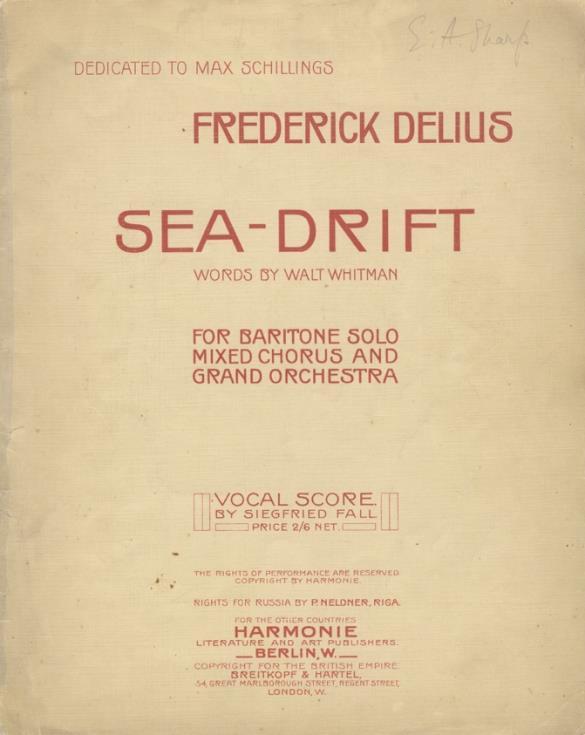
$4,000
“Considered by Many to be [Delius’s] Greatest Achievement”
12. DELIUS, Frederick 1862-1934
Sea-Drift for Baritone solo mixed chorus and grand orchestra ... Words by Walt Whitman ... Dedicated to Max Schillings. Vocal Score by Siegfried Fall. Price 2/6 net. [Piano-vocal score].
Berlin: Harmonie [PN 168], [1906].
Folio. Original publisher's ivory wrappers printed in dark red. 1f. (recto title, verso notice regarding performing rights), 3-39, [i] (blank) pp. Text in German and English. Wrappers slightly worn; spine frayed, reinforced with clear tape. Minor internal wear. Signature of E. A. Sharp in pencil to upper wrapper; occasionalmarkings in pencil within score.
First Edition, issue with English text only to upper wrapper. Published in the same year as the full score. Threlfall II/3, p. 60
First performed on 24 May 1906 in Essen at the Tonkünstlerfest of the Allgemeine Deutsche Musikverein.
"... Sea Drift (1903–4) for baritone, chorus and orchestra, is considered by many to be [Delius's] greatest achievement; its success at its first performance in Essen firmly established Delius on the Continent. Whitman’s treatment of a boy’s sorrow at a seabird’s loss of its mate is matched by Delius with profound insight. The work’s formal structure partly follows that of the text, but its expressive power transcends the poem. There is a seamless flow between the choral commentaries and the baritone narrator’s recitatives. ... Traditional devices of development and recapitulation are largely missing: Delius presents a stream of spiritual experience with a flow of chromatic harmony whose intensity is never broken, and variety of colour and pace is achieved almost imperceptibly, yet with utmost directness." Robert Anderson, Anthony Payne, and Lionel Carley in Grove Music Online. (40858) $300
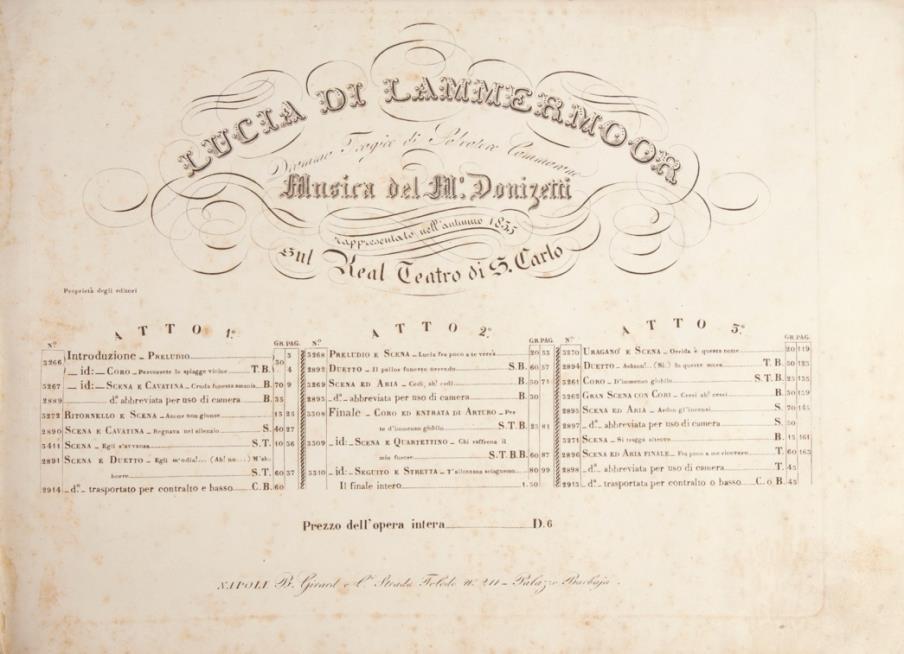
“Certainly His Masterpiece”
13 DONIZETTI, Gaetano 1797-1848
Lucia di Lammermoor Dramma Tragico di Salvatore Cammarano ... rappresentato sul Real Teatro di S. Carlo nell' autunno del 1835 ... Prezzo del'opera intera __D.6. [Piano-vocal score].
Napoli: B. Girard e Ci., Strada Toledo No. 211 - Palazzo Barbaja [PNs 3266-72, 2890-2, 2894-6, 3411, 330810, 3261-2], [1851-1852]. Oblong folio. Contemporary black leather-backed marbled boards with octagonal decorative dark green leather label gilt to upper with initials "GBL." Binding worn, rubbed, and bumped; small portion at head of spine lacking. Occasional minor wear, browning, foxing, staining, and small tears to blank margins; first title moderately foxed; a few minor losses to lower outer corners.
Act I: 1f. (recto title, verso blank), 3-23, [i] (blank), 25-50 pp.; Act II: 1f. (recto title, verso blank), 53-55, [i] (blank), 57- 85, [i] (blank), 87-115, [i] (blank) pp.; Act III: 1f. (recto title, verso blank), 119-121, [i] (blank), 123-133, [i] (blank), 135-176 pp. Each number with separate caption title and pagination. Engraved.
Later edition, later issue. Inzaghi IN. 55, pp. 172-175. Girard's first edition was published ca. 1835. This later issue combines a number of variant plates from their early editions.
Lucia di Lammermoor, to a libretto by Salvadore Cammarano after Walter Scott’s novel The Bride of Lammermoor (1819), was first performed in Naples at the Teatro S Carlo on 26 September 1835.
"Both historically and artistically, Lucia deserves its reputation. When it was new it was regarded as the apogee of high Romantic sensibility. The clear plot, which trims away much of Scott’s accessory detail, possesses the stark tautness of a tale by Poe. It is no coincidence that Flaubert employed it as an important point of reference in the downward course of Emma Bovary, that quintessential victim of Romantic illusions.
Although all the principal roles are vocally challenging, their music is uniformly grateful. The score contains scant sign of the unevenness that afflicts a number of Donizetti’s works. Cammarano’s libretto moved him deeply and, inspired by his recent first exposure to Paris, Donizetti produced what is certainly his masterpiece."
William Ashbrook in Grove Music Online (41002) $300

“A Clear Line of Development from the Baroque to the Galant Style”
14. FESTING,
Michael Christian 1705-1752
Twelve Solo's for a Violin and Thorough Bass. Dedicated to the Right Honourable Other Windsor, Earl of Plymouth, Baron Windsor of Bradenham, &c. &c. ... Opera Prima ... Price One Guinea.
London: Printed byWilliam SmithatCorrelli'sHead nearSt. Clement's Churchin the Strand;and sold onlyby the Author, at his House in Kemp-Court ibn Berwick-Street near Golden-Square, 1730.
Folio. Modern dark brown half calf with marbled boards, raised bands on spine in gilt-ruled compartments, dark red leather title label gilt. 1f. (recto title, verso privilege dated "22d Day of January 1729-30"), 1f. (recto dedication, verso blank), [iv] (subscribers list with woodcut headpiece signed FH d&sc incorporating a figure wearing a laurel holding a banner reading "Legent Hæc Nec Nostra Nepotes" next to a tablewith booksand anopen bookof music, trees, buildings, mountains, and a ship), 55 pp. Title, privilege, and subscribers list typeset; dedication and music engraved. Occasional small stains and soiling, mainly to blank lower margins; several leaves closely trimmed at outer margin, just touching staff lines; small tear to blank lower margin of p. 49 repaired with archival tape. A very good, crisp copy overall.
Subscribers include a number of important figures, including composers Maurice Greene and Joseph Kelway, with the names "James Ash Esqr.," "George Venables," and "Mr. Thomas Kelway. Organist of Chichester" added in contemporary manuscript.
First Edition. BUC p. 332. RISM F665 (2 copies only in the U.S., at the University of Virginia, Charlottesville, and the Library of Congress).
Festing was an English composer and violinist. "He is believed to be the musician portrayed in Hogarth's painting The Enraged Musician (1741, now in the Tate Gallery, London). ... Michael Christian Festing was primarily a violin virtuoso. He was taught the violin first by Richard Jones and then by Francesco Geminiani. Festing in his turn gave violin lessons, Thomas Arne being one of his pupils. ... His first public appearance was on 6 March 1723 at Hickford's Room, London, and the first mention of music composed by him occurs in a concert advertisement in 1726. In 1729 he performed at the York Buildings, Villiers Street, and his first published composition, Twelve Solos for a Violin and Thorough Bass op.1, dedicated to the Earl of Plymouth, appeared the following year. ... Festing's works generally show a clear line of development from the Baroque to the galant style. The early instrumental pieces employ ground basses, canons at the octave and fugal treatments. His output in general is more adventurous than that of Geminiani, although in some respects close parallels can be drawn between the two composers. ... All Festing's works include sudden and unusual modulations. Key changes up or down a tone are common, and other dramatic modulations reflect the Spanish harmonies of Domenico Scarlatti." Melanie Groundsell and Elizabeth M. Lamb in Grove Music Online
Finely printed on quality paper. (40584) $1,200

First Edition of this Composer and Bass Viol Virtuoso’s Opus 1
15 FINGER, Gottfried ca. 1660-1730
Sonatæ XII Pro Diversis Instrumentis Quarum Tres priores pro violino et Viola di Gamba, Proximæ tres pro II
Violinis et Viola di basso, Tres sequentes pro III Violinis Reliquæ pro II Violinis et Viola, Omnes ad Basin Continuam pro Organo seu Clavicymbalo Formantur Authore Godefrido Finger Olmutio=Moravo Capellæ Serenissimi Regis Magnæ Brtianiæ Musico Opus Primum [Set of parts].
Londini, 1688.
Quarto. Contemporary marbled boards, with the exception of the Violino primo part in contemporary marbled wrappers. With paper labels to uppers of second violin and viola da gamba parts with "No. 30," title, composer, and instrument designation in contemporary manuscript. The title describes the varied orchestrations of the sonatas in the collection: Twelve Sonatas for Various Instruments, of which the first three are for violin and viola di gamba, the next three for 2 violins and viola di basso, the following three for 3 violins, the rest for 2 violins and viola, all arranged for the bass continuum for organ or harpsichord.
Violino/Violino primo: 1f. (recto blank, verso frontispiece), 1f. (recto dedication, verso blank), [i] (title), 24, [i] ("Tavola") pp.
Violino secondo: [i] (title), 7-24, [i] ("Tavola") pp.
Viola di gamba/Viola di basso/Violino terzo/viol da brazzo: [i] (title), 24, [i] ("Tavola") pp.
Basso continuo: [i] (title), 24, [i] ("Tavola") pp.

With elaborate engraved frontispiece by Simon Gribelin incorporating in its center a bust of Finger on a pedestal in a Greco-Roman temple, with Mars placing a laurel on his head while holding a banner reading Arte et Marte, a saint placing a crown on his head holding banner reading Sufficit una, a winged angel playing a trumpet and carrying a banner reading Ad astra usque, and a warrior kneeling and holding a large piece of parchment with the first measure of the first sonata of the collection and the motto Puras non plenas aspice manus. The motto Deo volente, et viminibus navigas appears at the head of the frontispiece, above the crown, with an open book of music and instruments, including flute, lute, viol, cornetto, and recorder to lower inner corner.
Bindings worn, rubbed, and bumped; wrappers to Violino primo part separated at spine. Occasional minor wear, soiling, and foxing, mainly to blank lower margins. Violino primo part with small tears to blank inner margin of frontispiece; minor loss to lower outer corner of title and p. 4; small loss to blank lower margin of p. 16. Violino Secondo part with small loss to blank outer lowermarginof p. 20; dampstainto final three leaves affecting blank upper marginand extending downward into uppermost 3-4 staves. Viola da gamba part with title reinforced with strip of paper to blank inner margin; rear free endpaper reinforced; minor loss to lower inner corner. Basso continuo part with small stains, mainly to blank margin; dampstain affecting first four and final four leaves to lowermost portion of leaf. A mixed set, the Violino primo part from another copy.
First Edition. Rare. BUC p. 336. RISM F845 (one copy only in the U.S., at the New York Public Library).
Finger was a Moravian composer and viol player. “Georg Finger, his father or brother, was cantor at St Moriče, Olomouc. Gottfried was presumably in the service of Prince-Bishop Karl Liechtenstein-Kastelcorn, for pieces composed and copied by him survive in the prince-bishop's music collection at Kroměříž. According to Riemann, Finger was in Munich in 1682, and he was in London by spring 1687: he received a post in James II's new Catholic chapel by a warrant dated 5 July 1687, backdated to 25 March. In 1688 he published his op. 1, which he dedicated to James II, stating that the music was intended for use in the Catholic chapel. Finger did not follow the king into exile in 1688, but remained in London and started a successful freelance career. .. Finger was a bass viol virtuoso, and was appointed to teach the instrument in the abortive scheme for a Royal Academy in 1695. He did not publish any solo bass viol music, but manuscript sources (GB-Ob and D-SÜN) reveal him to have been one of the most important composers for the instrument of his time." Peter HolmanandRobertRawson in Grove Music Online Finger left England in 1701, working thereafter in Berlin, Mannheim, and Düsseldorf. (40586)
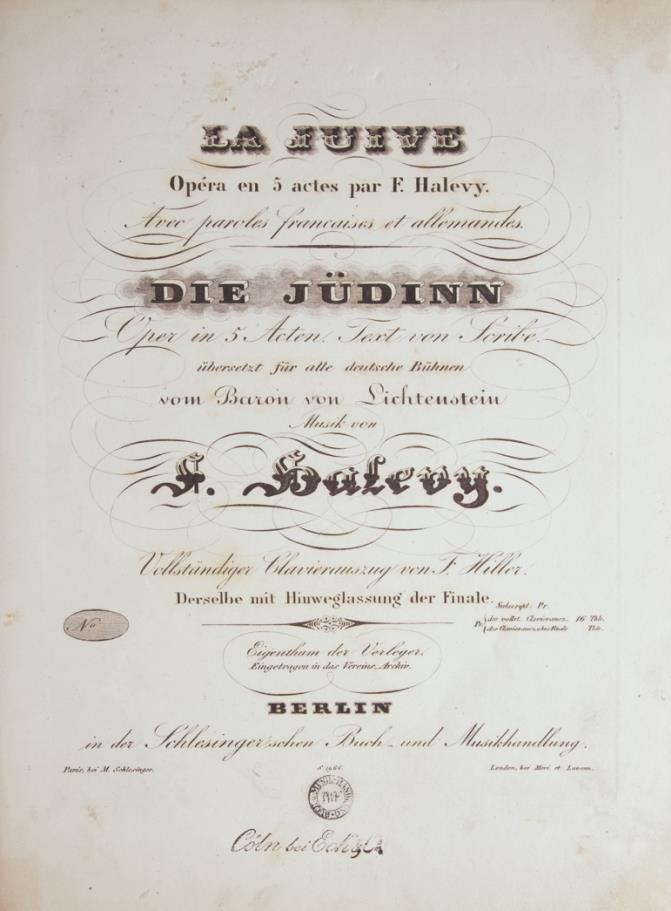
$3,800
“The Greatest Success of His Life”
16 HALÉVY, Fromental 1799-1862
La Juive Opéra en 5 actes ... Avec paroles françaises et allemandes. Die Jüdinn Oper in 5 Acten. Text von Scribe. übersetzt für alle deutsche Bühnen von Baron von Lichtenstein ... Vollständiger Clarierauszug von F. Hiller. Derselbe mit Hinweglassung der Finale. No. [blankl]. Subscript. Pr. ... der vollst. Clavierausz. 16 Thlr. des Clavierausz. ohne Finale [blank] Thlr. Eigenthum der Verlegter. Eingetragen in das Vereins Archiv.
Berlin: in der Schlesinger'schen Buch- und Musikhandlung. Paris, bei M. Schlesinger. London, bei Mori et Lavenu [PN S. 1966], [1835].
Folio. Half mid-tan calf with manuscript title label to spine, edges yellow. 1f. (recto title, verso blank), 1f. (recto cast list and incipits to overture and 25 numbers, verso blank), 3-213, [i] (blank) pp.; 1f. (recto title to Act III, verso blank), [i] (blank), 214-384 pp. Act I commences on p. 3, Act II on p. 129, Act III on p. 214, Act IV on p. 306, and Act V on p. 357. Text in German and French. Engraved. With small circular musicseller's monogrammatic handstamp and additional handstamp of Cöln bei Ech. & Co. to blank lower margin of title. Date in contemporary manuscript "11 October 36" to free front endpaper. Binding slightly worn, rubbed, and bumped; minor wear and staining to endpapers. Light uniform browning; very occasional light foxing; small tear to blank lower margin of pp. 51/52 repaired with archival tape. A exceptionally good, clean copy internally.
First German edition, published in the same year as the first edition published by Schlesinger in Paris.
La Juive, Halévy's first serious grand opera, premiered in Paris at the Opéra on 23 February 1835 and was first performed in Leipzig on 29 December 1835.
"[It] became the greatest success of his life and the single work on which his fame has rested. It ... took an instant hold on the public and became, with Meyerbeer’s operas, one of the central pieces in the French repertory. Excepting the ballet Manon Lescaut, it was his first collaboration with Scribe (to be followed by many more), and it epitomized the type of grand opera which is associated with Véron’s directorship of the Opéra. ... Wagner held Halévy’s work in high esteem (especially La Juive ...) and drew attention to his sense of period achieved without recourse to mock-antique devices." Hugh Macdonald in Grove Music Online (41027) $400

Rare Libretto of an “Imposing Spectacle” With Set Designs by Bibiena
17. HASSE, Johann Adolf 1699-1783
Solimano Drama per Musica, da rappresentarsi nel Teatro della Regia Elettoral Corte di Dresda, nel Carnevale dell' Anno MDCCLIII. La Poesia è del Sigr. Giannambrogio Migliavacca ... La Musica è del Sigre. Gio. Adolfo Hasso, Primo Maestro di Cappella ... La Scene sono nuova invenzione del Sigr. Giuseppe Galli Bibiena, Primo Ingegnere Teatrale, ed Architetto. [Libretto].
Dresda: Nella Stamperia Regia per la Vedova Stöffel, 1753.
Small quarto. Full contemporary burgundy leather with elaborate tooling gilt, all edges gilt, marbled endpapers. 1f. (recto blank, verso title in Italian), [i] (title in German) [xii] ("Argomento/Inhalt," "Attori/Singende Personen," "Mutazioni/Berwandlungen"), 92, [i] (blank) pp. i.e., 184 pp., facing pages with same pagination. Text in Italian and German. With occasional elaborate woodcut head- and tailpieces. Armorial bookplate with motto "Manima Præstant" and "2242" in manuscript to front pastedown. With contemporary manuscript annotation relative to performance to recto of title: "Crederei che omettendo si versi segnati con una lineetta si potesse recitar il dramma" [I believe that by omitting the lines marked with a dash the drama could be recited]. Named cast includes Angelo Amorevoli (Solimano), AngeloMaria Monticelli (Selim), Teresa Albuzzi(Narsea), Caterina Pilaja (Emira), Bartolommeo Puttini (Osmino), Giuseppe Belli (Acomate), and Antonio Fürich (Rusteno). Binding slightly worn, rubbed, and bumped; endpapers slightly worn, with clear tape repair to free front endpaper. Browned, a bit heavier to some leaves; somewhat closely trimmed, not affecting text.
First Edition. Rare Sartori 22255 (8 copies, only one of which is in the U.S.). Sonneck: Catalogue of Opera Librettos, 1018.
Solimano, an opera in three acts to a libretto by Migliavacca, was first performed in Dresden at the Hofoper on 5 February 1753. Loosely based on an episode in the life of Suleiman the Magnificent (1494-6 to 1566, Sultan of the Ottoman Empire), the lavish production featured set designs by noted Italian designer Giuseppe Galli Bibiena (1696-1757), the most distinguished artist of the Galli da Bibiena family.
"For several decades [Hasse] was the most widely admired composer of opera seria in Italy and Germanspeaking lands. His finest operas, written between the mid-1720s and the late 1760s, represent a highly systematized, rational style; they were handsomely produced and sung at leading theatres. Festival operas and vocal chamber works were composed for weddings and similar occasions at the Habsburg court in Vienna during the 1760s, by which time Hasse had come to be associated stylistically with the librettist Metastasio. Qualities described today as neo-classical also pervade his Dresden oratorios, his Venetian sacred works, and his later flute music probably for Berlin; much of his music exhibits dramatic effects of harmony, orchestration, and vocal line. He was able to compose at great speed, and his skill at adjusting to the voice of each singer was highly prized. Bel canto was for him always the sine qua non of great music, and to the beautiful display of the human voice all else was subordinated. ...
Solimano and a substantially revised Ezio, for the carnival seasons of 1753 and 1755, were imposing spectacles, with hundreds of extras for mob scenes and an array of animals including horses, mules, elephants, and camels, using outdoor space behind the stage illuminated by thousands of candles and lamps." Sven Hansell in Grove Music Online
An attractive copy of this rare libretto, with interesting contemporary performance annotation (41029) $1,500
Facsimile of the Autograph Full Score of The Planets
18. HOLST, Gustav 1874-1934
The Planets. Opus 32. Suite for Large Orchestra. Edited by Imogen Holst and Colin Matthews. [Facsimile].
London: Faber Music Limited, 1979.
Folio. Original publisher's full olive green cloth with titling gilt to spine. 254 pp. In dustjacket.
A photographic reproduction of the autograph full score preceded by textual commentary. Volume Three in the Collected Facsimile Edition of Manuscripts of the Published Works. (40932) $125
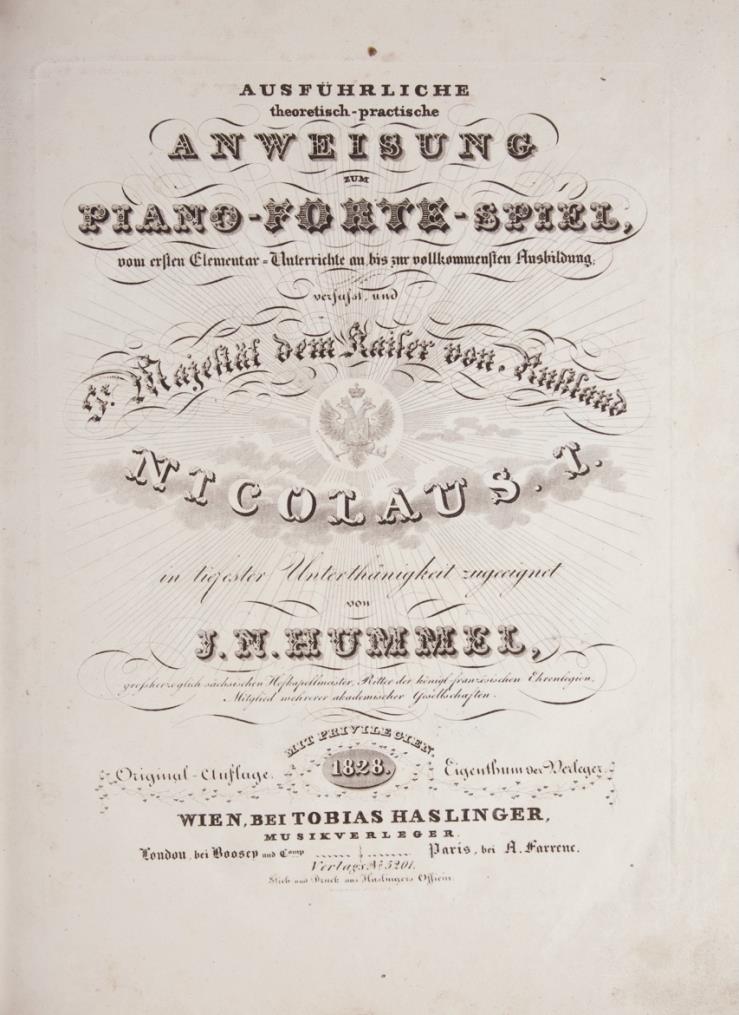
First Edition of this “Monumental Pedagogical Work” on Playing the Piano
19. HUMMEL, Johann Nepomuk 1778-1837
Ausführliche theoretisch-practische Anweisung zum Piano-Forte-Spiel, vom ersten Elementar=Unterrichte an bis zur vollkommensten Ausbildung, veerfasst, und Sr. Majestät dem Kaiser von Russland Nicolaus. I. in tiefester Unterthänigkeit zugeeignet ... Mit Privilegiest. Original-Auflage. Eigenthum der Verleger.
Wien: Tobias Haslinger; London, bei Boosey und Comp ; Paris, bei A. Farrenc [PN 5201], 1828.
Folio. Newly bound in dark brown calf with marbled boards, titling to spine ruled in gilt. 1f. (recto blank, verso frontispiece bust-length portrait engraving of the composer by Fr. Stöber in Vienna after Grünler with facsimile of Hummel's autograph signature below), 1f. (recto title, verso blank), 1f. (recto privilege with engraved German and Austrian Imperial crests, verso blank), 1f. (dedication to the Emperor), [7]-[8] (detailed contents), [9] (recto foreword, verso blank), [11]-[12] (publisher's note "Vorerinnerung für Eltern und Lehrer” [Reminder to Parents and Teachers]), 1f. (recto autograph facsimile of Hummel's Impromptû in Canone, verso blank).
Part I: 1f. (recto part title Erster Theil, verso blank), 13-111, [i] (blank) pp.; Part II: 1f. (recto part title Zweiter Theil, verso blank), 115-381, [i] (blank) pp.; Part III: 1f. (recto part title Dritter Theil, verso blank), 385-444 pp. With printed note to foot of final page "Text in Noten gestochen von Joh: Nep: Schönwälder" and Prænum: Exempl: T.H."
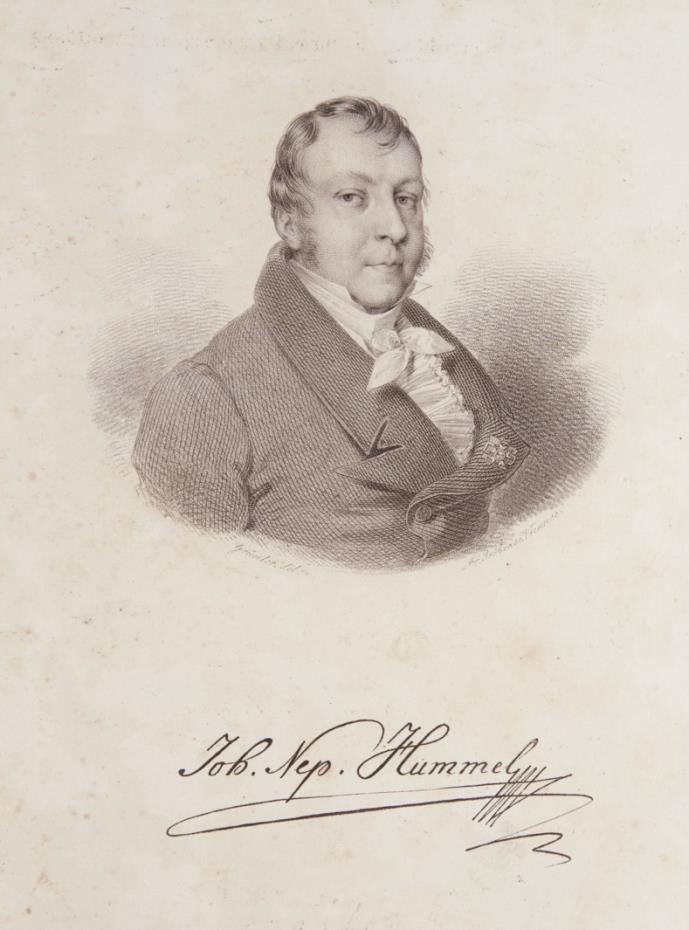
Engraved. With tissue guard between frontispiece and title to Part I. Some wear, soiling, and foxing, mostly to lower outer corners of Part I; minor markings in purple pencilto p. 171; carefultape repairs toa number of blank outer margins; occasional showthrough. An exceptionally clean and crisp copy.
First Edition. Zimmerschied p. 205.
Hummel, an Austrian pianist, composer, teacher and conductor, "was considered in his time to be one of Europe’s greatest composers and perhaps its greatest pianist. ... His teachings are summarized in his piano method, the Ausführlich theoretisch-practische Anweisung zum Piano-forte Spiel. This monumental three-volume work, consisting of more than 2000 exercises, was published almost simultaneously in Germany (1828), England (1828) and France (1829), and reportedly sold thousands of copies within days of its publication. It remains one of the most important sources of information about the late Viennese style of performing, embracing such diverse topics as ornamentation, fingering, improvisation, tuning (Hummel was an advocate of equal temperament) and a comparison of English and Viennese pianos. Although some of the information about ornaments seems to reflect Hummel’s personal style more than the common practice, it nevertheless gives an invaluable insight into the aesthetics of his generation. Its educational intent is clearly far above that of the usual commercialized instruction books so characteristic of the 19th century, for whereas dexterity was the sole aim of most manuals, Hummel, stressing musicianship, placed the performance and understanding of Bach’s music as the highest goals." Joel Sachs, revised by Mark Kroll, in Grove Music Online
"Hummel's etudes and his piano treatise Ausfuhrliche theoretisch-practische Anweisung zum Piano-Forte Spiel (A Complete Theoretical and Practical Course on the Art of Pianoforte Playing) are his two monumental pedagogical works on the art of playing the piano, and together represent the sum total of his considerable expertise. The treatise, published in 1828 and copiously illustrated with examples and exercises, is primarily theoretical: its purpose is to explain the entire technique of piano playing. The etudes, which draw upon the essence of the ideas set forth in the treatise and which represent musical renderings of a variety of musical and technical problems, are entirely practical." Sun-Im Cho: Johann Nepomuk Hummel's Piano Etudes, Op. 125: A Pedagogical Analysis, City University of New York thesis dissertation, 2012, OCLC: 861617081
Franz Xaver Stöber (1795-1858) was a noted Austrian engraver and etcher.
Complete copies of this important work are rare to the market. (41028) $2,000
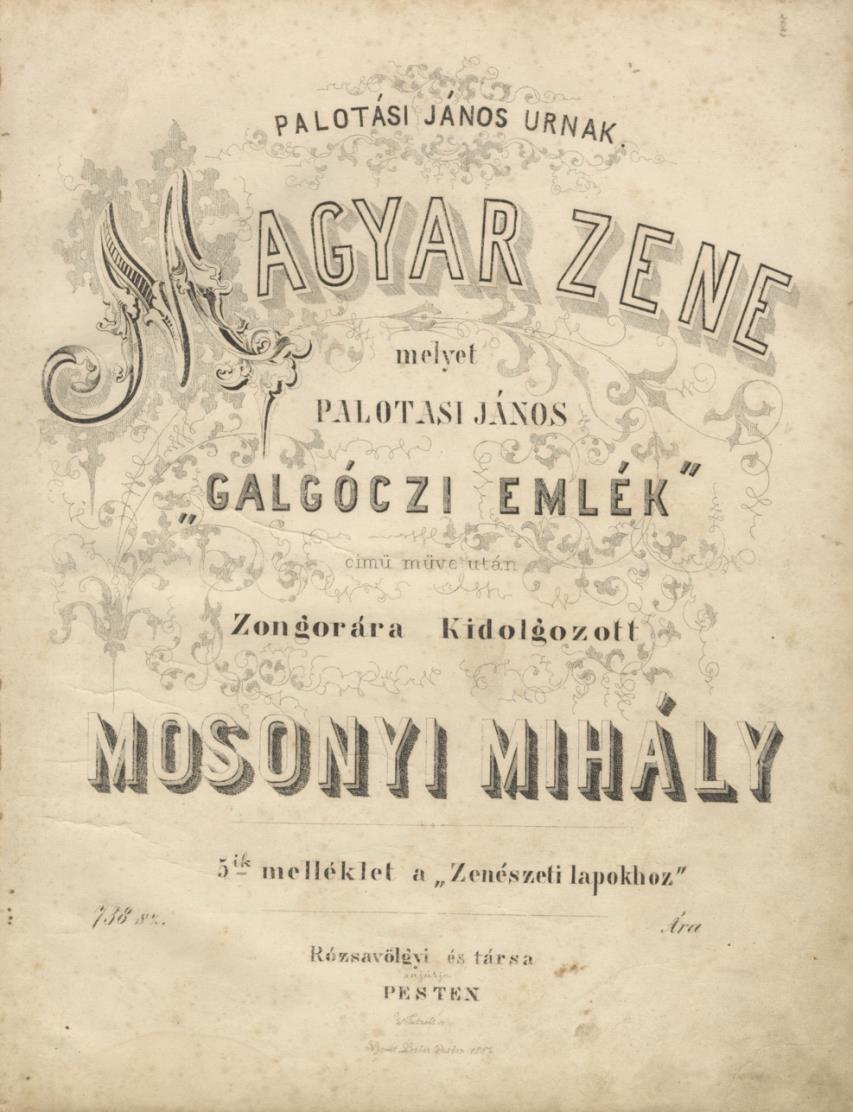
52 Rare Volumes of First and Early Editions of Music Published in Hungary
20. [HUNGARIAN MUSIC]
Collection of rare first and early editions of music published in Hungary 1842-1958.
52 volumes, somecontaining multiple pieces, mostly for solopiano butwith some for voiceand piano, including works by the following composers and arrangers: Ábrányi, Arditi, Bohus, Császár, Dohnányi, Doppler, Dunayevsky, Egressy, Ellenbogen, Erkel, Farkas, Fényes, Frank, Horváth, Höszly, Huska, Jacobi, Kálmán, Kéler, Kerekes, Kneifel, Kovaltsik, Möller, Mosonyi, Müller, Pékáry, Ridley-Kohne, Rózsavölgy, Rupp, Suppé, Széchenyi, Székely, Szirmai, Thern, Travnyik, Verdi, Windt, Zapf, Zeller, and Zerkovitz.
A detailed inventory is available upon request (41004) $2,250

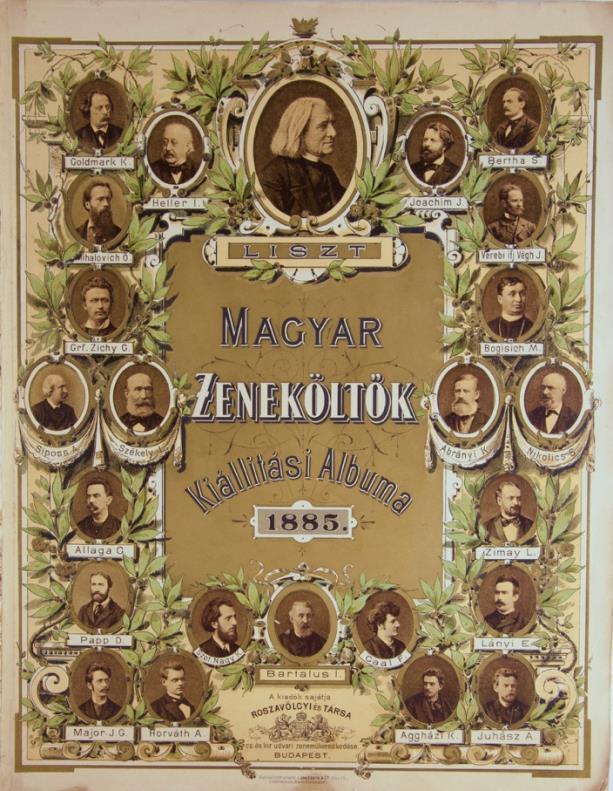
20 First and Early Editions of Operas and Operettas by Hungarian Composers
21. [HUNGARIAN MUSIC]
Collection of rare first and early editions of operas and operettas by Hungarian composers.
20 volumes, somecontainingmultiple pieces, in pianovocal score, including works by the following composers: Berté, Buttykay, Goldmark, Jacobi, Jarno, Kálmán, Lehár, Schmidt, and Schubert.
A detailed inventory is available upon request (41005)
$550
22. [HUNGARIAN MUSIC]. Bartalus, István, ed. 1821-1899
Magyar Zeneköltők Kiállítási Albuma
Budapest: Rózsavölgyi és Társa, 1885.
Folio. Original publisher's pictorial black cloth-backed wrappers, upper withalithographicillustrationincolor of the Hungarian Exhibition Hall. 1f. (recto chromolithographic illustrated title featuring 24 emblematic composer portraits of composers represented in the present collection, verso blank) 1f. (recto secondary decorative title printed in beige, light green, andblack, verso blank), 155m [i](blank) pp., 1f. (recto index, verso blank). Wrappers slightly chipped and frayed at edges, with small tears. Some minor wear, staining, and soiling; some leaves loose.
Contains works for piano solo by the following 19th century Hungarian composers: Ábrányi Kornél, Aggházy Károly, Allaga Géza, Bartalus István, Bertha Sándor, Bogisich Mihály Gaál Ferenc, Goldmark Károly, Heller Stephen, Joachim József, Juhász Aladár, Lányi Ernő, Liszt Ferenc, Major J. Gyula,
Mihalovich Ödön, Nagy Károly, Nikolits Sándor, Pálóczi Horváth Ádám, Pap Dezső, Siposs Antal, Székely Imre, Végh János, Zichy Géza, and Zimay László.
Rare. OCLC (1 copy in Hungary and 2 copies in Germany only).
"The 1885 Hungarian National General Exhibition in Budapest showcased various aspects of Hungarian culture, including music. Although detailed records of every musical performance may be scarce, information points to a strong connection between the exhibition and Hungarian music. ... The exhibition took place during what is considered the "Golden Age" of Budapest, a period of flourishing cultural activity between 1867 and 1914. The exhibition served as a platform to highlight this vibrant cultural life, which undoubtedly included a focus on music." AI (40944) $250
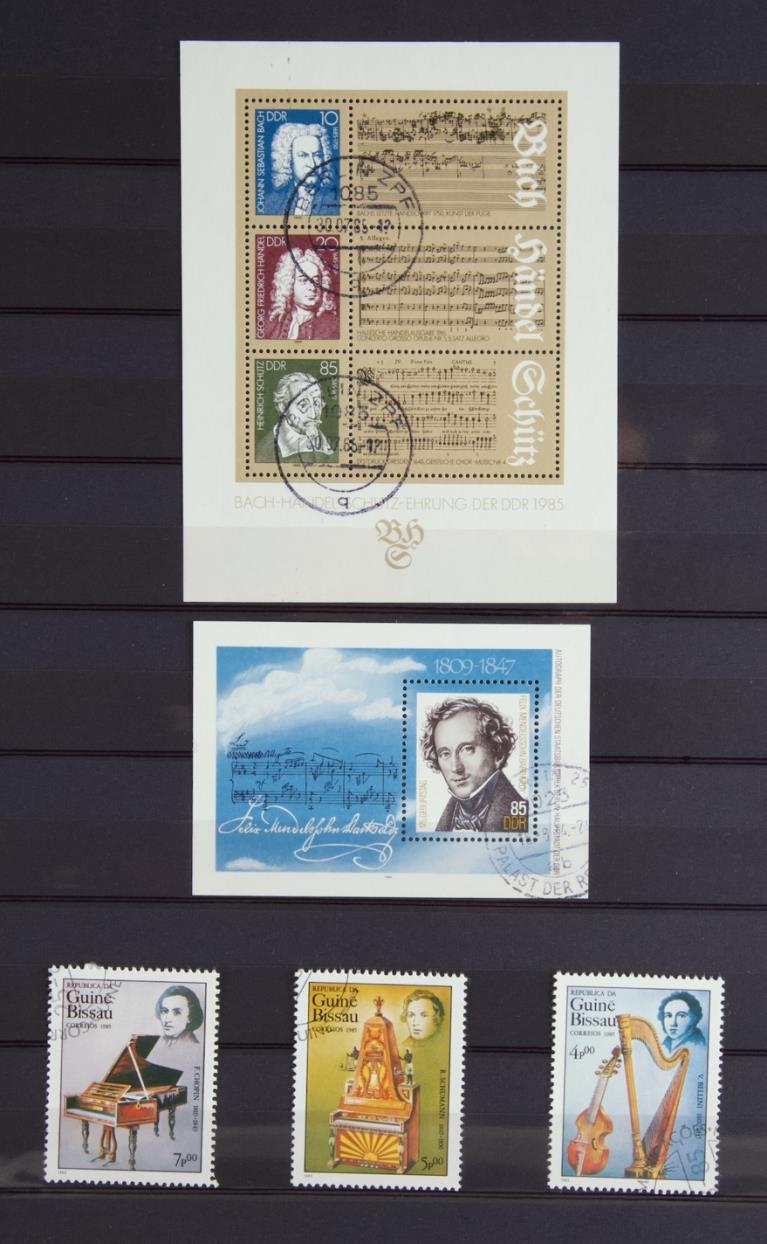
Postage Stamps on Musical Subjects
23 [ICONOGRAPHY - STAMPS]
Collection of over 250 international postage stamps on musical subjects including composer portraits, musical instruments, opera houses, etc., 1960s1990s. Loose in two stamp albums. Quarto.
Provenance
Mahler specialist Gilbert E Kaplan (1941-2016).
The collection includes a significant number of representations of composers including J. S. Bach, Beethoven, Mahler, Mendelssohn, Mozart, and Schubert, as well as composers and musicians of national interest in addition to a large number depicting individual musical instruments and performance, with 6first-day covers. European countries represented include Austria, Germany Hungary, Russia, and Sweden; African countries include Guinea, Zambia, Rwanda, Chad, Ethiopia, and Liberia; Asian countries include India, Thailand, Cambodia, Indonesia,andLaos;andSouthandLatin American countries include Cuba, Haiti, Chile, Nicaragua, Bolivia, and Brazil. With a small number of duplicates. A sheet of approximately 50 miscellaneous stamps glued down. Approximately half of the stamps are unused, with some in desirable block format. In very good condition.
Gilbert Kaplan, an economist and publisher of the financial magazine The Institutional Investor, had a second career as a conductor of Mahler's Second Symphony, the Resurrection. "By 1982, when Mr. Kaplan made his sweaty-palmed debut with the American Symphony Orchestra, he had undergone an immersion worthy of George Plimpton, devouring recordings, traveling the world to hear every live performance, grilling scholars and conductors and undergoing a monthlong nine-hour-a-day boot camp in the mechanics of conducting. Mr. Kaplan would go on to conduct the “Resurrection” more than 100 times. He would become a recognized authority on the piece and the owner of its original score, which he published in facsimile; a lecturer on Mahler; and the owner of a bust of him by Rodin." NY Times Obituary, January 6, 2016. (40945) $200

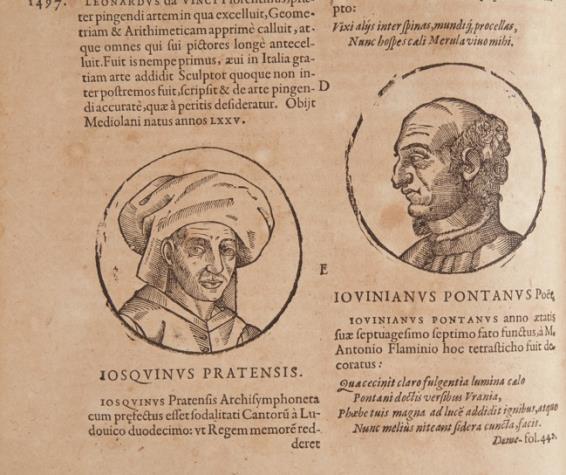
With One of the Earliest Images of this Important Renaissance Composer
24. [JOSQUIN DES PREZ ca. 1450-55 to 1521]. Opmeer, Petrus 1526-1594
Opus chronographicum orbis universi a mundi exordio usque ad annum MDCXI. Continens historiam, icones, et elogia, summorum pontificum, imperatorum, regum, ac virorum illustrium; in duios tuomos divisium. Prior acutore Petro Opmeero ... Posterior aucture Laurentio Beyerlinck.
Antverpiæ: Hieronymi Verdussi, 1611.
2 volumes in one. Large thick folio. Full contemporary dark brown leather with raised bands on spine in decorative compartments gilt. With over 450 portrait woodcuts and occasional woodcut initials and tailpieces.
Book I
1f. (recto fine allegorical title engraved by Willem de Haen after P. de Jod., verso blank), 2ff. (dedication to "Serenissimis Alberto et Isabellæ Claræ Eugeniæ Archiducibus Austriæ ..."), 3ff. ("Vita Petri Opmeeri," testimonials, approbation, and privilege), 516 pp. + 16 ff. (index, verso of final leaf blank). Page 351 folding, with "Genealogia Caroli Magni."
Book II
Opus chronographicum orbis universi i ab anno M.D LXXII. ad usque M.DC.XI. Continens historiam icones, et elogia summorum pontificum ... Auctore Laurentio Beyerlinck Cive, et Canonico Antuerpiano Tomus II. 1f. (recto title with attractive woodcut device, verso blank), [3] (dedication), [4]-[5] ("Amico Lectori" by Beyerlinck, 6-338 pp. + 3 ff. (index, verso of final leaf blank).
With contemporary ownership notation to free front endpaper "Antonij Francisci Bertini." Occasional notes in contemporary manuscript to margins. Binding somewhat worn, rubbed, and bumped; spine restored, but with minor worming and loss; hinges split. Some signs of internal wear. Quite browned throughout, heavier to some leaves. Title to Book I worn with minor worming and chipping to edges with resultant minor loss, mounted to backing sheet.
A "history of the world" from "creation" to date of publication 1611, with historical accounts, images, and biographical descriptions of significant figures including popes, emperors, kings, and other prominent individuals.
Includes what is generally believed to be one of the earliest images of the important Franco-Flemish composer of the Renaissance Josquin des Prez, a woodcut done from a now-lost oil painting executed during the composer's lifetime
"Discovered documents reveal that the well-known woodcut of Josquin was almost certainly copied from a panel portrait in oil that once stood in the church of Ste Gudule, Brussels (see Haggh, 1994). Petrus Jacobi (d 1568), a canon of Ste Gudule, owned a portrait of Josquin that may have been painted while the composer was still alive. Jacobi directed in his will that this portrait should be included as one side panel of a triptych that would feature St Peter in the central panel and Jacobi himself on the opposite side; this altarpiece was to be placed near Jacobi’s tomb in Ste Gudule. The portrait was installed in 1569, the year after Jacobi’s death, but only a decade later Protestant iconoclasts destroyed the images in the church. In the Opus chronographicum, completed in 1569 but not published until 1611, Petrus Opmeer singled out the portrait of Josquin in Ste Gudule on which he based his woodcut of the composer, and approvingly referred to Josquin’s ‘truly virtuous face and attractive eyes’ Patrick Macey." Website of Multimedia Art Productions
"[Josquin] was one of the greatest composers of the Renaissance, whose reputation stands on a level with those of Du Fay, Ockeghem, Palestrina, Lassus and Byrd. His music spans the transition between the sound-world of the late Middle Ages and that of the High Renaissance, and served as a model for much of the 16th century." Patrick Macey, Jeremy Noble, Jeffrey Dean, and Gustave Reese in Grove Music Online (41026) $650
“An Unusual and Austere Work”
25 LISZT, Franz 1811-1886
Missa quattuor vocum ad aequales (H T T. et H B B.) concinente organo ... Constat 1 Th. 15Gr. [LWV J5]. [Organ-vocal score].
Lipsiae: Breitkopfii et Härtelii [PN 8636], [1853].
Folio. Dark yellow cloth-backed light gray boards. 1f. (recto title, verso blank), 1f. (recto dedication to "Patri Venerabili Albach," verso blank), 3-35, [i] (blank) pp. Engraved. Scored for Tenors I and II, Basses I and II, and Organ. Handstamps of the Music Institute of the University of Vienna to title and dedication; deaccession note and stamp to verso of title. Binding somewhat worn, rubbed, and bumped, with remnants of label to inner corner of upper board. Minor internal wear; lower outer corners bumped.
First Edition of the first version. Searle 8a. Raab 485a.
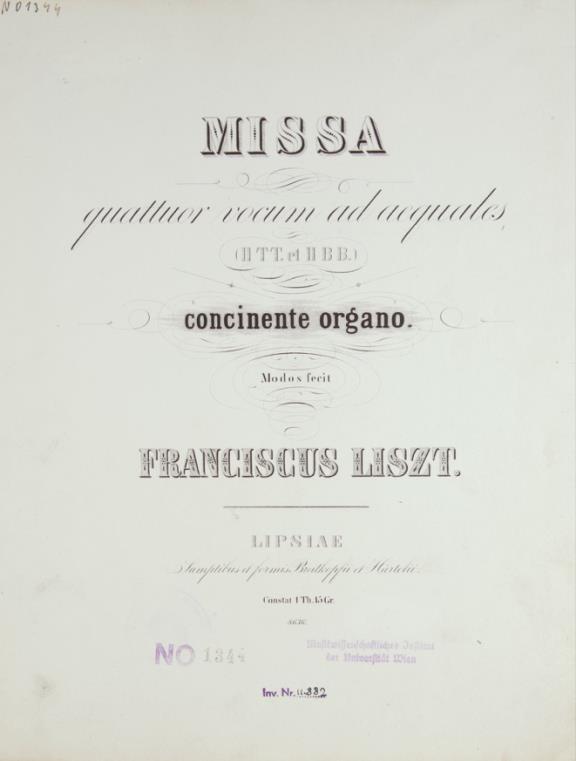

The Mass for four male voices and organ was composed in 1846-1847 and was first performed in 1852 in Weimar "to celebrate the birthday of the President of the French Republic - later the Emperor Napoleon III. This is an unusual and austere work in which singers effectively declaim, not sing, parts of the Credo. The melodic line of the Gloria reveals the influence of plainchant." Collet: Franz Liszt. The Man & His Music, Alan Walker, ed., p. 340. (40935) $300 `
26. LISZT, Franz 1811-1886
Chöre zu Herder's "Entfesseltem Prometheus"...Verbindender Text von Richard Pohl. Klavierauszug Pr. M6_netto. [LWV 8]. [Piano-vocal score].
Leipzig: C. F. Kahnt, Nachfolger [PN 1711], [ca. 1890].
Large octavo. Half black cloth mottled blue/gray boards with original publisher's light purple printed upper wrapper trimmed and laid down to upper. 1f. (recto title in white and black on light green ground, verso blank), 71 pp. Small handstamp of Viennese music antiquarian Doblinger to upper board. Several small marginal tears repaired; upper margin of p. 17 soiled.
Later issue of the revised second version. Searle 70. Raab 539. (40934) $75


27. LISZT, Franz 1811-1886
Harmonies Poetiques et Religieuses pour le Pianoforte Seul dediées à Monsieur Alph. de Lamartine ... Pr. 10 gr. [LWV A18].
Leipzig: Frederic Hofmeister [PN 2070], [ca. 1835].
Folio. Disbound. 1f. (recto title, verso blank), 3-9, [i] (blank) pp. Engraved. With secondary pagination to rectos in manuscript. Oval handstamp of Scharfenberg & Louis, New York and additional partial circular handstamp to blank lower margin of title. Formerly in the collection of the Forbes Library in Northampton, Massachusetts, with their handstamp to upper outer corner oftitle and first page of music. Slightly worn and browned; final leaf partially separated.
Revised edition, published two years after the first edition. Searle 154. Raabe 13. Hirsch M. 951. (40938) $115
28. LISZT, Franz 1811-1886
Réminiscences de l'Opéra Norma. Grande Fantaisie pour le Piano ... à 2 mains Pr M4,25. [LWV A77].
Mayence: Les fils de B. Schott [PN 7416], [ca. 1890].
Folio. Disbound. 1f. (recto title, verso blank), 23, [i] (blank) pp. Engraved. With secondary pagination to rectos in manuscript. Common title with plate numbers for 2hand version (7416) and later 2-piano version (8334). Formerly in the collection of the Forbes Library in Northampton, Massachusetts, with their handstamp to upper outer corner of title and several pages. Minor offsetting; pagination in ink to upper corners.
First Edition, laterissue. LWA77. Searle394. Raabe 133.
"The Reminiscences of Norma encompass the dramatic essence of Bellini's opera in a most imaginative way. Liszt takes seven musical ideas from the drama and arranges their appearances to depict Norma's tragic dilemma: the conflict between her human feelings of love, revenge and grief, and her spiritual calling as High Priestess. The melodies of Norma, especially the exquisitely sculpted, slow and elegiac lines of pathos, have a simple dignity and noble grandeur that Liszt mirrors to perfection." Watson: Liszt, pp. 206-207. (40940) $60

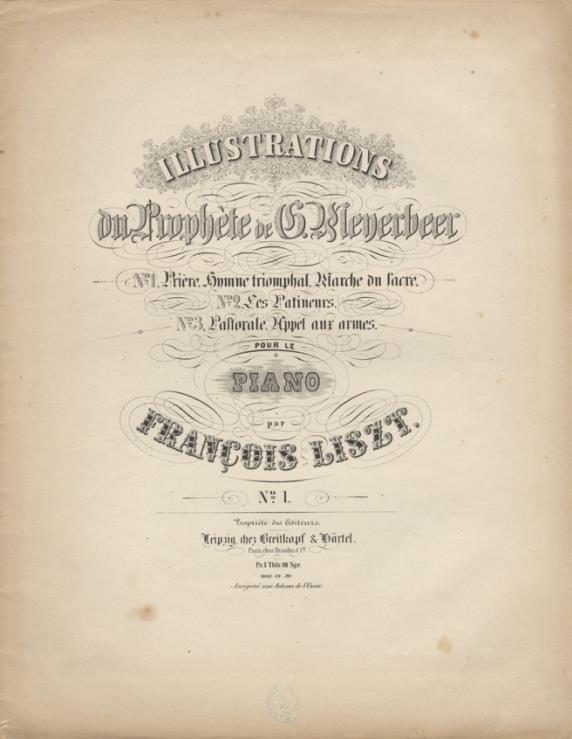
29. LISZT, Franz 1811-1886
Reminiscences des Huguenots Grande Fantaisie dramatique pour le Pianoforte composée et dediée à Madame la Comtesse M. D'. A. ... Op 11. Pr. 1 Thlr. 8 Gr. [LWV A35].
Leipzig: Fred. Hofmeister [PN]2269], Before 1841.
Folio. Ivory wrappers with manuscript titling to upper. 1f. (recto title, verso blank), 3-31, [i] (blank) pp. Engraved. Slightly worn, browned, and thumbed; small chips and tears to outer margin of title with minor loss; some upper outer corners slightly turned. Wrappers slightly worn, browned, and stained, with small chips to outer edge and spine. Searle 412. Raab 221. (40942) $75
30. LISZT, Franz 1811-1886
Illustrations du Prophète de G. Meyerbeer ... No.3. Pastorale. Appel aux armes pour le Piano ... Pr. 1 Thlr. 10 Ngr. [LWV A165-3].
Leipzig: Breitkopf & Härtel [PN 8090], 1850.
Folio. Unbound as issued. 1f. (recto title, verso blank), 329, [i] (blank) pp. Engraved. Small oval handstamp to blank lower margin of title. Slightly worn, browned, and foxed.
First Edition. Searle 414:3. Raab 223.
Liszt made numerous transcriptions from the operas of Meyerbeer, including L'Africaine, Le Prophète, Les Huguenots, and Robert le Diable. (40941) $135
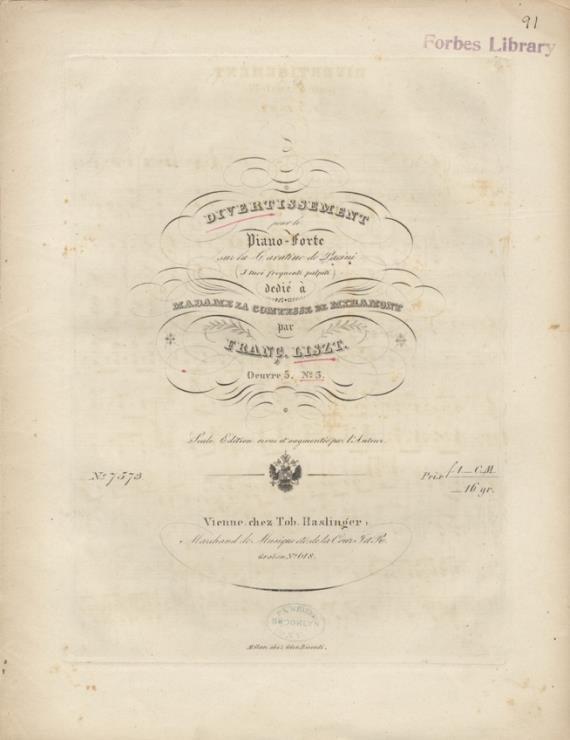

31. LISZT, Franz 1811-1886
Divertissement pour le Piano-Forte sur la Cavatine de Pacini (I tuoi frequenti palpiti) dedié à Madame La Comtesse de Miramont ... Oeuvre 5. No. 3.Seule Edition revue et augmentée par l'Auteur. Prix f1-C.M.- 16 gr. [LWV A24].
Vienne: Tob. Haslinger [PN T. H. 7573], 1838.
Folio. Disbound. [i] (title), 2-23, [i] (blank) pp. Engraved. With secondary pagination to rectos in manuscript. Small oval handstamp of P.K. Weizel, Brooklyn, NY to lower margin of title. Formerly in the collection of the Forbes Library in Northampton, Massachusetts, with their handstamp to upper outer corner of title and several pages. Very slightly worn, soiled, and foxed; outer bifolium separated at spine; small blank piece of ivory paper laid down to final blank page.
First Edition. Searle 419. Raabe 230. (40939) $150
32. LISZT, Franz 1811-1886
Episode de la Vie d'un artiste de Hector Berlioz. Marche du Supplice pour Le Piano à deux mains. Pr. 14 Gr. à quatre mains Pr. 1/3 Thlr.
Berlin: Ad. Mr. Schlesinger [PN S. 2224], 1839.
Folio. Disbound. 1f. (recto title, verso blank), [i] (blank), 4-13, [i] (blank) pp. Engraved. With secondary pagination to rectos in manuscript. Formerly in the collection of the Forbes Library in Northampton, Massachusetts, with their handstamp to upper outer corner of title and several pages. Slightly worn and browned; outer leaf separated at spine; narrow strip of early paper tape to inner margin of title.
First Edition, later issue. Searle 470. Raabe 134. (40937) $100
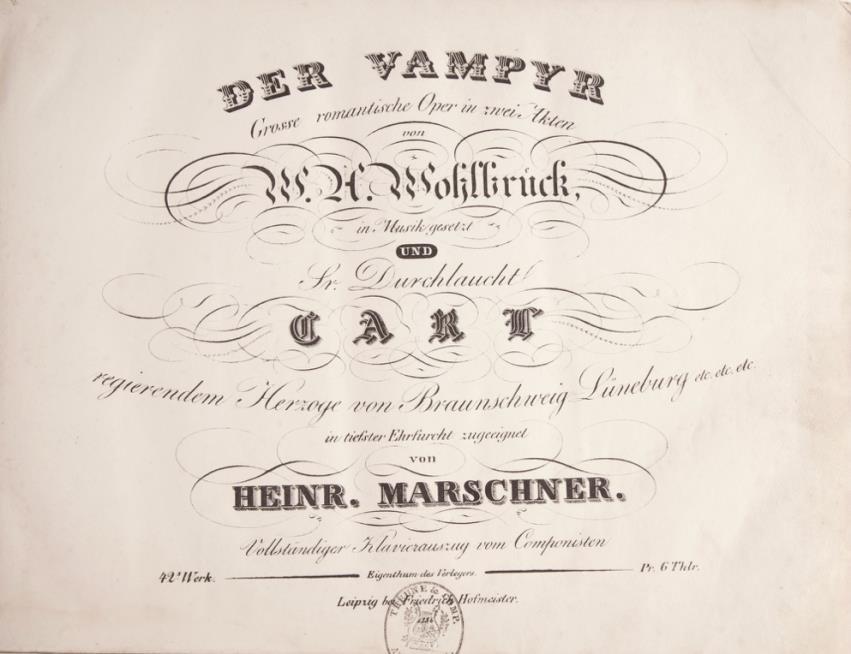
“Has Held the Interest of the Opera-Going Public Ever Since the Resounding Success of its Leipzig Première”
33. MARSCHNER, Heinrich August 1795-1861
Der Vampyr. Grosse romantische Oper in zwei Akten von W.H. Wohlbrueck in Musik gesetz und Sr. Durchlaucht Carl regierendem Herzoge von Braunschweig Lüneburg etc. etc. etc. in tiefster Ehrfurcht zueeignet... Vollständiger Klavierauszug vom Componisten 42s. Werk... Pr. 6 Thlr. [Piano-vocal score].
Leipzig: Friedrich Hofmeister [PN 1356a, 1356 b], 1828.
Oblong folio. 19th century quarter dark green calf with marbled boards (worn and scuffed; joints partially split). 1f. (recto lithographic title, verso blank), [i] ("Personen/Inhalt"), 2-120 (first act), 100 (second act) pp. Text in German. Engraved. Handstamp "Theune & Comp." with lyre to foot of title. Binding somewhat worn, rubbed, and bumped; joints partially split; small portion at head of spine lacking. Some signs of wear; moderate foxing, staining, and dampstaining to blank margins; small tear to blank upper margin of p. 63 repaired with archival tape.
First Edition
In two acts, to a libretto by Wilhelm August Wohlbrück after plays based on John W. Polidori’s story The Vampyre, itself a revision of Lord Byron’s Fragment of a Novel, sometimes called Augustus Darvell, Marschner's Der Vampyr was first performed in Leipzig at the Stadttheater on 29 March 1828.
The cast at the Leipzig première included Köckert (Davenaut), W. Streit (Malwina), W. Höfler (Aubry), E. Genast (Ruthven), Vogt (Dibdin), D. Devrient (Emmy), F. Fischer (Blunt) and Madame Köckert (Suse).
"The first of Marschner’s three famous operas, Der Vampyr (composed in 1827) focusses on the efforts of the vampire to secure another year of life on earth in exchange for the murder of three virgins. Wohlbrück constructed an effective libretto from multiple literary sources and the work has held the interest of the operagoing public ever since the resounding success of its Leipzig première in 1828. Called a romantic opera, it is in many respects similar in musical construction to Weber’s Der Freischütz." A. Dean Palmer in Grove Music Online. (40761) $600
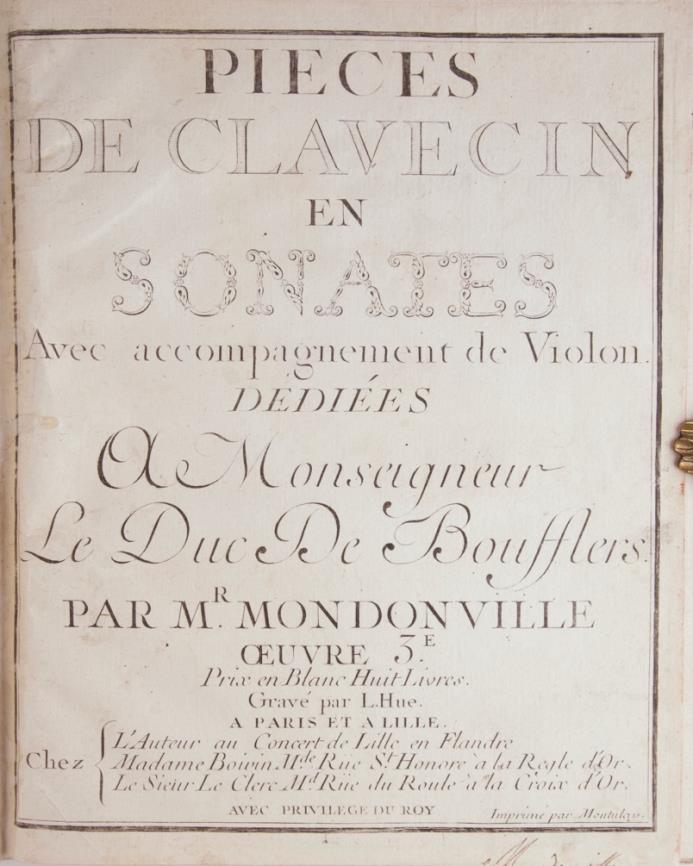
“A Pioneer Position ... in the History of the Accompanied Keyboard Sonata and ... the Ultimate Duo for Piano and Violin”
34 MONDONVILLE, Jean-Joseph Cassanea de 1711-1772
Pieces de Clavecin en Sonates Avec accompagnement de Violon Dediees A Monseigneur Le Duc De Boufflers. Oeuvre 3E. Prix en Blanc Huit Livres. Gravé par L. Hue. [Score].
A Paris et a Lille: L'Auteur au Concert de Lille en Flandre; Madame Boivin Mde. Rüe St. Honore à la Regle d'Or; Le Sieur Le Clerc Md. Rüe du Roule à la Croix d'Or. Avec Privilege du Roy. Imprimé par Montulay, [1737-1739].
Folio. Modern halfivory vellum withmarbled boards, decorative cut paperlabel (blank)to upper. 1f. (recto title, verso blank), [i] dedication, pp. 2-37 music, [i] (blank) pp. Engraved. Slightly browned; trimmed, not affecting notation; free front endpaper and title repaired at inner margin with resulting creasing; signature to title significantly trimmed
With composer's autograph controlsignature tofoot oftitle;contemporarymusicseller's printed labelto front pastedown. In very good condition overall.
Contains 6 sonatas for harpsichord with violin accompaniment.
First Edition. Rare. Gustafson and Fuller pp. 179-181. Devries: Edition et Commerce de la Musique Gravée à Paris, p. 225. BUC p. 683. Lesure p. 437. RISM M3024 (one copy only in the U.S).
$1,800
"Mondonville is interesting ... not only as the composer of four superior sets of six ensemble sonatas each, Opp. 1-4, but even more for the pioneer position of his Op. 3 in the history of the accompanied keyboard sonata and of the ultimate duo for piano and violin. ... Although violin sonatas with realized keyboard parts had been composed by Bach and others in the Baroque Era ... and although doubling of the lines by other instruments had already been invited in the French Pieces de clavecin (as by La Guerre), Mondonville showed in his dedication of Op. 3, about 1734, how well aware he was that he was contributing something new. ... That the public took a special liking to Op. 3 is suggested by the fact that only it among his instrumental sets achieved re-editions while he was alive." Newman: The Sonata in the Classic Era, pp. 617-618. (40507)
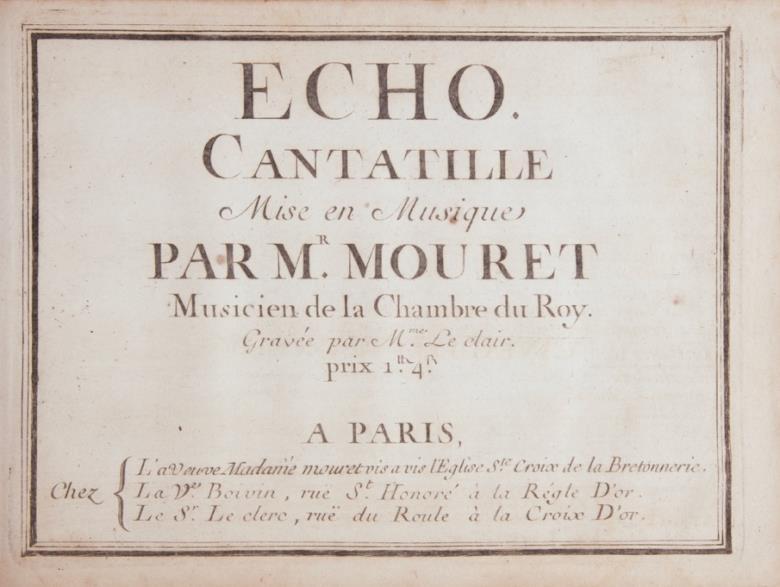
“The Most Popular Composer of the Regency”
35. MOURET, Jean-Joseph 1682-1738
Echo. Cantatille Mise en Musique par Mr. Mouret Musicien de la Chambre du Roy. Gravée par Mme. Le clair. prix 1th. 4
Paris: Chez La Veuve Madame mouret vis a vis l'Eglise Ste. Croix de la Bretonnerie. La Ve. Boivin, ruë St. Honoré à la Régle D'or. Le. Sr. Le clerc, ruë du Roule à la Croix D'or, [ca. 1742].
Oblong quarto. Modern carta rustica, stitched, with decorative cut paper title label to upper. 1f. (recto title, verso "Mémoire Des Oeuvres de Mr. Mouret"), 37-48, [i] (privilege) pp. Engraved. Uniform moderate browning; occasional light soiling and foxing; tissue guard preceding title creased.
Second edition. Rare. Lesure p. 449. RISM M3994 (no copies in the U.S.).
"Many of [Mouret's] motets, cantatas, and cantatilles were composed for performance at the Concert Spirituel, where, as a partner of Pierre Simard, he served as artistic director beginning 9 August 1728; his responsibilities included choosing music, hiring soloists, and beating time. He brought considerable gravitas to the series: the second concert was attended by the duchesse de Bourbon and her courtiers, and guest performers included Annibalino, Giovanni Bononcini, Pierre de Jélyotte, Jean-Joseph Cassanéa de Mondonville, and Giovanni Battista Somis; a fanciful account of the Somis performance was published by Hubert LeBlanc. If frequent mention in the influential Mercure de France is to be taken as measure, Mouret was the most popular composer of the Regency (1715–24). ... Mouret shared in the innovating spirit that characterized the best in French stage
music between Lully and Rameau. ... Mouret's melodic gifts earned him the posthumous title of ‘musicien des grâces’ et de la gaieté’ (preface to Oeuvres de Monsieur Autreau, Paris, 1749)." James R. Anthony, revised by Beverly Wilcox in Grove Music Online. (40580) $200
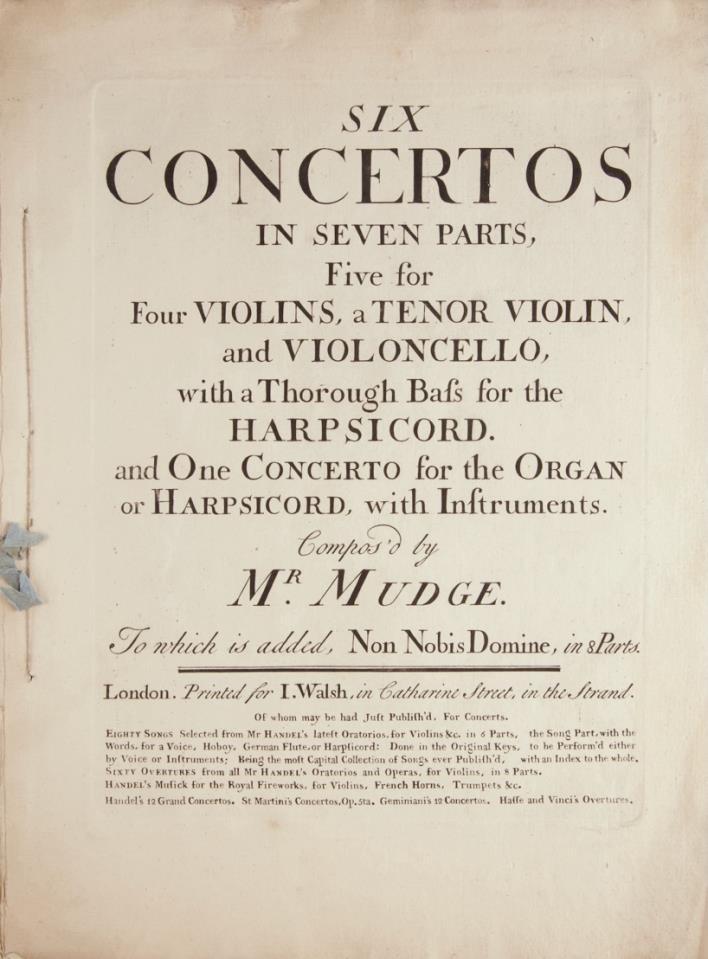
“Several … are of Outstanding Beauty and Dignity”
36 MUDGE, Richard 1718-1763
Six Concertos in Seven parts, Five for Four Violins, a Tenor Violin, and Violoncello, with a Thorough Bass for the Harpsicord. and One Concerto for the Organ or Harpsicord, with Instruments. ... To which is added, Non Nobis Domine, in 8 Parts. [Set of parts].
London: I. Walsh, 1749.
Folio. Contemporary mid-blue paper wrappers. Engraved throughout.
Violino primo concertino: 1f. (recto title, verso blank), [i] (blank), 2-17, [i] (blank) pp., 1f. (recto "Non Nobis Domine," verso blank)
Violino secondo concertino: 1f. (recto title, verso blank), [i] (blank), 2-13, [i] (blank) pp., 1f. (recto "Non Nobis Domine," verso blank) pp.
Violino primo ripieno: 1f. (recto title, verso blank), [i] (blank), 2-15, [i] (blank) pp., 1f. (recto "Non Nobis Domine," verso blank)
Violino secondo ripieno: 1f. (recto title, verso blank), [i] (blank), 2-13, [i] (blank) pp., 1f. (recto "Non Nobis Domine," verso blank)
Viola: 1f. (recto title, verso blank), [i] (blank), 2-13, [ii] (blank), 1f. (recto "Non Nobis Domine" Viola primo, verso "Non Nobis Domine" Viola secondo), [i] (blank) pp
Violoncello: 1f. (recto title, verso blank), [i] (blank), 2-6, [i] (blank), 8-15, [i] (blank) pp., 1f. (recto "Non Nobis Domine," verso blank)
Basso grosso e continuo: 1f. (recto title, verso blank), [i] (blank), 2-6, [i] (blank), 8-25, [i] (blank) pp., 1f. (recto "Non Nobis Domine,” verso blank)
Tromba: [i] (Canon by Mr. Wm. Bird), 2-3, [i] (blank) pp.
Wrappers worn; upper of Violino primo concertino part detached and heavily worn; some dampstaining and creasing. Minor internal wear and soiling.
First Edition. Smith and Humphries 1122, p. 248. BUC p. 714. RISM M7726 (most copies with 7 parts only, one in the Kungliga Musikaliska Akademiens Bibliotek with a supplemental trumpet part for the first concerto, as in the present copy).
Mudge was an English composer and cleric. "Two collections of manuscripts have recently come to light (GBLfom, Mp), and both appear to have their provenance in the Aylesford collection made by Charles Jennens and bequeathed to Lord Aylesford in 1773. Most of their contents appear to be preliminary versions of his published set of Six Concertos (London, 1749). This set was written for two solo violins and string ripieno, but the first concerto has an added trumpet and is in the form of a French overture with a final minuet, and the sixth has a solo keyboard part. The string concertos are all in four movements, slow–fast–slow–fast, though one of the manuscript versions has as many as seven movements. The final item is a five-part Adagio, at the climax of which three voices sing the ‘Non Nobis Domine’ canon, while the strings provide counterpoint. The influence of Handel and Geminiani is evident in the string concertos, and, as Finzi stated, ‘several … are of outstanding beauty and dignity’. The manuscripts suggest that the pieces were probably formulated carefully over a period of time. The variants often have different development sections, and movements are interchanged between the various concertos. No.2 appears not only as a trio sonata but also as a violin sonata ‘compôsta a la gusto del Seignr. Bombardini’ (probably a fictitious name intended as a joke)." Richard Platt in Grove Music Online. (40754) $800
37 MUSSORGSKY, Modest Petrovich 1839-1881
Pictures from an Exhibition for Piano. Facsimile.
Moscow: State Publishers Music, [1982].
Folio. Originalpublisher's full red cloth slipcase withtitlingin gilt. Foldercontaining 3separate bifoliaof textual commentary by Emilia Fried in Russian, English, and German, together with 6 single-sheet illustrative plates in color and a 32-page autograph manuscript facsimile in oblong folio format. (40931) $135
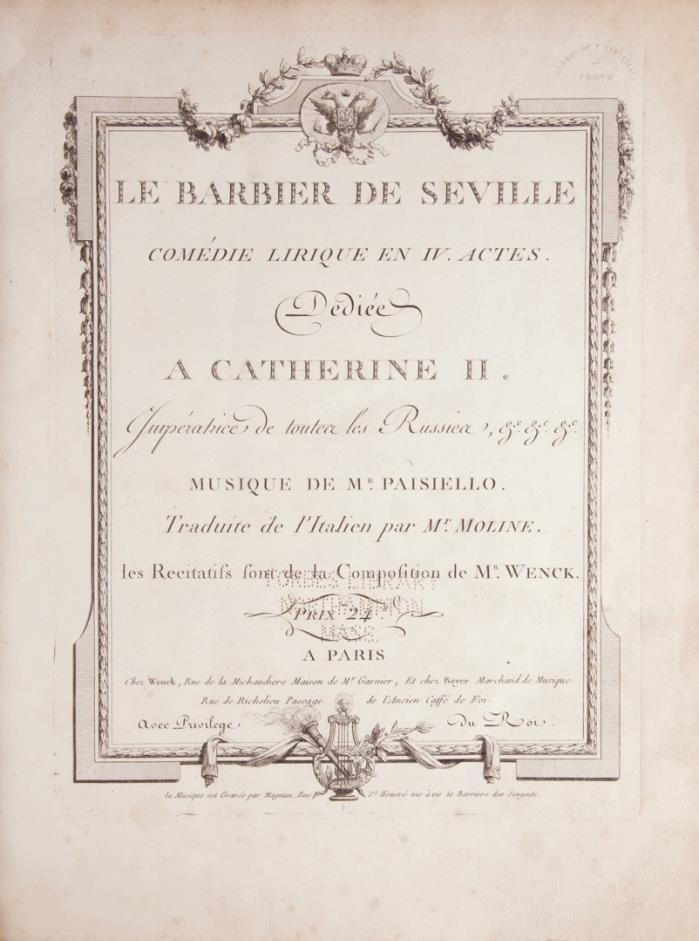
One of the “Best Comic Operas” from “One of the Most Successful and Influential Opera Composers of the Late 18th Century”
38 PAISIELLO, Giovanni 1740-1816
Le Barbier de Seville Comédie Lirique en IV. Actes. Dediée A Catherine II. Impératrice de toutes les Russies, &. &. &. ... Traduite de l'Italien par Mr. Moline. les Recitatifs sont de la Composition de Mr. Wenck Prix 24₶. ... Avec Privilege Du Roi. la Musique est Gravée par Magnian, rue St. Honoré vis à vis le Barriere des Sergents. [Full score].
Paris: Chez Wenck, Rue de la Michaudiere, Maison de Mr. Garnier, Et chez Boyer Marchand de Musique, Rue de Richelieu, Passage de l'Ancien Caffé de Foi, [ca. 1786].
Folio. Full contemporary green vellum with "Mme Cartier" gilt to upper, titling in manuscript in white ink to spine. 1f. (recto title within decorative border incorporating the coat of armsof CatherinetheGreatandatorch, lyre, and floral motifs, verso blank), 1f. (recto dedication to Catherine II, verso "Avertissement du Traducteur"), [i] ("Acteurs"), [ii] (privilege dated 8 February 1785), [i] (blank), 316 pp. Engraved.
Ownership blindstamp of Joaquin de Vasconcellos to upper outer corner of title. With bookplate of the Forbes Library, Northampton, Massachusetts with "withdrawn" stamp to front pastedown and their perforated stamp to title; accession number in pencil to upper inner corner of dedication, "VYO11P166b", and in ink to slip of paper laid down to rear pastedown; handstamp "Oct 19 1899" to inner margin of dedication and "Forbes Library Northampton Mass." to foot of p. 93 Binding worn and rubbed, corners and spine reinforced with dark blue tape; call number to spine Light to moderate browning, occasional light foxing and small stains; paper repair to blank inner margins of pp. 154-155; several small tears with minor loss. In very good condition overall.
Robinson: Giovanni Paisiello: A Thematic Catalogue of His Works, p. 314, Variant7 (5copies): "French variant containing all items of Version 1 minus No 05. Different French translation (by Pierre Louis Moline) from the one in Variant 6 ... The Italian simple recitatives are here replaced by accompanied recitatives composed by August Heinrich Wenck." Lesure p. 476. Not in BUC. RISM P195 (3 copies in the U.S., at the Harvard Musical Association, Forbes Library [the present copy], and Vassar College).
First performed in its original form in St. Petersburg at the Hermitage on the 15 (or 26) September 1782 and subsequently in a revised version at Versailles on 14 September 1784.
"[Paisiello] was one of the most successful and influential opera composers of the late 18th century. ... In Russia, where he was composing for a court in which Italian was not the normal spoken language, he had to make his music good enough to compensate for any lack of understanding of the libretto. As a result his powers of musical characterization sharpened, his orchestration became more colourful, and his melodies acquired extra warmth. At this time there appeared in his melodic style certain turns of phrase reminiscent of Mozart. (Paisiello’s
influence on Mozart, who heard his Il re Teodoro in Venezia in Vienna in 1784 and probably his Il barbiere di Siviglia in 1783, is evident in parts of Le nozze di Figaro and Don Giovanni) ...
The works that retained their popularity longest were his best comic operas, including Il barbiere di Siviglia." Michael F. Robinson in Grove Music Online. (40648) $800
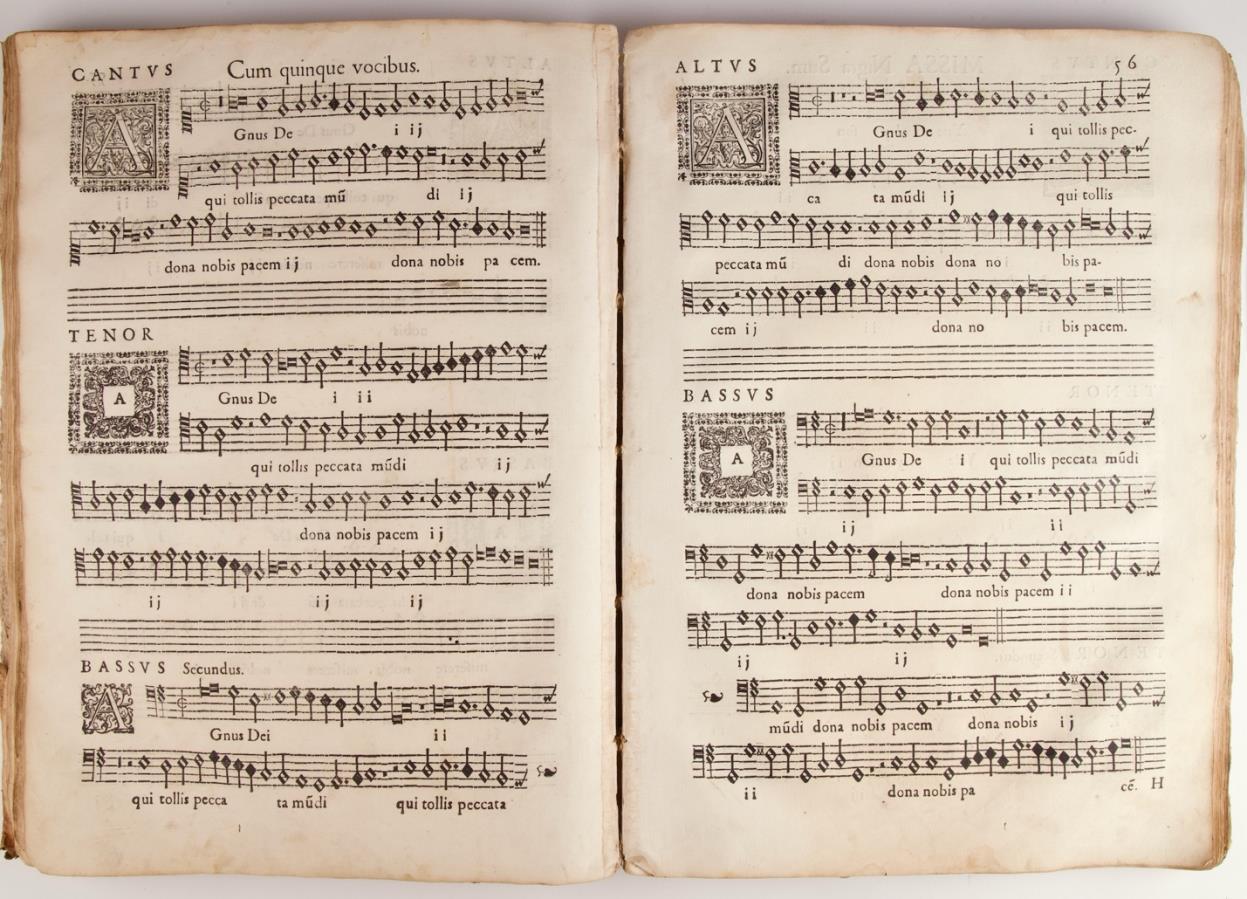
Rare Collection of 8 Masses Published During the Composer’s Lifetime
39 PALESTRINA, Giovanni Pierluigi da 1525 or 1526-1594
Missarum liber quintus, quatuor, quinque, ac sex vocibus concinendarum nunc denuo in lucem editus. [Choirbook].
Rome: Francesco Coattino "sumptibus Iacobi Berichiae," 1590.
Large folio (46x 32cm). Early sheep overcarta rustica. 1f. (recto dedication, verso music)+ 152leaves ofmusic printed on 5-line staves in diamond-head notation. With fine large decorative initials throughout.
Contains a total of eight masses: four for 4 voices, two for 5 voices and two for 6 voices, as follows:
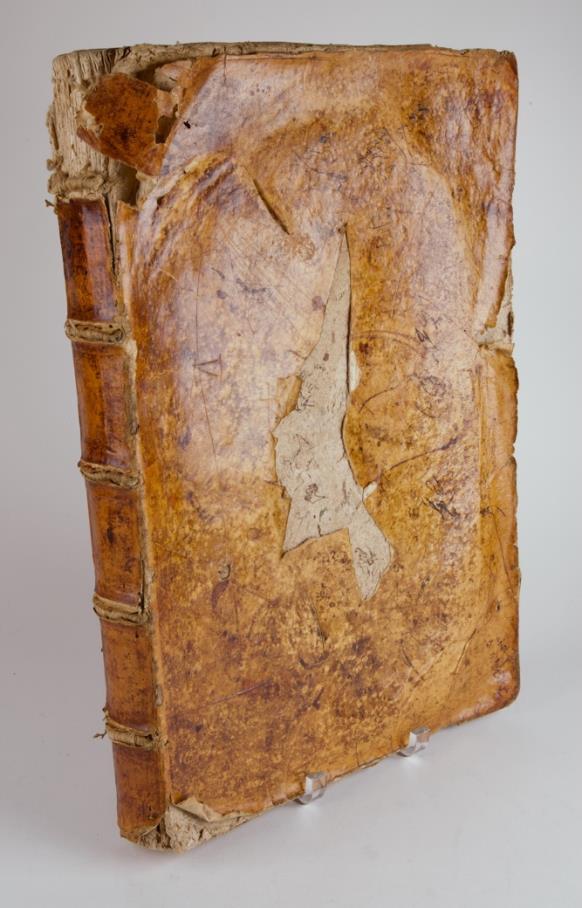
1. Missa Aeterna Christi munera a 4
2. Missa Iam Christus ad astra ascenderat a 4
3. Missa Panis quem ego dabo a 4
4. Missa Iste Confessor a 4
5. Missa Nigra sum a 5
6. Missa Sicut lilium inter spinas a 5
7. Missa Nasce la gioia mia a 6
8. Missa Sine nomine a 6
Occasional early annotations within music.
Early manuscript annotations to recto of free front endpaper, with early manuscript notes in Latin both there and to foot of dedication indicating that the present copy was used by an ecclesiastical community associated with the name "Pereti,"; early musical notation to verso of free front endpaper and rear pastedown.
Early manuscript notes in Latin to foot of verso of final leaf, possibly relating to performances on the ninth day before the Calends of Sextilis (August), 1638, and to the teaching of singing to one "Joannes," with later 4-line verse in Italian below.
Considerable signs of use. Binding quite worn; front pastedown lacking; one-third of free front endpaper lacking; rear free endpaper lacking; rear pastedown mostly lacking. Tears, some major, to anumber ofleaves; light browning and soiling; light to moderate dampstaining and worming; tears, some major, to a number of leaves; some leaves with old guarding to gutter; edges of first ca. 16 leaves frayed.
Lacking title-leaf and portions of other leaves, some repaired with music lost added in early manuscript.
First Edition. Rare. Marvin: Palestrina, A0016. Pyne: Palestrina, p. 200. BUC p. 759. Lesure p. 480. RISM P670 and PP670 (1 copy in the U.S., at the University of California, Berkley).
This is the fifth (of six) collections of masses by Palestrina published during his lifetime
"[Palestrina] ranks with Lassus and Byrd as one of the towering figures in the music of the late 16th century. He was primarily a prolific composer of masses and motets but was also an important though conservative madrigalist. Among the native Italian musicians of the 16th century He was primarily a prolific composer of masses and motets but was also an important though conservative madrigalist. Among the native Italian musicians of the 16th century who sought to assimilate the richly developed polyphonic techniques of their French and Flemish predecessors, none mastered these techniques more completely or subordinated them more effectively to the requirements of musical cogency; and no contemporary laboured more successfully to realize the functional and aesthetic aims of Catholic church music in the age of the Counter-Reformation." Lewis Lockwood in TNG Vol. 14, p. 118.
An interesting copy in light of its manuscript additions, signs of use, and provenance (41072) $8,500

“One of the Most Gifted French Composers of His Generation”
40 PHILIDOR, Francois-Andre Danican 1726-1795
Tom Jones Comedie Lyrique en Trois Actes. Représentée par les Comediens Italiens du Roy, pour la premre. fois Le 27 fevrier 1765. Et remise avec des changements Le 30. Janvier 1766. Dédiée A S.A.S. Monseigneur Le Duc Regnant des Deux Pont Prince Palatin du Rhin, Duc de Baviere &c, &c ... Les Paroles de Mr. Poinsinet. Prix en blanc 20₶ Les parties séparée 10₶. Gravé par Le Sr. Hue ... No. 6. [Full score].
Paris: Chez le Duc, successeur de Mr. la Chevardiere, Rue du Roule, à la Croix d'Or, au Magazine de Musique, et d'Instruments, No. 6 [PN 3A], ca. 1781.
Folio. Modern quarter black calf with marbled boards, dark red leather label to spine with titling gilt, yellow edges. 1f. (recto title, verso blank), 172 pp. Engraved throughout. With Le Duc's facsimile signature handstamp to blanklowermargin oftitle. Upperboardvery slightlystained. Uniformlightbrowning;occasionalsmallstains and scattered foxing, mainly to blank margins. A very good, crisp copy overall.
Not in Lesure. BUC p. 780. RISM P1910 (one copy in the U.S. only, at Harvard).
Tom Jones premiered in Paris at the Comédie-Italienne on 27 February 1765.
"Based on the novel by Henry Fielding; the libretto by Poinsinet was revised by Sedaine for the 1766 production. Philidor was "one of the most gifted French composers of his generation." He traveled widely as a chess player, and as a result absorbed Italian and German influences. His cosmopolitan style was considered unsuitable for
the Paris Opera, where serious works were performed, so Philidor turned instead to opera comique, of which he composed 11 between 1759 and 1765, contributing greatly to the development of the genre: "his ensembles demonstrate particular skill and originality. In Tom Jones, the best of his operas comiques, he included a duet in two simultaneous metres, an unaccompanied quartet, and a septet in which confusion is rendered with Mozartian lucidity." TNG Vol. 14 pp. 627-628. (40651) $700
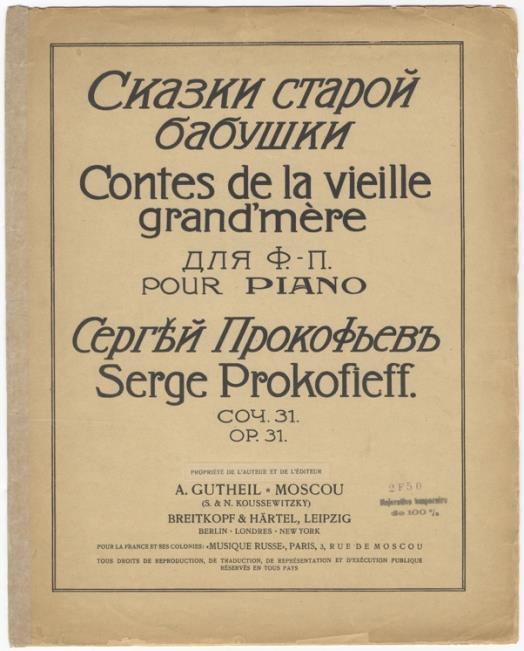
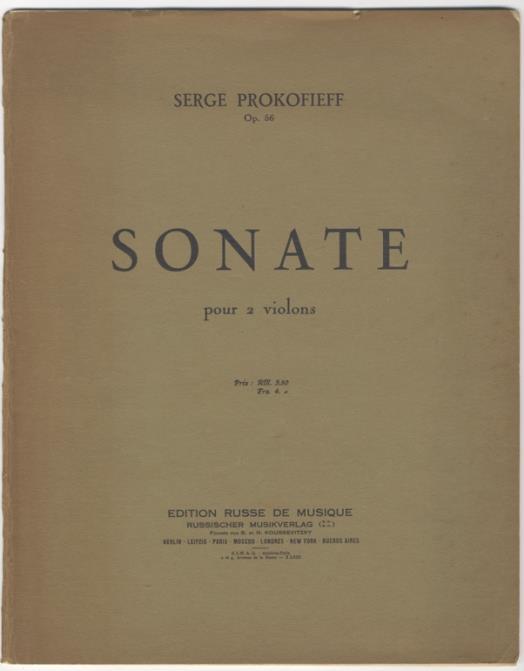
41. PROKOFIEV, Serge 1891-1953
Contes de la vieille grand’mère pour piano ... Op. 31.
Moscou: A. Gutheil [PN A. 10303 G.], [1922].
Folio. Unbound. [i] (title), 2-11, [i] (blank) pp. Title in Russian and French. "Imprimerie de Breitkopf & Härtel, Leipzig" printed to lower right corner of page 2. Spine reinforced with Japanese paper. Uniform browning; edges slightly worn and frayed. Numerous edge tears.
First Edition. Schlifstein p. 576. (40869) $120
42. PROKOFIEV, Serge 1891-1953
Sonate pour 2 violons ... Op. 56 ... Prix: Rm. 3.50. Frs. 4. [Parts].
Berlin, Leipzig ...: Edition Russe de Musique. Russischer Musikverlag [PN R.M.V. 570], [1932].
Folio. Publisher's dark olive green printed wrappers. Slightly worn.
Violin I: [i] (blank), 2-12 pp. Violin II: [i] (blank), 2-11, [i] (blank) pp.
Probable First Edition. Schlifstein p. 582. (40862) $250
43. PROKOFIEV, Serge 1891-1953
Sonata No. 8 Op. 84 Piano Solo ... Price: 9/-
London: Anglo-Soviet Music Press Ltd. Sole Selling Agents: Boosey & Hawkes Ltd. [PN A.S.M.P. 4], 1946.
Folio. Original publisher's dark ivory printed wrappers. 1f. (recto title, verso blank), 3-48 pp. With small rectangular "Presentation" handstamp to head of upper wrapper and "1939-1944" printed to foot of final page. Wrappers detached, frayed and torn at edges.
Published in the same year as the first edition. Schlifstein p. 589. (40850) $30
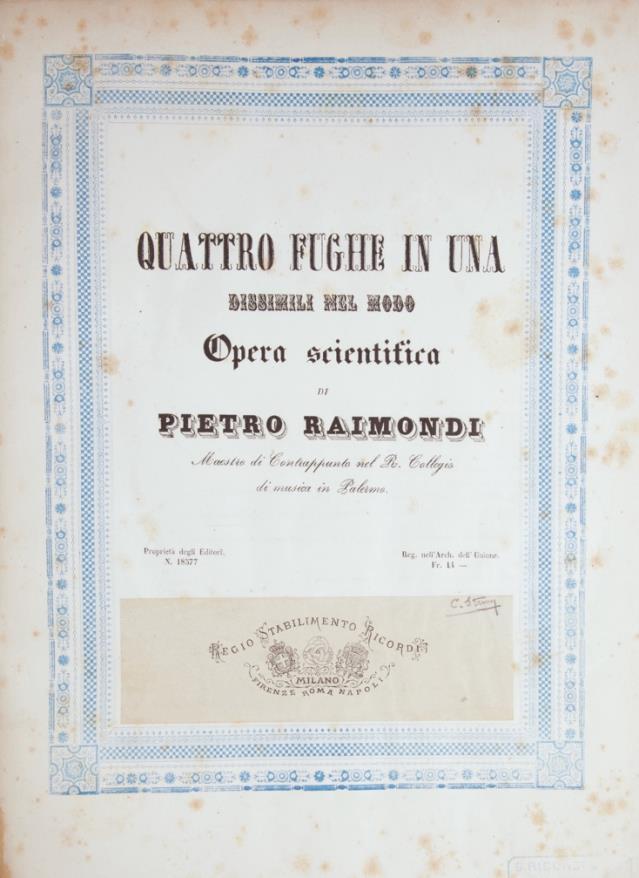
Mid-19th Century Musical Experimentalism
44. RAIMONDI, Pietro 1786-1853
Quattro Fughe in Una Dissimili Nel Modo Opera scientifica di Pietro Raimondi Maestro di Contrappunto nel R. Collegio di musica in Palermo ... Proprietà degli Editori N. 18577 Reg. nell'Arch. dell'Unione Fr. 14.
Milano: Ricordi [PN 18577], [ca. 1846].
Folio. Contemporary dark blue pebbled clothbacked marbled boards with decorative octagonal label to upper titled in manuscript. 1f. (recto title, verso blank), 1f. (recto "Agli Allievi del Reale Conservatorio di musica di Parigi," verso blank), 73 pp. Engraved. Ricordi overpaste to imprint and rectangular handstamp to lower outer corner of title. Occasional annotations in red and lead pencil highlighting clef changes; biographical details in pencil to title. Binding worn, rubbed, and bumped. Title and "Agli Allievi" foxed; gutter of title browned; browning to blank margins throughout; four small binding holes to gutter.
OPAC SBN IT\ICCU\RMR\0283877. OCLC (2 copies, 70722446 at Northwestern University and 498767348 at the British Library).
These four 4-voice fugues are all composed to the text Cum sanctis tuis in aeternum quia pius es. In a striking example of musical experimentalism, Raimondi explains in the remarks, Agli Allievi, that the fugues may all be performed simultaneously. He includes each fugue in its self-contained form, followed by the four fugues stacked each upon the other in full score. The individual fugues and the simultaneous compound-fugue all include organ parts notated on a single stave with figured bass.
"After completing studies with Tritto at the Conservatorio di S Maria della Pietà in Naples, [Raimondi] embarked on a series of operas, mostly comic, for Genoa, Florence, Naples and Rome. ... In June 1833 Raimondi left Naples for Palermo to become director of both the conservatory and the Teatro Carolino. His frequent return visits to Naples, where he continued to receive operatic commissions, soon aroused complaints at both institutions. Rejected in his applications for posts in Paris and Milan, and aware that he was being eclipsed by
Donizetti and Bellini as he had earlier been by Rossini, he turned with renewed interest to sacred music and contrapuntal theory. Around 1836 his first didactic text Bassi imitati e fugati was published, and the same year a messa di gloria for double chorus and double orchestra was performed in Palermo. This was the first in a series of experiments in musical simultaneity which culminated in his ‘triple oratorio’ Putifar-GiuseppeGiacobbe (1847–8), a set of three oratorios to be performed first separately and then simultaneously. The great success of this work led to Raimondi’s appointment in 1852 as maestro di cappella at S Pietro, Rome." Jesse Rosenberg in Grove Music Online (40473) $400
45 RAVEL, Maurice 1875-1937
L'Enfant et les Sortilèges. Fantasie lyrique en Deux Parties par Colette ... Prix net: 1 Fr. [Libretto].
Paris: A. Durand et Fils, Éditeurs. Durand et Cie [PN D. et F. 10741], [after 1925].
Octavo. Original publisher's wrappers printed in red and black. 1f. (recto half-title, verso blank), 1f. (recto title, verso blank), [5]-26 pp. Illustration to upper wrapper by André Hellé (1871-1945). Includes named cast list for both Paris and Monte-Carlo premieres. Stain to upper wrapper, with small publisher's handstamp to lower outer corner. Light uniform internal browning
First Edition, later issue. Orenstein p. 236. Marnat p. 766.
L'enfant et les sortilèges, a “fantaisie lyrique” in one act to a libretto by Colette, was first performed at the Théatre de Monte-Carlo on 21 March 1925 under the direction of Raoul Gunsbourg with choreography by Balanchine. It opened in Paris at the Opéra Comique on 1 February 1926 under Louis Masson and Georges Ribou. (40861) $30
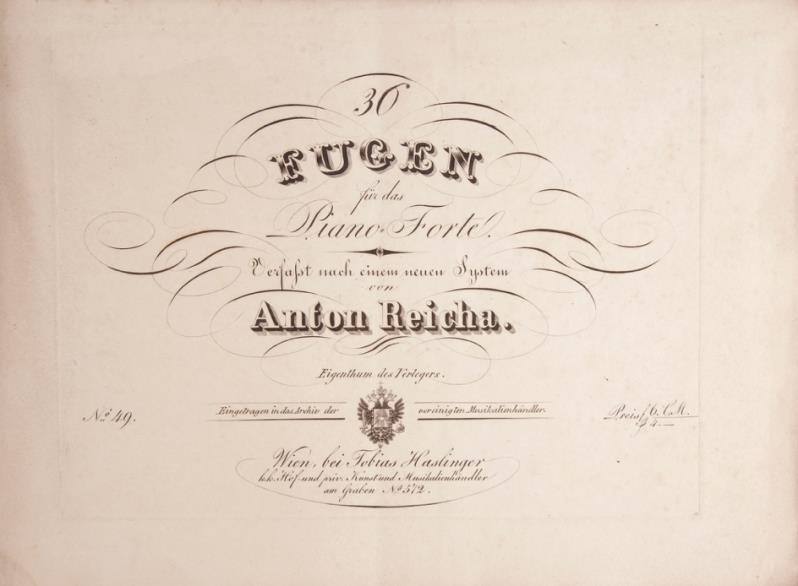
Dedicated to Haydn, “The 36 Fugues ... Subsume Pedagogical Examples Within Artistic Conceptions”
46 REICHA, Antoine 1770-1836
36 Fugen für das Piano Forte Verfasst nach einem neuen System ... Eigenthum des verlegers ... No. 49. Preis f.
6 C.M. B. 4.
Wien: Tobias Haslinger k.k. Hof- und priv. Kunst-und Musikalienhändler am Graben No. 572, [ca. 1828].
Oblong folio. Original dark green publisher's printed wrappers with titling within decorative border. 1f. (recto title, verso blank), 127, [iv] (remarks on selected fugues) pp. Title engraved, music lithographed, remarks typeset. Wrappers very slightly worn and creased. Occasional minor wear and foxing; binders' holes to blank inner margin of several leaves. In very good condition overall.
Second edition. Šotolová: Antoní Reicha: A Biography and Thematic Catalogue, pp. 242-248.
Reicha borrows themes from several composers including Haydn (No. 3), Bach (No. 5), Mozart (No. 7), Domenico Scarlatti (No. 9), and Frescobaldi (No. 14). He also experiments with harmony, as in No 8 (a "Cercle harmonique") and No. 25 where, instead of the traditional tonic-dominant-tonic pattern for the fugal entrances, the fugal entrances proceed in major keys at a distance of a major third from one another (D major to B-flat major to F-sharp major). In the 25th fugue, perhaps even more arresting than the harmonic patterns themselves is the contrast between the extreme quality of those patterns and the nursery-rhyme-like nature of the fugue's theme.
Reicha was a Czech composer active in France and Austria. "Though a prolific composer, he was of particular importance as a theorist and teacher in early 19th-century Paris. ... In Reicha’s output some individual works defy classification as purely musical, theoretical or didactic; this resulted, no doubt, from his Hamburg meditations. Like L’art de varier and Bach’s didactic works, the 36 Fugues (1803, dedicated to Haydn) subsume pedagogical examples within artistic conceptions. No.13 offers modal principles in which cadences are possible on all but the 7th degree of the scale without further alteration; nos.20, 24 and 28 contribute ‘combined metre’ (e.g. 6/8 + 2/8), while no.30 displays polymetre. Beethoven owned a copy of these fugues; though he wrote of them that ‘the fugue is no longer a fugue’, changes in his style (e.g. Variations op.35) may derive from Reicha’s ideas on variation and fugue. The exchange of ideas between them was probably reciprocal." Peter Eliot Stone in Grove Music Online. (40501) $550
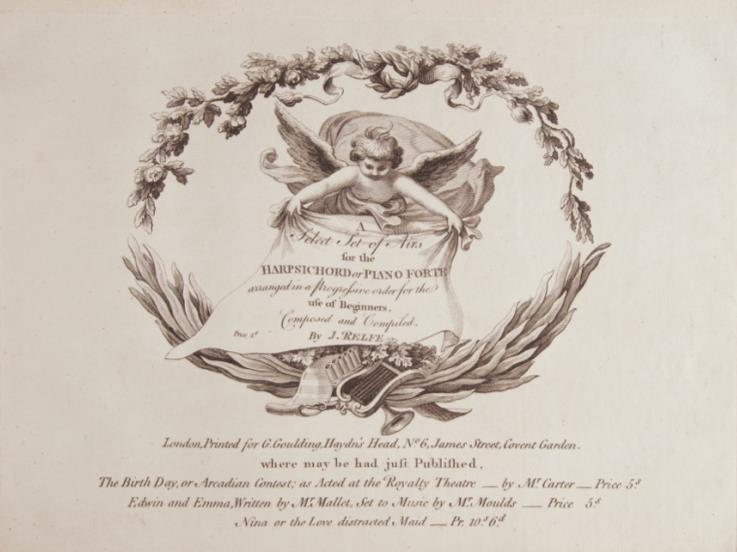
Influenced by Haydn
47 RELFE, John 1763-1836
A Select Set of Airs for the Harpsichord or Piano Forte arranged in a progressive order for the use of Beginners ... Price 4s. [Hob. I:75; XXVIII:8/1b; I:85].
London: G. Goulding, Haydn's Head, No. 6, James Street, Covent Garden, [1787].
1f. (recto decorative engraved title incorporating winged putto, ruled music paper, lyre, panpipe, and trumpet within a floral wreath, verso blank), 19 pp. Engraved. Occasional light pencil annotations including dynamics and x marks. BUC, p. 885. RISM R1133 (recordingtwo copies in the UK, at DundeePublicLibrariesand British Library). Contains many pieces drawn from the works of Haydn, Lesson XX from his Symphony in D major, Hob I:75; Lesson XXII from his La vera costanza (Signori via calmate l'affanno ed il timor), Hob XXVIII:8/1b; and Lesson XXIII from his Symphony in Bb major (the Romanza), Hob. I:85.
Bound with:
BACH, Johann Christian 1735-1782 attributed to Sonata pour le Clavecin ou Forte Piano qui Represente La Bataille de Rosbach ... N.B. Dans cette Sonata La Musique vous montre Le Commencement d'une Bataille le feu des Cannons et Mousqueterie, L'Ataque de La Cavalerie et les L'Amendations des Blessées. Londres: Jackson and Smith, [?]1782. [i] (title), 2-5 pp. Engraved. Spurious; variously attributed to C.P.E. Bach, Carl Heinrich Graun, Franz Joseph Haydn, and Brixi. Terry p. 343. Warburton YA 51, p. 481. BUC p. 74.
Folio. Half dark brown mottled calf with marbled boards, titling gilt to spine. Free endpapers browned. Occasional minor soiling and foxing, mainly marginal.
Relfe was a composer and music theorist active in London; he is recorded as being in the King's Band in 1810. (40472) $500
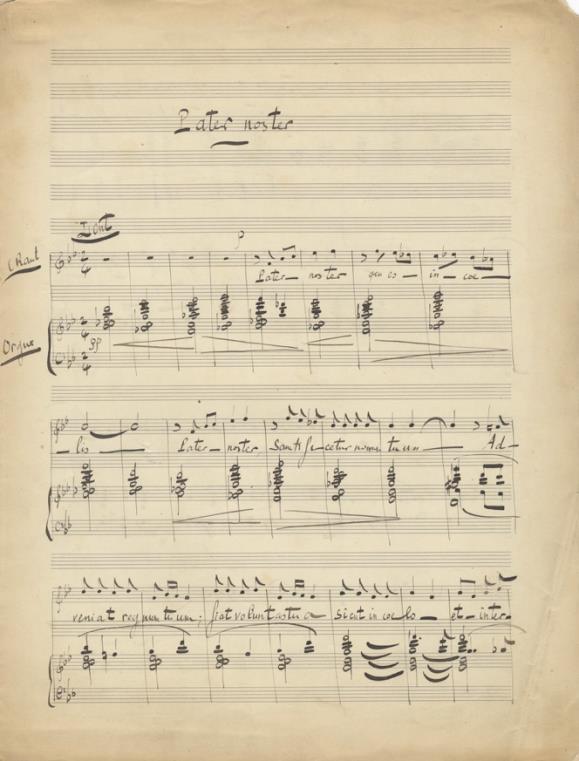
Autograph Manuscript of an Apparently Unrecorded Work
48. RICHEPIN, Tiarko 1884-1973
Pater noster. [Autograph musical manuscript].
France, ca. 1930.
Folio (268 x 346 mm). Notated in brown and black ink on 20-stave music paper. 4 pp. Scored for voice and organ, marked "Lent." Slightly browned and soiled; very minor loss to blank upper outer corners; lower outer corners creased.
Signed in full by the composer at conclusion
Apparently unrecorded.
The music, in B-flatmajor, features a flowing melody that unfolds over a slow-moving series of organ chords; the organ part rarely strays from the soprano and alto registers, as if residing permanently in a celestial realm. The composer's detailed instructions for dynamics and frequent use of crescendi and descrescendi heighten the piece's drama and puts its structure into sonic relief for the listener.
French composer Richepin producedmusicfor opera, theater, andfilm. Hewas alsoasongwriter forwell-known singers including Jeanne Aubert and Damia.
A hauntingly beautiful and deceptively simple piece of sacred music. (40876)
$375
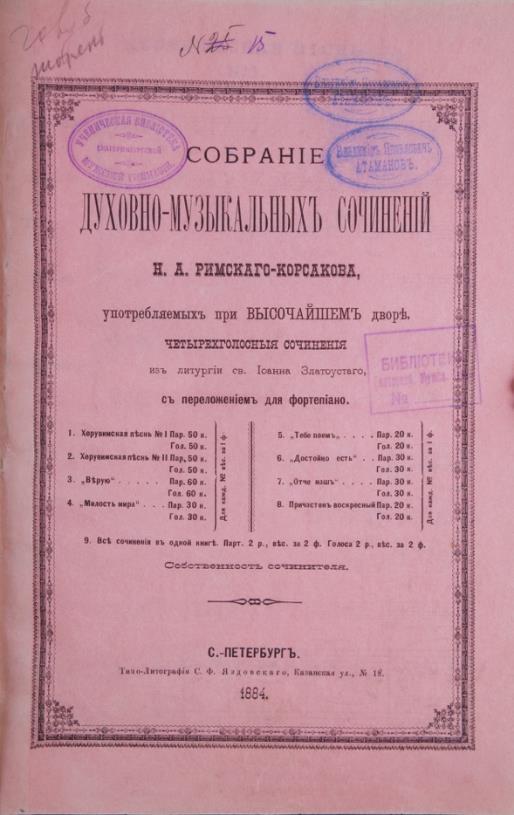
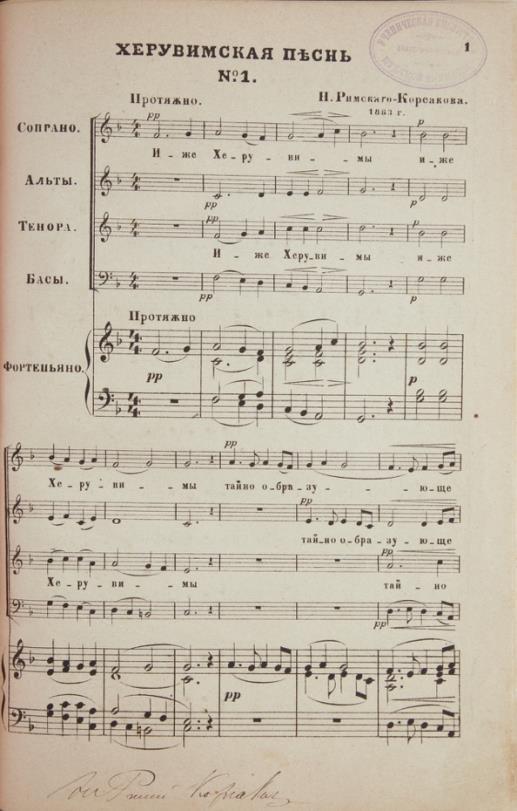
“Anticipating the Ideas of the So-Called New Trend in Church Music”
49. RIMSKY- KORSAKOV, Nikolay Andreyevich 1844-1908
[Liturgiya sv. Ioanna Zlataustra] собрание
сочинений [Collection of spiritual and musical works. 8 settings from the Liturgy of John Chrysostom for SATB, op. 22].
St. Petersburg, 1884.
Octavo. Full modern olive green cloth with printed title label to spine with original publisher's pink wrappers with titling within decorative border bound in. With inauthentic early signature of the composer to foot of first page of music. Three early oval Russian handstamps and one rectangular Russian handstamp to upper wrapper; "N 15" [with "25" crossed out] in contemporary manuscript in ink and brief annotations in pencil to head. With bookplate of noted music collector David Wolman to front pastedown. Wrappers slightly worn and creased. Minor browning; oval handstamp to head of p. 1.
First Edition. Rare
"In 1883 [the year the present piece was composed] Rimsky-Korsakov became Balakirev’s deputy at the Court Kapella. His duties led him to explore Russian church music for the first time. During their formative years, The Five had displayed no interest in Russian Orthodoxy and did not venture to explore the nationalist potential of its music, perhaps under the influence of Stasov, their ideologue, who was a staunch atheist. Even Balakirev, who became an ardent believer, produced little church music himself – perhaps the restrictions of writing for male a cappella choir did not attract him. Rimsky-Korsakov’s sacred output from this period was more enterprising: in his arrangements of the old znamennïy chants that were coming into vogue, he explored the possibilities of strict diatonicism and departed from the customary four-part texture, anticipating the ideas of the so-called New Trend in church music (espoused by Kastal′sky, Rachmaninoff and others)." Marina FrolovaWalker, and Mark Humphreys in Grove Music Online
The group of the noted Russian composers known as The Five included Rimsky-Kosakov, Balakirev, Cui, Mussorgsky, and Borodin. Perhaps the best-known of Rimsky-Korsakov's compositions is the symphonic suite Scheherazade, a notableexampleofthecomposer'sfrequentuse offairy-taleandfolksubjects. (40530) $250

With Striking Chromolithographic Title Page
50. RIMSKY-KORSAKOV, Nikolay Andreyevich 1844-1908
Concerto (Ut # mineur) pour le piano avec accompagnement d'orchestre ... Op. 30 ... á la mémoire de François Liszt ... Partition d'orchestre ... Pr. M6/R.210 ... 1886. [Full study score].
Leipzig: M. P. Belaieff [PN 26], ca. 1901.
Quarto. Original publisher's printed wrappers with texttoupperwithindecorativeborderinRussianand French. "C. G. Röder G. m. b. H., Leipzig" printed to foot of lower wrapper. Publisher's catalogue to verso of upper and rectoand verso of lower wrapper. 1f. (recto attractive chromolithographic title by Röder, verso blank), 82 pp. Wrappers worn; torn, and detached. Minor internal wear; previous owner's signature in blue pencil blank upper margin of title.
First Edition, later issue (date inferred from publisher's catalogue). Davis: The Beauty of Belaieff, 2nd edition, p. 243. Sonneck: Orchestral Music, p. 375. (40851) $300
“Achieved Instant Success”
51. ROUSSEAU, Jean-Jacques 1712-1778
Le Devin du Village Interméde réprésenté a Fontainebleau Devant leurs Majestés les 18. et 24. Octobre 1752. Et a Paris par l'Academie Royale de Musique le 1er Mars 1753 ... Gravé par Melle. Vandôme, depuis la 1re Planche jusqu'a la 50. Prix 9₶. [Score].
Paris: Chez Mdme. Boivin rue St. Honoré à la Regle d'Or. Mr. le Clerc, ruē du Roule à la Croix d'Or. Melle. Castagnerie, ruë des Prouvaires. Et à la Porte de L'Opera. Avec Privilege du Roy, 1753.
Folio. Quarter modern mottled ivory vellum with marbled boards, dark red title label to spine gilt, marbled endpapers. 1f. (recto title, verso blank), 1f. (recto dedication, verso "Avertissement"), 95 pp. Engraved. With "Made. de Dumont" in contemporary manuscript to blank inner margin of title; "Cette partition m'a été donnée par Mr. Beaudot, à Rougemont le 4 [?]bre 1853 ..." in contemporary manuscript to head of blank verso of title; list to blank verso of final page of music including "8 chemise 9 mouchois ...". Binding slightly rubbed and
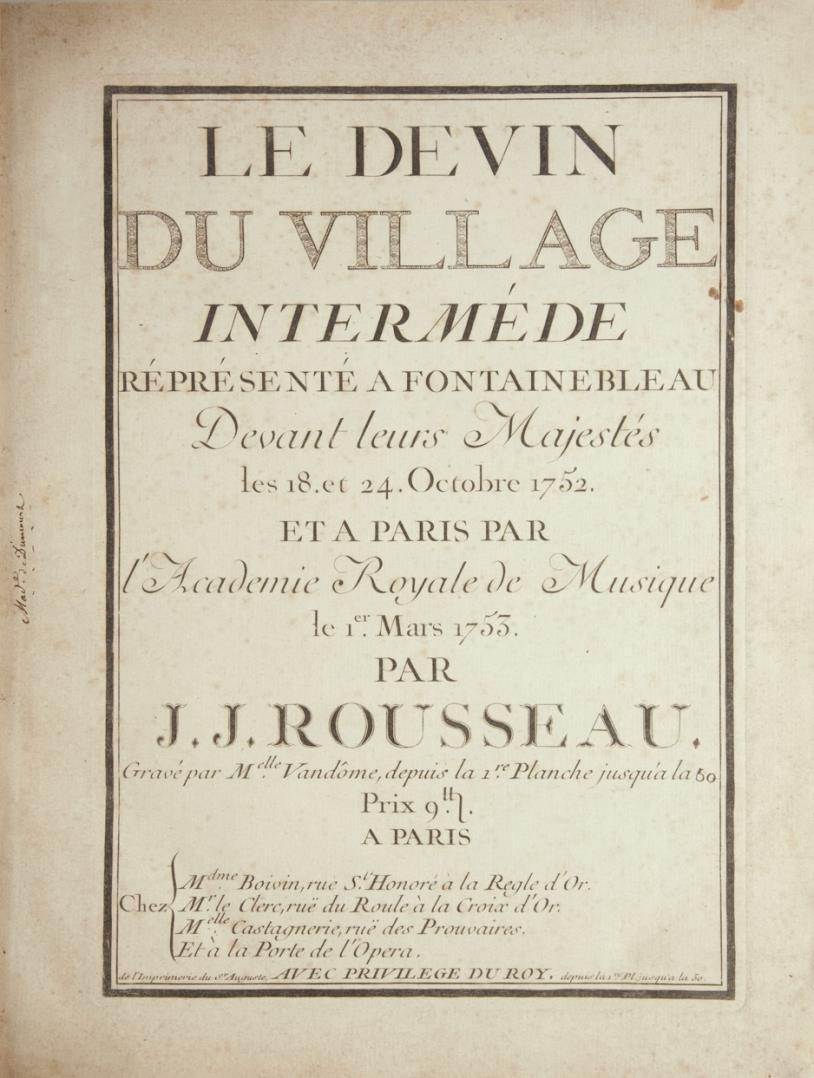
bumped. Mostly minor small stains, foxing, and soiling, mainly to blank margins; blank margins of title foxed and soiled; dampstaining to blank upper margin of dedication.
First Edition. Lesure p. 550. Loewenberg 217. BUC p. 904. Hirsch II, 821. RISM R2899.
Rousseau was a "Swiss philosopher, theorist and composer. He studied music with Le Maître in Annecy, and taught himself by reading and annotating Rameau’s Traité d’harmonie. He also gave music lessons in Neuchâtel, Lausanne and Chambéry (‘I was unconsciously learning music as I taught it’, Les confessions, book 4). ... Rousseau’s first operatic success came in October 1752, with Le devin du village, first performed at Fontainebleau before the court and taken up again soon afterwards by the Académie Royale de Musique (March 1753). It is a relatively short work, with only three characters: Colin, Colette and the Soothsayer (‘Le devin’), and though based on the Italian intermezzo, it merits the designation opera from the fact that it is entirely sung, with recitative over a continuo bass and songs accompanied by the violin, flute and oboe. It achieved instant success and stayed in the Opéra’s repertory for 60 years." Catherine Kintzler in Grove Music Online
A seminal work in the history of French opera. (40663) $1,300
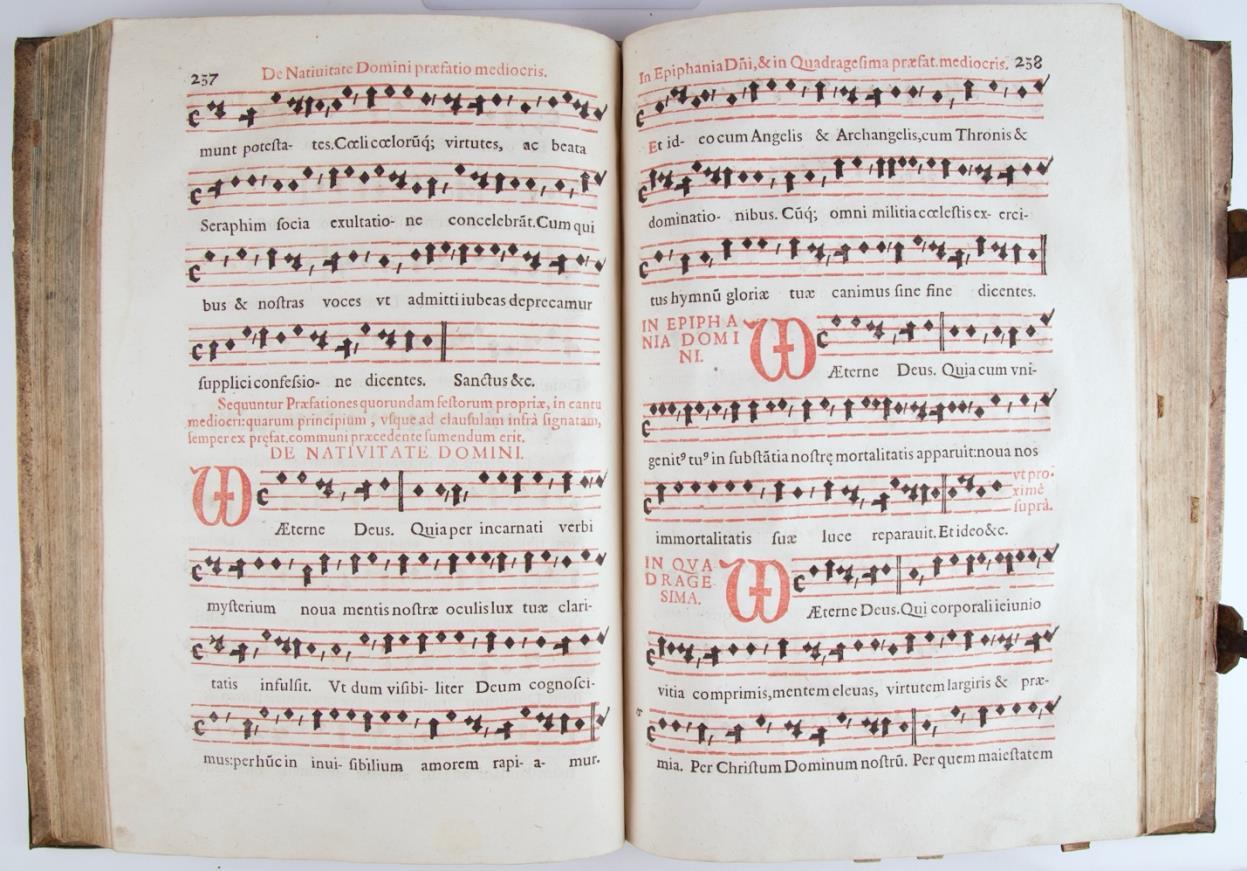
16th Century Missal in a Highly Attractive Binding
52. [SACRED MUSIC - 16th Century]
Missale Secundumritum Ecclesiæ Brixinensis restitutum: Rubricis et Quibusdam aliis ex Romano petitis, illustratum & auctum.
Monachii [Münich]: Excudebat Adam Berg Typographus Ducalis, 1592.
Thick folio. Elaborately tooled full ivory pigskin incorporating numerous small allegorical portraits, metal corners, andclasps. 1f. (recto woodcuttitle with borderincorporating portraits of saints, verso full-pagewoodcut printer's device), 8ff., 24 pp., 1-235 (with pagination "235" duplicated), 236-255 pp., 256-305 pp., 1f. (blank). Music to pp. 219-251 in black Hofnagel notation on 4-line staves printed in red. With an additional 5 leaves on vellum following p. 255, including 3 pp. with musical notation . With Proprium Missarum de Sanctis, 170 pp., 1f. (blank) and Commune Sanctorum, 98 pp. 1f. (recto full-page colophon, verso blank). Numerous historiated and decorative woodcut initials throughout in varying sizes and large woodcut liturgical calendar with central sun device and winged heads to corners to preliminary leaf. Text printed in two columns in red and black. Small 20th century bookplate "Ad Bibliothecam Seminarii Episcopalis Brixinensis" to front pastedown and "8361" in manuscript. Notes in sepia chalk to verso of final leaf and rear pastedown. Binding slightly worn, warped, and soiled, with cuts to two small areas to upper; upper portion of lower clasp lacking; pastedown endpapers slightly worn and foxed; free endpapers lacking; edges dusty. Occasional signs of wear, soiling, and foxing; some mispagination; remnants of vellum tabs to several leaves; blank outer margin of pp. 217/218 repaired with archival tape; minor loss to blank outer margin of pp. 288/289; Proprium Missarum de Sanctis with tear to pp. 99/100 repaired with archival tape; Commune Sanctorum with tear to blank outer margin of pp. 37/38 repaired with archival tape. Lacking the fourth of the preliminary leaves (recto Nova Reformata, verso
Elucidato Calendarii) and pp. 81-84 (g5-g6) of the Commune Sanctorum, supplied in reduced photographic images.
Weale and Bohatta: Bibliographia Liturgica Catalogus Missalum Ritus Latini, 209.
"Proper feasts were objects of alteration-and for a wide variety of factors. The Tyrolean diocese of Brixen (today Bressanone in Italy) offers its own model of local accommodation to Roman liturgical requirements. Brixen, for its part, was among the very few dioceses which reprinted their own liturgical books to submit for Roman approval. In 1592 the order of Bishop Cardinal Andrew of Austria, bishop of Brixen and Constance and member of the Habsburg nobility, allowed for the production of a Missal "according to the Brixen rite"." Ducreux, Louthan, and Thomas, eds.: Print Culture at the Crossroads, Liturgical Books after the Council of Trent, p. 118.
A remarkably well-preserved example of a 16th century missal in an attractive binding. (41013) $2,250
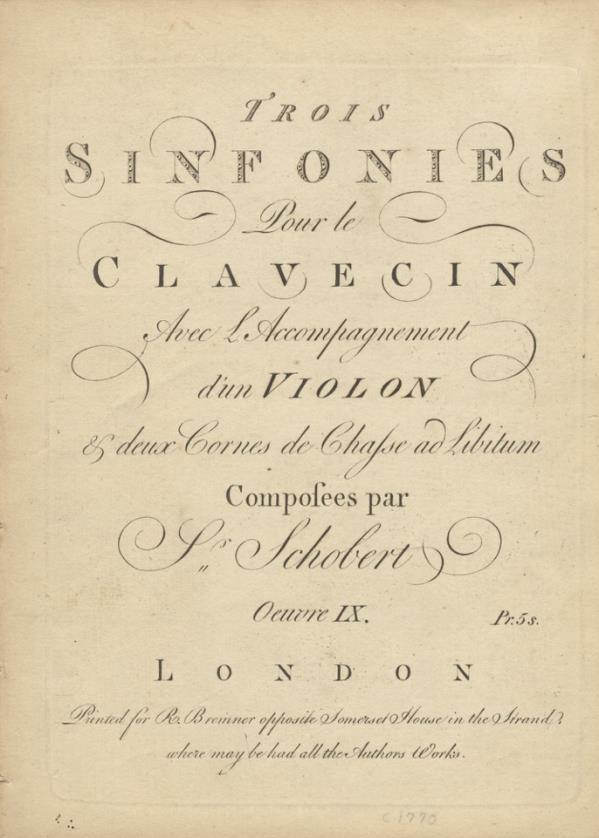
Schobert’s Opus 9
53 SCHOBERT, Johann ca. 1735-1767 Trois Sinfonies Pour le Clavecin Avec L'Accompagnement d'un Violon & deux Cornes de Chasse ad libitum ... Oeuvre IX. Pr. 5s. [Keyboard part only].
London: R. Bremner opposite Somerset House in the Strand, [ca. 1770].
Folio. Disbound. 1f. (rectotitle, versoblank), [i](blank), 21, [i] (blank) pp. Engraved. Occasional soiling and foxing; small stains to blank margins.
Second edition. BUC p. 931. RISM S1963.
Schobert was a Silesian harpsichordist and composer. "Nothing definite is known of his life until his appearance in Paris in 1760 or 1761 and his employment in the service of the Prince of Conti. For several years thereafter he published instrumental music which was engraved at his own expense (and probably in his own home) and distributed to the various Parisian dealers – an arrangement no doubt made possible by his position with the Prince de Conti, which shielded him from the exploitation of publishers. ...
Schobert greatly influenced Wolfgang Amadeus Mozart, who admired his music warmly. The work which most impressed the seven-year-old composer seems to have been the D major Sonata of op. 3; imitation of this sonata and others can be traced in Mozart’s subsequent Parisian and English sonatas. Movements from Schobert’s sonatas also appear recast in Mozart’s earliest piano concertos. His fascination for Schobert’s music was not merely fleeting: when Mozart was in Paris in 1778 he taught his pupils Schobert’s sonatas, and the A minor Sonata k310, composed in Paris, contains in its Andante an almost literal quotation from a movement of Schobert’s op. 17 no.1 that Mozart had already arranged years before in a concerto.
Schobert’s compositions reveal a skilled and imaginative artist. Several works in their entirety, and several individual movements, possess a spontaneity and freshness of expression that still make an impact. ...
Schobert’s significance rests not in the quality of his music but rather in his development of formal and stylistic features which found their complete expression in the closing years of the 18th century and in the opening decade of the 19th. He was one of the few composers who were capable of producing an individual idiom that went beyond the accepted style of the day. In his particular area, that of keyboard music with accompanying instruments (often ad libitum), he discovered new forms and means of expression as important as the innovations produced in other European centres between 1750 and 1775." Herbert C. Turrentine in Grove Music Online (40667) $275 Opus 10

54. SCHOBERT, Johann ca. 1735-1767
Trois Sinfonies Pour le Clavecin Avec
L'Accompagnement d'un Violon & deux Cornes de Chasse ad libitum ... Oeuvre X. Pr. 5s. [Set of parts].
London:R. Bremner, oppositeSomersetHouseStrand, [ca. 1770].
Folio. Disbound. With "Schobert Opera 10th" in contemporary manuscript to head of first page of music of second horn part. Spine of violin part reinforced with paper tape; slightly browned; occasional minor foxing and small stains.
Clavecin: 1f. (recto title, verso blank), 13, [i] (blank) pp.
Violino: [i] (blank), 2-5, [i] (blank) pp. Corno primo:[i] (blank), 2-3, [i] (blank) pp. Corno secondo: [i] (blank), 2-3, [i] (blank) pp. Engraved.
Probable second edition. BUC p. 931. RISM S1970 (1 complete copy only in the U.S., at the University of California, Berkeley). (40665) $550

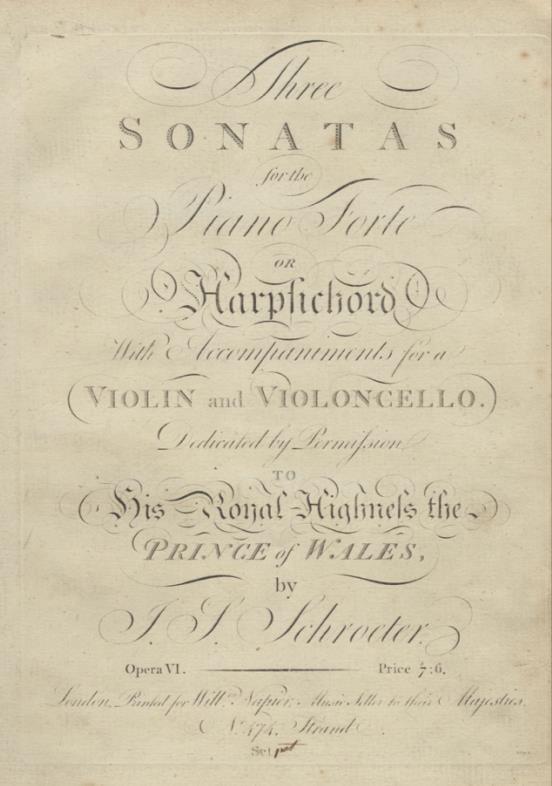
55. SCHOBERT, Johann ca. 1735-1767
Trois Sinfonies Pour le Clavecin Avec L'Accompagnement d'un Violon & deux Cornes de Chasse ad libitum ... Oeuvre X. Pr. 5s. [Keyboard part only].
London: Longman and Broderip No. 26 in Cheapside, ca. 1780.
Folio. Disbound. 1f. (recto title, verso blank), 13, [i] (blank) pp. Engraved. Slightly worn and soiled; occasional light foxing to blank margins; first leaf partially detached at head.
Early edition. BUC p. 931. RISM S1971. Printed from the same plates as the ca. 1770 Bremner edition, with different title but identical text, excepting imprint. (40666) $200
Music Master to Queen Charlotte After J.C. Bach’s Death
56 SCHROETER, Johann Samuel 1752-1788
Three Sonatas for the Piano Forte or Harpsichord With Accompaniments for a Violin and Violoncello. Dedicated by Permission to His Royal Highness the Prince of Wales ... Opera VI. Price 7s: 6. Set [1st - 2d]. [Score].
London: Willm. Napier, Music Seller to their Majesties, No. 474, Strand [PN 157], [ca. 1785].
2 volumes bound together. Folio. Disbound. Engraved. Occasional fingerings in pencil. Very slightly worn and foxed; occasional small tears and creases. Each set contains three sonatas for a total of six sonatas
First set: 1f. (recto title, verso blank), [i] (blank), 2-29 pp. Second set: 1f. (recto title, verso blank), [i] (blank), 30-53 pp.
This edition not in JISC or BUC, and may pre-date the edition listed there
OCLC 497706513 (both sets, at the British Library, and the Collecties Nederlands Muziek Instituut). BUC p. 933 (the 1785 set of six sonatas together). RISM S2196 (1 copy only of the second set, at the Bayerische Staatsbibliothek).
Schroeter, a German pianist and composer, "received his earliest musical instruction from his father, and studied with J.A. Hiller in Leipzig from about 1763. Early chroniclers suggested he studied with C.P.E. Bach, but there is no evidence to support this. ... Through the intervention of J.C. Bach, Schroeter gained the protection and interest of the English court, where he made a great impression. On Bach’s death in 1782 he was promptly named music master to Queen Charlotte. His public career was cut short, however, when he eloped to Scotland with one of his students. Her wealthy family, apparently distraught by the marriage, settled a yearly allowance of £500 on Schroeter with the proviso that he abandon his career as a public performer. Nevertheless, he subsequently held an appointment with the Prince of Wales (later George IV), regularly performing in his semiprivate concerts, as well as in occasional benefits or concerts of the nobility. Schroeter’s health, apparently never robust, deteriorated rapidly so that he lost his voice altogether and died of a lung disease while still young. His widow, Rebecca Schroeter, later became a student and admirer of Haydn during his first London visit. Her affectionate letters were carefully kept by the composer, who dedicated to her his piano trios hXV:24–6.
Schroeter’s importance lies, Burney wrote, in his being ‘the first who brought into England the true art of treating [the piano]’ (Rees’s Cyclopaedia). His playing was not without bravura, and he astounded audiences by the graceful ease with which he performed rapid passage-work. Indeed the impression he made owed much to the delivery: ‘His touch was extremely light and graceful so that just to watch him play became a pleasure in itself’ (Musikalisches Wochenblatt)." Ronald R. Kidd in Grove Music Online (40664) $425
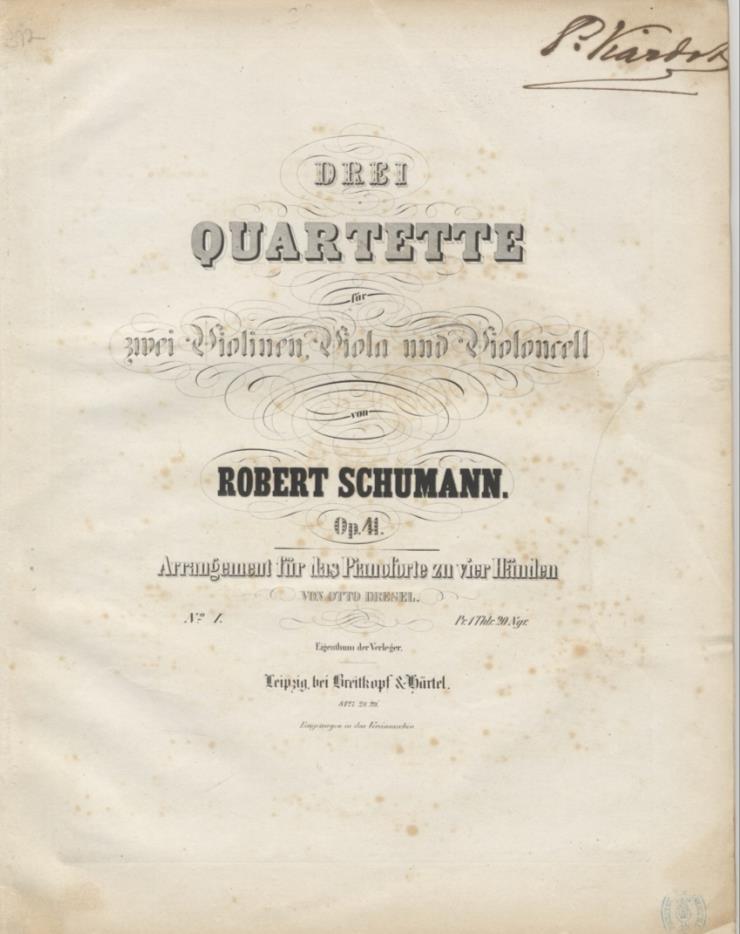
From the Collection of Noted French Mezzo-Soprano and Composer Pauline Viardot
57 SCHUMANN, Robert 1810-1856
Drei Quartette für zwei Violinen, Viola und Violoncell ... Op. 41. Arrangement für das Pianoforte zu vier Händen von Otto Dresel. No. 1. Pr.1 Thlr. 20 Ngr.
Leipzig: Breitkopf & Härtel [PN 8427], 1852.
Folio. Sewn. 1(title), 2-43, [i] (publisher's catalogue) pp. Title lithographed, music engraved. Small oval publisher's handstamp to lower outer corner of title. Some minor foxing and professional repairs; signature very slightly trimmed. In very good condition overall.
Provenance
French singer and composer, Pauline Viardot (1821-1910), with her autograph signature(P. Viardot")prominentlywritten in dark brown ink to upper outer corner of title.
First Edition of this arrangement. Hofmann p. 97. McCorkel p.184.
Viardot was a "French singer and composer of Spanish birth. ... [She] not only inspired composers such as Chopin, Berlioz, Meyerbeer, Gounod, Saint-Saëns, Liszt, Wagner and Schumann with her dramatic gifts but also collaborated on the composition of roles created especially for her...She met Clara Wieck and Schumann in Leipzig. (Schumann published one of her songs in his Neue Zeitschrift für Musik, and later dedicated his cycle of Heine songs op. 24 to her.)" Beatrix Borchard in Grove Music Online (40811) $900
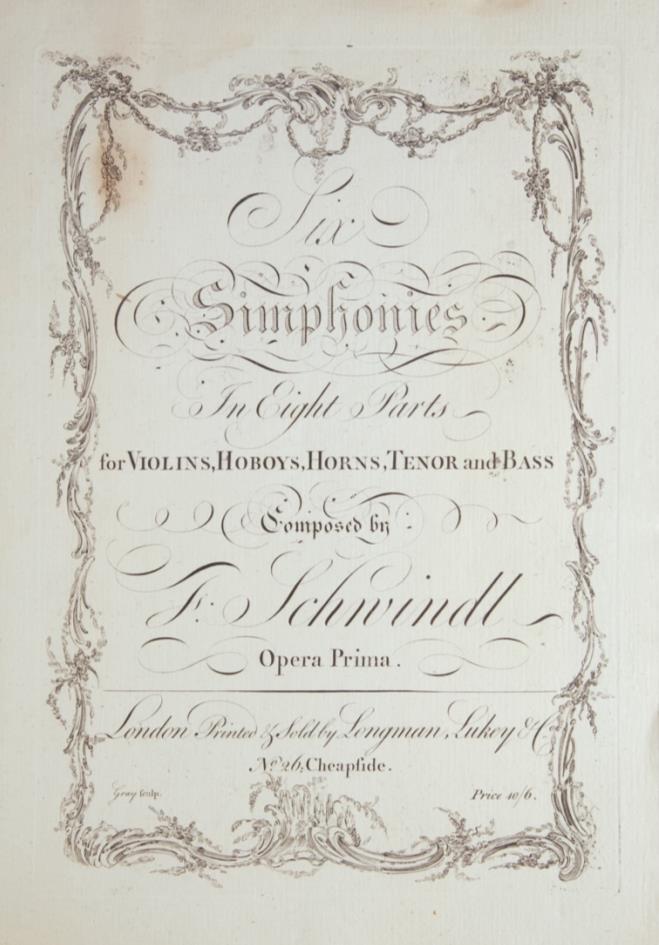
“Schwindl’s Maturing Style”
58 SCHWINDL, Friedrich 1737-1786
Six Simphonies in Eight Parts for Violins, Hoboys, Horns, Tenor, and Bass ... Opera Prima ... Gray sculp. ... Price 10/6. [Set of parts].
London: Longman, Lukey & Co., No. 26: Cheapside, [ca. 1775].
Folio. Contemporary plain wrappers with manuscript title labels to uppers. All titles within decorative floral borders. Engraved.
Violino primo: 1f. (recto title, verso blank), [i] (blank), 2-13, [i] (blank) pp.
Violino secondo: 1f. (recto title, verso blank), [i] (blank), 2-13, [i] (blank) pp.
Viola: 1f. (recto title, verso blank), [i] (blank), 213, [iii] (blank) pp.
Oboe primo: 1f. (recto title, verso blank), [i] (blank), 3-8 pp.
Oboe secondo: 1f. (rectotitle, verso blank), 3-8 pp. Corno primo: 1f. (recto title, verso blank), 2-6 pp. Corno secondo: 1f. (recto title, verso blank), 6 pp. Basso: 1f. (recto title, verso blank), [i] (blank), 213, [i] (blank) pp.
Wrappers worn, dampstained, and faded; spines frayed, that of Violino primo part lacking. Occasional signs of wear, small stains, foxing, and dampstaining. A very good copy overall.
Second edition. BUC p. 936. RISM S2548 and SS2548 (3 full sets of parts in the U.S., at Princeton, Eastman, and the Library of Congress).
Schwindl was a composer, violinist, and teacher, active in Germany, the Netherlands. and Switzerland. "[His] instrumental music enjoyed wide circulation, especially between the 1760s and 80s, when his symphonies and chamber works appeared in numerous publications. Records of performance also attest the popularity of his music: in Paris, the Concert Spirituel of 5 April 1767 began with a performance of one of his symphonies; a concert given at Nymphenburg (near Munich) during the summer of 1772 not only opened with two symphonies by Schwindl, but also included a performance of one of his trios, with the elector playing the bass viol; and a programme that began with Schwindl’s ‘Overture 1st’ was presented by Josiah Flagg in Boston on 17 May 1771.
Contemporary criticism was generally favourable. J.A. Hiller ranked Schwindl among those composers who had contributed worthwhile pieces to the symphonic repertory, while Burney found his name ‘well known in the musical world, by his admirable compositions for violins, which are full of taste, grace, and effects’. C.F.D. Schubart discussed the appeal of Schwindl’s music both to amateurs and to adherents of Empfindsamkeit.
Schwindl’s symphonies are scored mostly for eight parts (four strings with pairs of woodwind and horns). They include three- and four-movement structures (typically, Allegro–Andante–Minuet and Trio–Presto) which exhibit a variety of internal designs (e.g. sonata-form types with or without complete recapitulation). Viewed chronologically they reflect an increasingly expanded scope, made possible in the late works by a firm grasp of harmonic processes, broad control of phrasing, and by a heightened thematic specialization. Particularly significant are the symphonies in substantially revised versions (frequently with enlarged first movements and new, noticeably longer finales), which furnish cogent evidence of Schwindl’s maturing style." Anneliese Downs in Grove Music Online (40668) $700
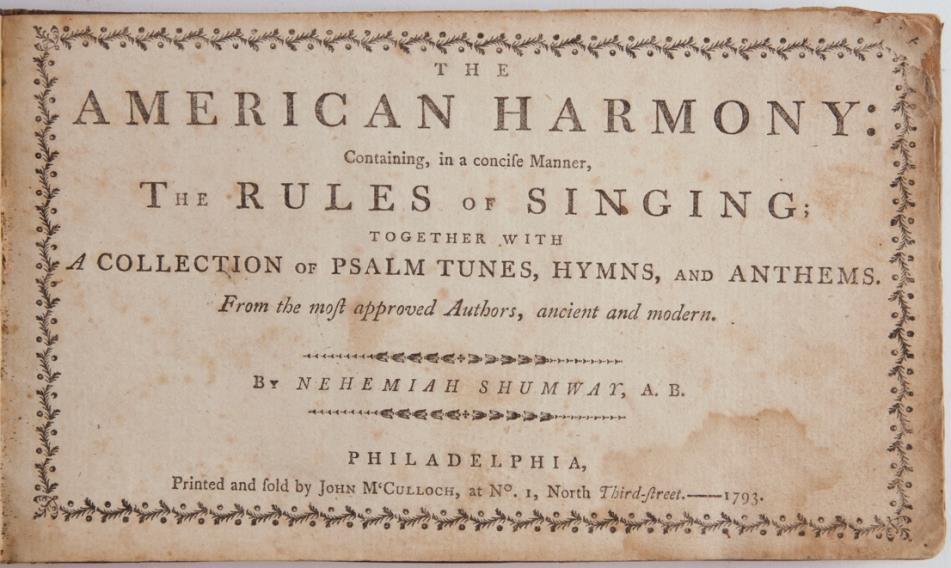
18
th Century American Tunebook
59 SHUMWAY, Nehemiah 1761-1843
The American Harmony: Containing, in a concise Manner, The Rules of Singing; Together with A Collection of Psalm Tunes, Hymns, and Anthems. From the most approved Authors, ancient and modern.
Philadelphia: Printed and sold by John McCulloch, at No. 1, North Third-Street, 1793.
Oblong octavo. Fullcontemporary darkbrown leather. 1f. (recto titlewithin decorative border, verso blank), [3]4 (Index), [5] (Preface) [6]-13 ("The Rules of Psalmody"), [14]-16 ("Observations on the Foregoing Rules"), [17]-18 ("General Observations on Singing"), 19-176, 181-212 pp. Complete, with pp. 177-180 omitted from pagination. With "Moses Willcocks his Book" in early manuscript to free front endpaper in both ink and pencil. Binding somewhat worn, rubbed, bumped, cracked, and stained; front hinge cracked; endpapers quite worn and browned, with minor loss to blank edges and some creasing, dampstaining, and small ink stains. Minor wear; lightto moderate browning; some foxingand show-through;occasional smallink and dampstains; severalleaves slightly trimmed, occasionally just touching headlines or page numbers; pp. 11-12 with paper loss to lower inner marginaffecting severalwords oftextto p. 12;upperoutercorner oftitleand followingleaf very slightdefective.
Contains 169 compositions in total, including 131 attributed American compositions, 47 of which are in the core repertory, many in first printings Attributions to Dr. Arne, Badcock, Benham (2), Billings (23), Brownson (6), Bull (3), Canfield, Carpenter (2), Chandler, Deolph (3), Edson (3), Fisher, French (12), Goff (2), Hall (2), Howes, King, Knop, Lee, Mann, Madan, Merrick, Milgrove, Morgan (2), Reed (15), Shumway (13), Stephenson (3), Stone (10), Strong (2), Swan (7), Tansur (3), Washburn, Weal, West (8), Williams (5), and Wood (7).
First Edition. Heard: American Music, p. 50. Hixon p. 467 [Evans no. 26162]. Metcalf: American Psalmody, p. 46. ASMI468. A second edition of the work was published in 1801.
"An interesting idea is the suggestion by means of testing tempos by swinging a leaden ball. Barbour evaluates Shumway's compositional characteristics in CMWB [The Church Music of William Billings]." Heard
Shumway, an American composer and teacher, was bornin Massachusetts andeducated at the College of Rhode Island (now Brown University), graduating in 1790. Two of his compositions, Judgement and Westminster, included in the present collection, continue to be included in 21st century collections. (40780) $1,950
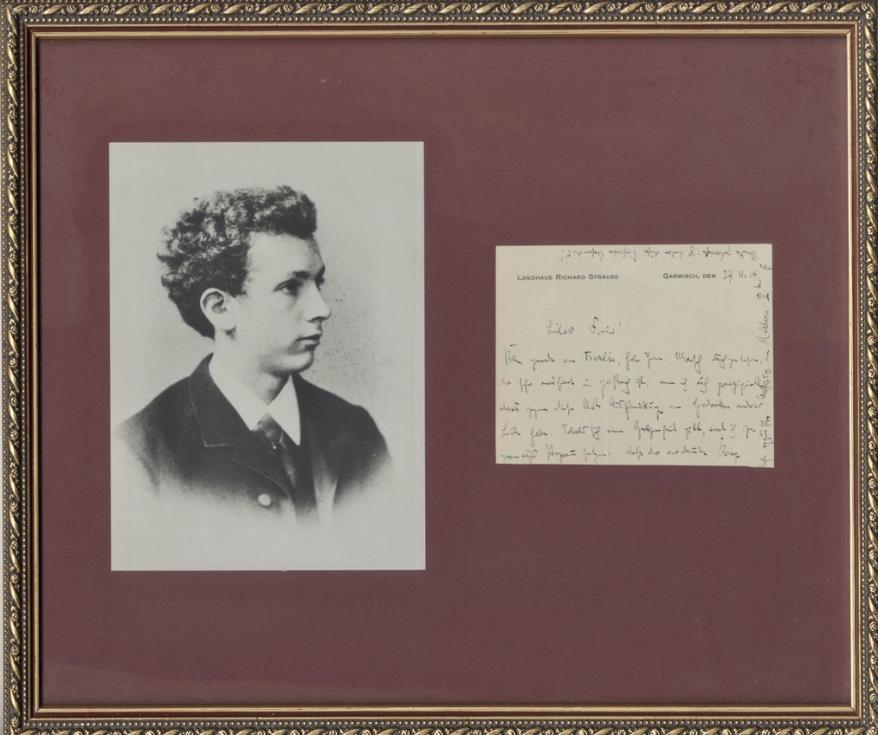
60 STRAUSS, Richard 1864-1949
Autograph letter to an unidentified male composer dated Garmisch 27.11.14 [November 27th 1914].
One page. Small quarto (91 x 11 cms). On personal stationery, with "Landhaus Richard Strauss Garmisch, den [27.11.14] printed to head. In black ink. Unsigned. Incomplete. Strauss has just come from Berlin and tells his correspondent that he has "read through" his march, which he found "very amusing and witty" even though he is "somewhat biased against such embellishment of the thoughts of other people." He goes on to say that he would be happy to program it "once an opportunity opens up." Strauss then makes reference to the "damned
war" and to an "exquisite performance of Mahler's 2nd," saying that he has "a special love for this symphony." Framed with a bust-length reproduction portrait of the composer as a very young man, without moustache, both items laid down to a burgundy mat, overall size 305 x 355 mm.
Mahler and Strauss "represent the late flowering of German Romanticism after Richard Wagner, in which pioneering subtleties of orchestration are combined with an advanced harmonic style. ... [They] came to know one another as young conductors in Leipzig in 1887. From then until Mahler’s death in 1911 (the year of the first performance of Der Rosenkavalier) they kept in touch. Mahler himself described their relationship as that of two miners tunneling from opposite directions with the hope of eventually meeting. [The] first publication of their correspondence, which includes twenty-five previously unknown Strauss letters, offers a portrait of two men who were as antithetical in their musical means and goals as in their temperaments and personalities, but who exercised a strong fascination for one another. These sixty-three letters show both composers advancing in their careers as they battled against adverse conditions in the musical world at the turn of the century. They present Mahler’s energetic support of Strauss’s Symphonia Domestica, which Mahler conducted in 1904 and, in turn, Strauss’s championing of Mahler’s music, especially the Second and Third Symphonies." Website of the Mahler Foundation
An interesting letter linking two giants of German Romanticism, demonstrating Strauss's high regard for Mahler (40981) $600

“A Profound Aesthetic and Stylistic Change”
61. TARTINI, Giuseppe 1692-1770
Sonate a violino e basso dedicate al Sr. Guiglielmo Fegeri ... Opera Seconda ... Antonius Cleton Scul: ... Superiorum permissu ... Altonious Cleton, Scul:
Romæ: Cleton, [1745].
Oblong folio. Contemporaryfulldarkbrownmottledcalfgiltornatecentraldeviceandcornerpieces gilt, marbled pastedowns, all edges gilt. 1f. (recto title within highly decorative border, verso blank), 1f. (recto dedication dated Padua, 30 June 1745, verso blank), [i](blank), 2-63, [i](blank) pp. music, including five blanks. Engraved. Binding slightly worn, rubbed, and bumped with a few small abrasions; free endpapers lacking. Minor internal wear; title slightly soiled and partially detached; light to moderate dampstaining throughout.
Contains 12 sonatas.
First Edition. Rare. Brainard p. xxxvi. BUC p. 996. Lesure p. 606. Wolffheim 1508. RISM A/I/8 T257.
"Even though, from the technical point of view, the Opus II Sonatas, published in Rome in 1745 by Cleton, cannot be considered less complicated or demanding than those of Opus I, printed 11 years earlier in Amsterdam, a profound aesthetic and stylistic change is nonetheless absolutely undeniable. ... The pathetic, dramatic or lyrical nature of certain slow movements often attains an expressive energy that might be defined as pre-Romantic. Elaborating his new language, Tartini grants an important place to the echoes of his country, folk music from the Slavic countries of the East and the ‘Schiavoni’ motifs and songs heard (or heard again) in the calli or on the canals of Venice. Tartini’s origins identify with the genetic heritage of his new music and, far from his fatherland, his maturation is completed to the point of recognising to the utmost his culture and destiny in the musical context of the period." Gatti: "The Middle of the World," notes accompanying the recording "Suonate a violino e violoncello o cimbalo Giuseppe Tartini." Arcana A 420 2020.
An attractive example of Italian music printing of the period (40585) $2,350
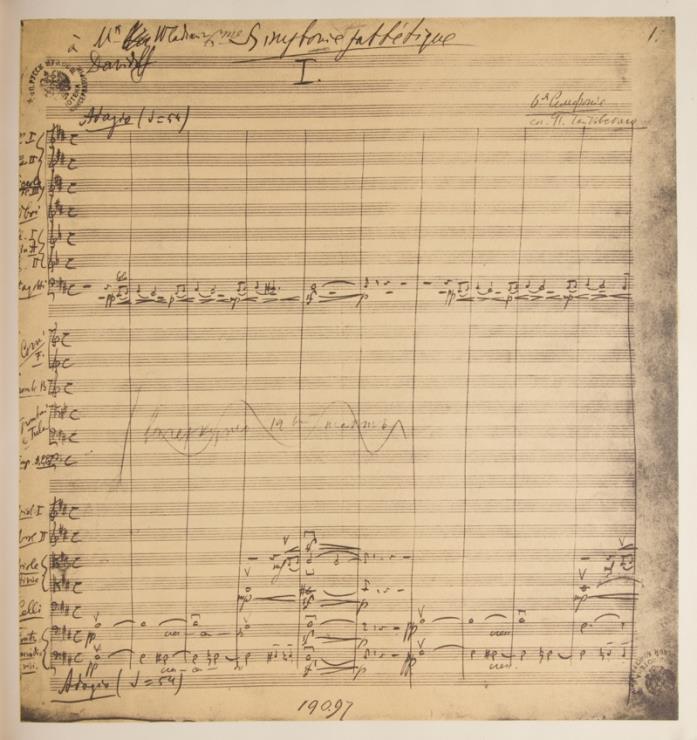
Facsimile of the 6th Symphony
62. TCHAIKOVSKY, Pyotr Il’yich 18401893
Sixth Symphony Pathétique. Facsimile of the autograph musical manuscript full score. Preface, research and commentary by Galina Pribegina.
Moscow: State Publishers Music, 1970.
Large quarto. Full dark brown cloth withtitling gilt. xvii, [i],139, [ii] pp. (40930) $300
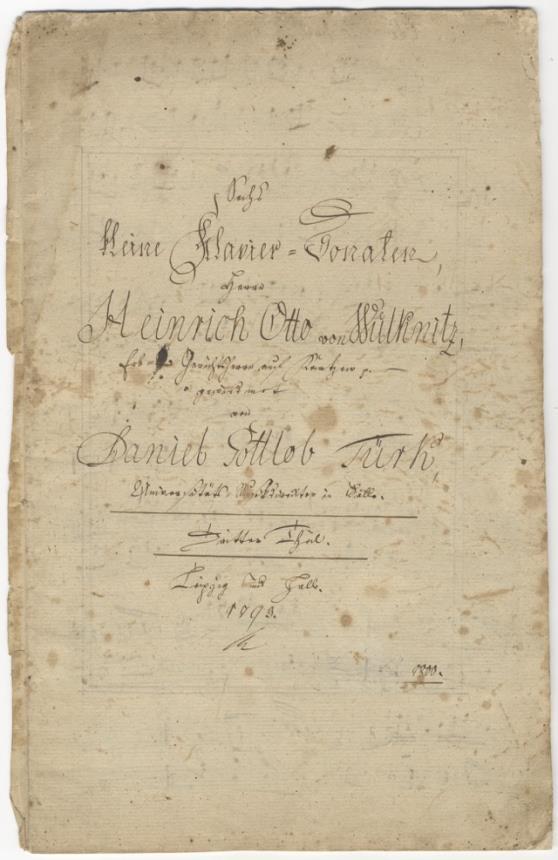
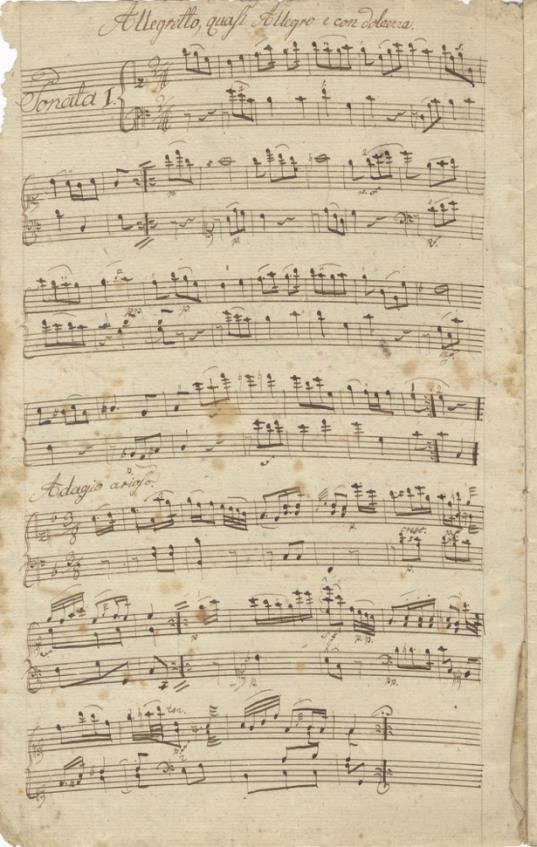
“Almost Unbounded Admiration from His Contemporaries”
63. TÜRK, Daniel Gottlob 1750-1813
Sechs kleine Klaviersonaten, herrn Heinrich Heinrich Otto von Wülcknitz Erb= und Gerichtsherrn auf Kartzow ec. ... Dritter Theil. [Copyist musical manuscript].
Germany, 1800.
Folio (218 x 343 mm). Sewn. Notated in black ink on 14-stave rastrum-ruled paper. [i] (title), 17 pp. Some browning; occasional soiling, foxing, and small stains; lower outer corners creased; light showthrough to final three leaves.
A scribal copy of Türk's third book of sonatas, 1793. The title reproduces the text found in the original edition of 1793; the present manuscript is also dated 1800 at foot of title.
Turk, a German theorist and composer, "took keyboard (clavichord) lessons in Leipzig from J.W. Hässler, a pupil of J.C. Kittel and therefore also in the tradition of J.S. Bach. He was taught according to C.P.E. Bach’s Versuch and introduced to that composer’s keyboard style. ... The 72-page auction catalogue of Türk’s extraordinarily comprehensive library (1816/R) bears witness to his wide reading and great scholarship, and the long article in Gerber’s Lexikon (1792) reflects an almost unbounded admiration from his contemporaries." Erwin R. Jacobi in Grove Music Online (40864) $325
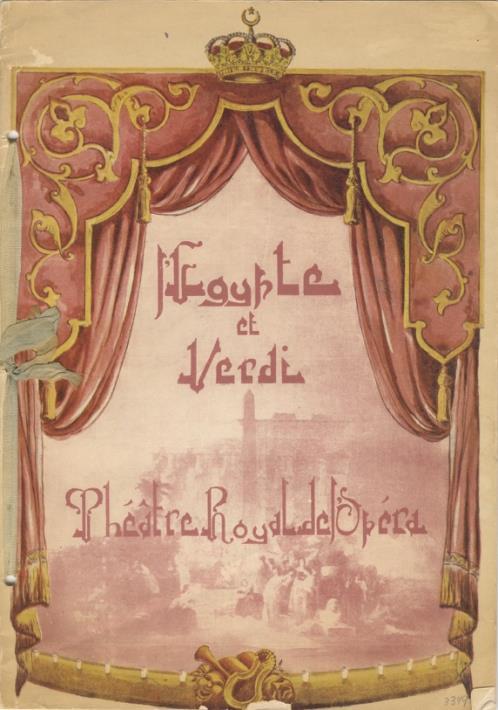
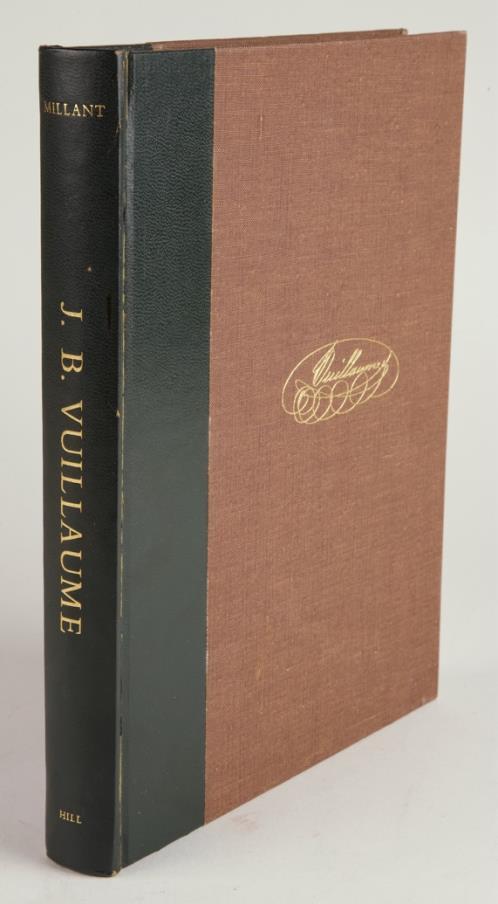
64. [VERDI, Giuseppe 1813-1901]
Egypte et Verdi. Théâtre Royal de l'Opéra. [Exhibition catalogue commemorating 80 years since the first performance of Aida in Cairo on 24 December 1871].
Cairo: La Société de Publications Egyptiennes, 25 January, 1951.
Folio. Decorative wrappers sewn with silk ribbon. 44 pp. Text in Arabic and French. With numerous photographic illustrations. Slightly worn; vertical crease from folding. (40923) $50
65 [VIOLIN]. Millant, Roger J. B. Vuillaume. Sa Vie et son Oeuvre.
London: W. E. Hill, 1972.
Small quarto. Original publisher's dark greent leather-backed brownclothboards. 1f. (rectoblank,versofrontispieceofan1865 Vuillaume violin in color), 207 pp. + 80 numbered plates reproducing rare violins, bows, documents, etc., some in color. Text in French, English, and German. Binding slightly worn. In very good condition overall.
First Edition (40875) $150
66. [VIOLIN]
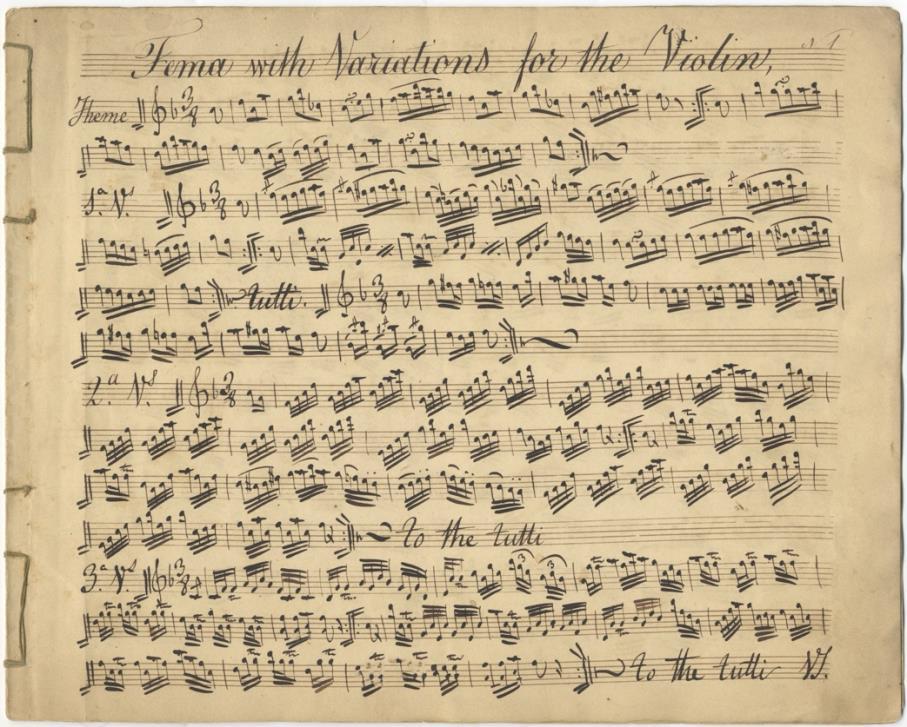
Virtuosic Studies for the Violin
Tema with Variations for the Violin. [Copyist musical manuscript]. England, ca. 1830.
Oblong folio (245 x 305 mm). Sewn. Notated in black and brown ink on 14-stave rastrum-ruled paper. 10 pp.
Contains five variation sets for violin by various composers:
1) Tema with Variations for the Violin 3 pp.
Nine variations on a waltz-like theme in F major. Following each variation the scribe indicates "tutti" or "to the tutti," indicating that these variations may have been performed with an ensemble of musicians. Unlocated.
2) Bishop, Sir Henry Rowley 1786-1855 and [?]Anon
Variations from Home Sweet Home 2 pp.
Five variations on Rowley's well-known song. Bishop was an English composer who, "in his day he enjoyed a commanding reputation as the guardian of the best traditions of English song, and for a time he kept English opera alive almost single-handed. Yet he is now remembered for little but the song Home, Sweet Home." Nicholas Temperley and Bruce Carr in Grove Music Online
3) Rode, Pierre 1774-1830
Theme with Variations for the Violin. 2 pp.
Four variations originally published as a solo for violin accompanied by a second violin, viola, and cello. "At the height of his career, Rode was the most finished representative of the French violin school. Having assimilated Viotti’s Classical approach, he imbued it with characteristically French verve, piquancy and a kind of nervous bravura. His artistic growth took place during the revolutionary decade, and it is not surprising that his music is akin to that of Cherubini and Méhul and the operas of the 1790s; there is declamatory pathos, martial dash and melting cantilena. His gift for lyrical, often melancholy melody, which represents a prominent trend in
French music of this period, made his music particularly attractive to German early Romantic composers. ... His innate gifts as a teacher are demonstrated in his 24 Caprices, which balance the musical and technical needs of the student and have become an indispensable part of the violin curriculum." Boris Schwarz, revised by Clive Brown in Grove Music Online
4) Gyrowetz, Adalbert 1763-1850
Variations 3 pp.
Eight variations by this noted Bohemian composer and conductor on a Tyrolean folksong, popular at the time and the subject of numerous variation sets.
5) Rossini, Gioachino 1792-1868
Variations from the Tanti Palpiti. 2 pp.
Five variations. The composer’s Di tanti palpiti was the subject of variation sets by celebrated composers including Paganini, Giuliani, and Gelinek. Unlocated.
Several smallstains, mainly toblankmargins; minor soilingto final page, mainlyaffectingits eight blank staves.
The variations by the composers represented in the present manuscript are virtuosic, incorporating rapid scales and arpeggios, passages in double stops, and bariolage. (40871)
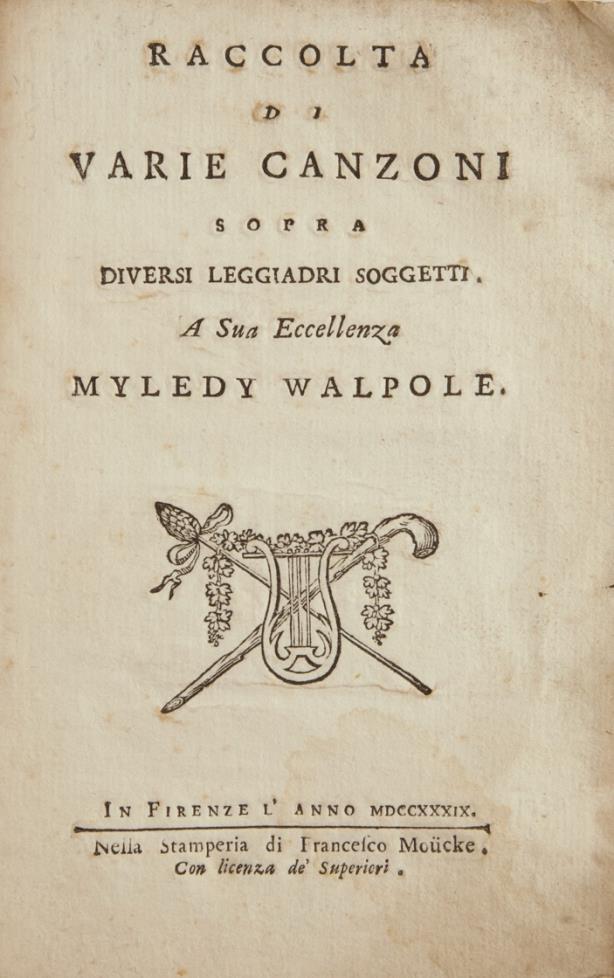
$350
Sole Source for These Six 18th Century Songs
67 [VOCAL MUSIC - 18th Century - Florentine]. Rigacci, Giuseppe, compiler Raccolta di Varie Canzoni Sopra Diversi Leggiadri Soggetti A Sua Eccellenza Myledy Walpole.
Firenze: Francesco Moücke, 1739.
Small octavo. Full contemporary carta rustica with manuscripttitling tospine. 1f. (recto title, verso blank), 1f. (recto blank, verso engraving by Carl L. Gregory after M. Tuscher), 3-6 (dedication), 7-8 ("Al lettore"), 9-71, [i] (blank), 73-99, [i] (blank), 101-128 pp. Music and poetry typeset. The engraving depicts two medallions, one with awomanin profilewithelaborate hairstyleandtheotherwithanowlholdingakeywithin a laurel. With occasional woodcut head- and tailpieces and historiatedinitials. Occasionalattributions to poets in contemporary manuscript; one word canceled on p. 5. Binding slightly worn, soiled, and stained, with minor loss to spine. Minor wear; light dampstaining to lower outer corners of most leaves; some gatherings split; final signature partially detached; small tear to upper right corner of title; minor loss to upper outer corner of p. 55. Quite a good crisp, wide-margined copy overall, despite defects as noted.
Contains numerous poems in Italian and Greek and six songs with unfigured bass line:
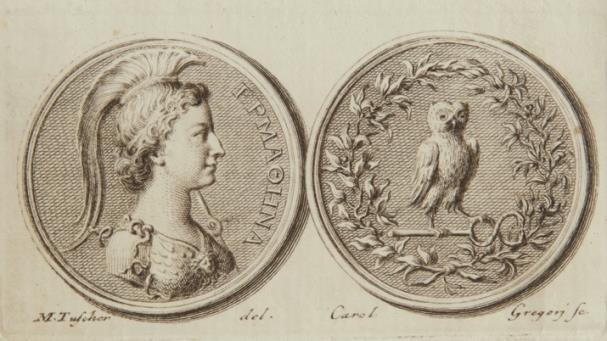
1) Orlandini, Giuseppe Maria 1676-1760. Grazie agl'inganni tuoi, pp. 9-15
2) Veracini, Francesco Maria 1690-1768. No Tirsi tu non hai quella, p. 23-29
3) [Caponi, Abate Raniero]. Dunque di sciolto, pp. 36-44
4) Arrigoni, Carlo 1697-1744 , pp. 61-67
5) Arrigoni. Doribel la graziosa, pp. [73]-78
6) Orlandini. Donne se avete in sen, pp. 101-105
First Edition. Apparently the sole source for these six songs. RISM Recueils II, p. 298.
Orlandini was a Florentine composer. "The large number and wide spread of performances of his operas confirm the opinions of Burney, La Borde, Martini and Quadrio that Orlandini was highly celebrated as a composer of dramatic music. He was best known for his comic intermezzos. ... Indeed, Orlandini’s Bacocco e Serpilla (under various titles and with added music by various composers) appears to have been the most frequently performed piece of musical drama in the entire 18th century." John Walter Hill and Francesco Giuntini in Grove Music Online
Veracini was an Italian composer and violinist. "There being no opera in London for the season of 1738–9, Veracini returned briefly to Florence where his uncle, wife and mother had died in his absence. Charles de Brosses heard him play there in 1739, and reported that ‘his playing is just, noble, knowledgeable and precise, but a little lacking in grace’. Burney concurred, writing (also from first hand) that ‘the peculiarities of his performance were his bow-hand, his shake, his learned arpeggios, and a tone so loud and clear, that it could be distinctly heard through the most numerous band of a church or theatre’. All agreed that he was the first, or at least one of the first, violinists of Europe On 28 February 1741 Veracini was back in London, playing a concerto between the acts of Handel’s Acis and Galatea." John Walter Hill in Grove Music Online
Arrigoni was an Italian lutenist, theorbo player, and composer, with close association to Florence. "By at least 1718 he was a member of the musicians’ company there. He is listed as a theorbo player at an oratorio performance on 31 March 1720 and as a violinist at a private concert on 30 July 1724, both in Florence. In 1721 he was elected a member of the Accademia Filarmonica of Bologna. His presence in London between 1731 and 1736 coincided with the lifespan of the Opera of the Nobility, rival to Handel’s company, which presented four performances of his Fernando beginning on 5 February 1734. In the 1732–3 season he directed concerts at Hickford’s Rooms, together with Giuseppe Sammartini, according to a newspaper announcement quoted by Burney. Other announcements mention his participation in London concerts on 20 April and 7 May 1733, 27 March and 11 April 1735, and 21 January, 5 March and 8 March 1736, either at Hickford’s Rooms or Lincoln’s Inn Fields. Arrigoni also sang and played his own music in Dublin on 20 October 1733. He sang the tenor part in Handel’s cantata Cecilia, volgi un sguardo and played the lute in Handel’s concerto op.4, no.6, both at original performances of Handel’s Alexander’s Feast at Covent Garden in February and March 1736 (see Dean). Later in 1736 he was made aiutante di camera by Grand Duke Giovanni Gastone of Tuscany, and in 1737 the new Grand Duke, Franz II, named him chamber composer." John Walter Hill in Grove Music Online
An attractive songbook, offering a fascinating glimpse of a cross-section of the Florentine cultural scene in the year 1739 (40719) $1,000
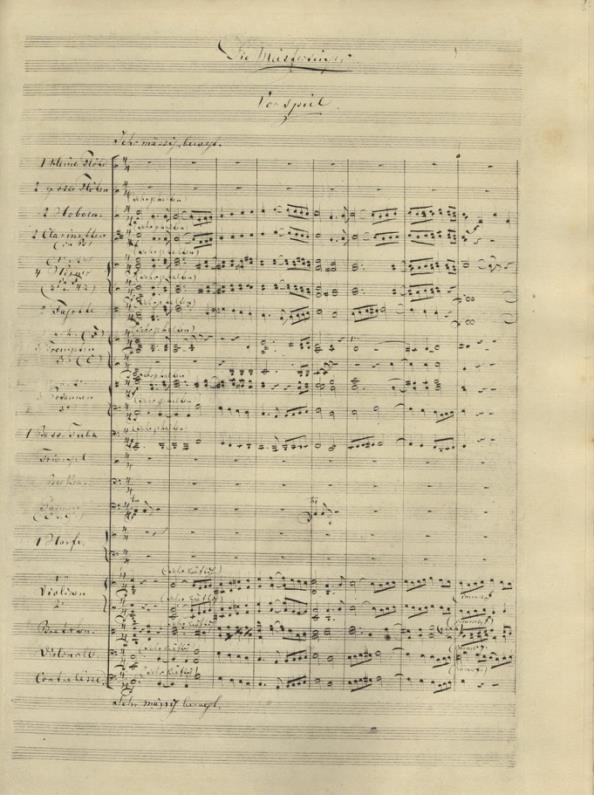
Limited Edition Facsimile of Die Meistersinger
68. WAGNER, Richard 1813-1883
Die Meistersinger Vorspiel. [Facsimile of the composer's autograph full score].
München: Drei Masken Verlag, 1923.
Folio. Marbled boards with leather title label gilt to upper. 23 pp. + 1f. (colophon) A facsimile of the autograph musical manuscript full score of the overture to the opera.
Limited to 530 copies. Scarce. (40929) $300
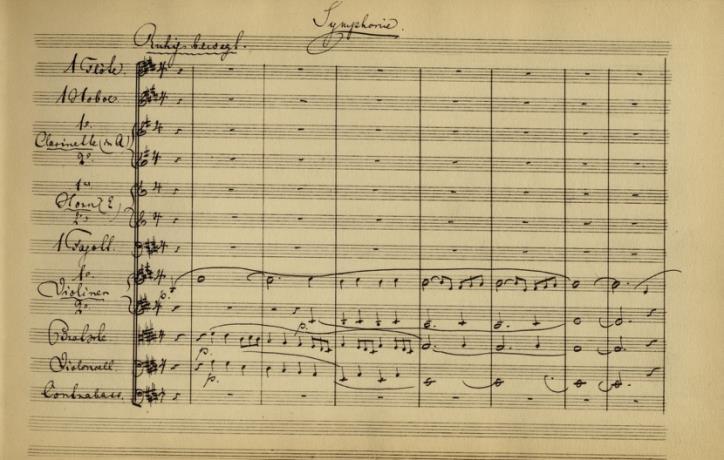
Facsimile of Siegfried Idyll
69 WAGNER, Richard 1813-1883
Tribschener Idyle mit Fidi-Vogelgesang und Orange-Sonnenaufgang, als Symphonischer Geburtstagsgruss Seiner Cosima dargebracht ... 1870. [Facsimile of the autograph score of Siegfried Idyll, WWV 103
[München]: [Drei Masken Verlag], [1923].
Oblong octavo. Original publisher's decorative dark pink boards with printed oval title label to upper. [ii], 39 pp. (facsimile), 1f. (colophon), 1f. (blank). Binding slightly worn.
The autograph was presented to the composer’s wife Cosima as a birthday present (40927) $135
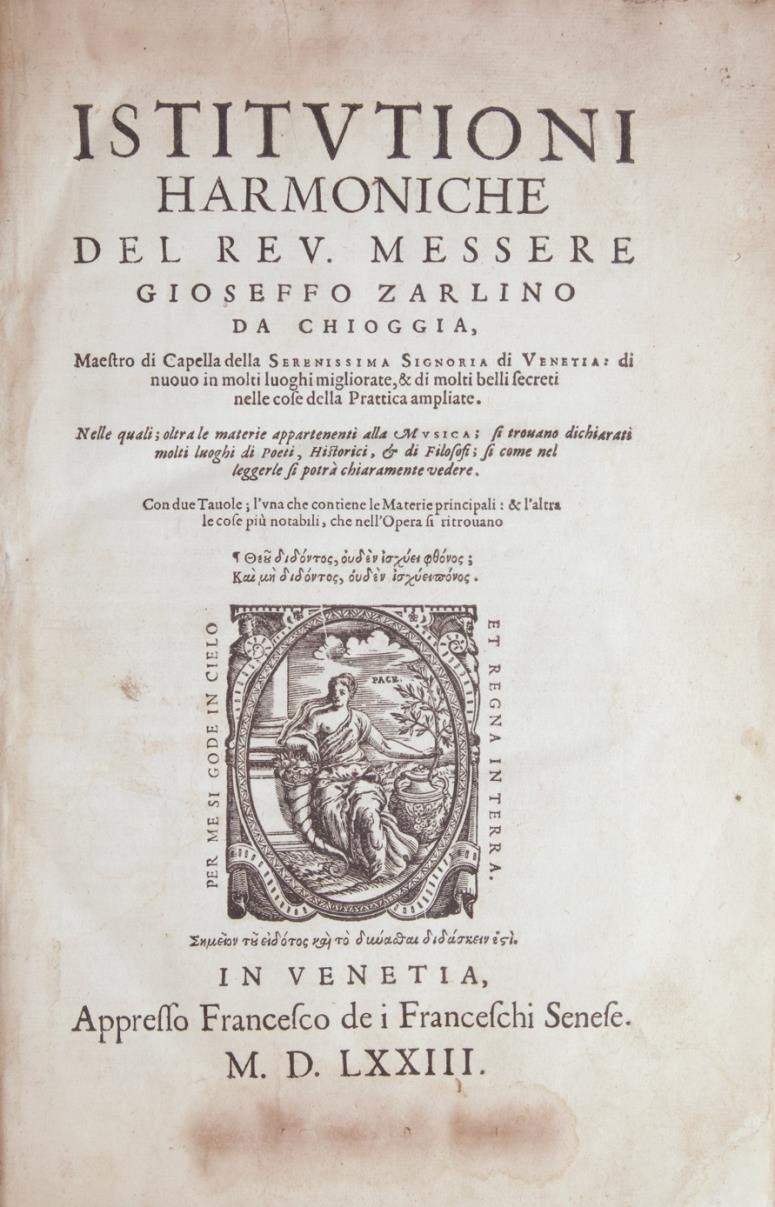
“A Landmark in the History of Music Theory”
70. ZARLINO, Gioseffo 1517-1590
Istitutioni Harmoniche ... Nelle quali; oltra le materie appartenenti alla Musica; si trovano dichiarati molti luoghi di Poeti, Historici, & di Filosofi; si come nel leggerle si potra chiaramente vedere. Con due Tavole
Venice: Apresso Francesco de i Franceschi Senese, 1573.
Small folio (290 x 205 mm). Full contemporary vellum with manuscript titling to spine. 1f. (recto title, verso blank), 1f. (dedication to Vincenzo Diedo Patriarca di Venetia), 3ff. ("Tavola Prima Di Tutte Le Materie Principali CheSono Contenute Nell'Opera"), 1f. (("Ai Lettori"), 428 pp. +10ff. ("SecondaTavola, Che Contiene Le Cose Piu Notabili Comprese Nell'Opera"). With numerous woodcut diagrams and decorative and historiated initials throughout. Music typeset in diamond-head notation. Binding slightly worn, soiled, and warped, with lettering in manuscript to lower edge and blind decoration to upper and outer edges; endpapers browned and slightly stained, with small label of noted antiquarian bookseller C.E. Rappaport in Rome to upper outer corner

of front pastedown. Light to moderate browning; edges slightly browned; some light foxing, primarily to blank margins; minor wear and soiling to title with several very small holes, not affecting text; gutter of title and blank lower margin with light brown stain, carrying through preliminary leaves, with similar staining to gutter of final leaves; very minor loss to blank margins of several leaves. Quite a nice, crisp, wide-margined copy overall.
With early markings and textual annotations, including some corrections, in brown ink and pencil to over 30 pages
Third edition, revised, written just two years after the publication of his Dimostrationi Harmoniche. Damschroder & Williams p. 392. Gregory-Bartlett I, p. 296. Cortot p. 208. Wolffheim I, 1120. Hirsch I, 625. RISM Écrits p. 908. First published in 1558 in an edition of 347 pp.
Zarlino "was a leading theorist of counterpoint in the 16th century. In his book Le istitutioni harmoniche, a landmark in the history of music theory, he achieved an integration of speculative and practical theory and established Willaert’s methods as models for contrapuntal writing. ...
Le istitutioni harmoniche (1558) is one of the most important works of music theory. Zarlino aimed in it to unite speculative theory with the practice of composition on the grounds that ‘music considered in its ultimate perfection contains these two parts so closely joined that one cannot be separated from the other’ (i, 2). The composer must not be content to master his craft; he should know the reason for what he does, and this can be discovered through an alliance of the rational and sensory faculties. The first two parts (they are designated ‘books’ in the 1573 edition) present the traditional curriculum of musica theorica from a fresh viewpoint. In part
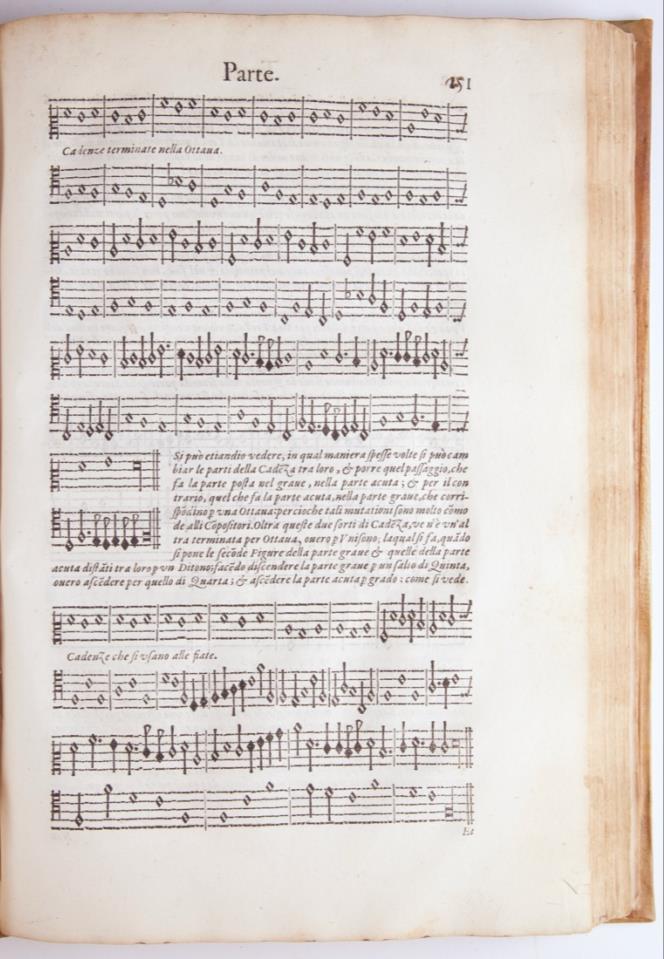

i Zarlino reviewed the philosophical, cosmological and mathematical basis of music. Part ii sets forth the Greek tonal system and supplants it with a modern theory of consonances and tuning. Zarlino synthesized critically a vast literature on music, philosophy, theology, mathematics and classical history and literature." Claude V. Palisca in Grove Music Online. (40922) $2,800
